History – 2020 A to L
SECTION 1 (FIRST AUTHOR A TO L)
THE FIRST FOUR ABSTRACTS ARE REVIEWS OF VARIOUS ASPECTS OF PROGRESS IN 2020
Kris De Boeck. Cystic fibrosis in the year 2020: A disease with a new face. Acta Paediatr 2020 May;109(5):893-899. doi: 10.1111/apa.15155.Epub 2020 Jan 22. [Pubmed]

Fig. 1 Kris De Boeck. gbiomed.kuleuven.be
The autosomal recessive disease cystic fibrosis (CF) was once untreatable and deadly in childhood, but now most patients survive to adulthood. Many countries have instituted CF newborn screening because early diagnosis improves outcome. CF research has greatly intensified following the discovery of the CF transmembrane conductance regulator (CFTR) gene, which has more than 2000 different mutations. For patients with common mutations like F508del, CFTR modulators are life transforming and may even prevent major complications if started early in childhood. For some patients with rare CFTR mutations, a treatment path still needs to be developed. Conclusion: This review provides a general update on CF, including screening and current and future treatment.
Prof. Kris De Boeck (fig.1) is at the Department of Pediatric Pulmonology, University Hospitals of Leuven, University of Leuven, Leuven, Belgium
Preeti B Sharma, Meghana Sathe, Adrienne P Savant. Year in Review 2020: Multisystemic impact of cystic fibrosis. Pediatr Pulmonol. 2021 Oct;56(10):3110-3119.doi: 10.1002/ppul.25584.Epub 2021 Jul 29. Full text. [Pubmed]

Fig. 2 Preeti Sharma
utswmed.org
Clinical care in cystic fibrosis (CF) has continued to advance over the last several years, particularly with the widespread eligibility and use of highly effective modulator therapy. Improved outcomes and longevity of persons with CF (PwCF) have increased recognition of the multisystem impact of the disease on the daily lives of PwCF. This review will cover a broad array of topics, from diagnosis to multisystem effects related to mental health, endocrine, palliative care, reproductive health, otolaryngology, and cardiac issues. Additionally, worldwide care delivery will be reviewed, demonstrating variation in outcomes based on resources and populations served. This review is part of the CF Year in Review 2020 series, focusing on the multi-system effects of CF. This review focuses on articles from Pediatric Pulmonology but also includes articles published in 2020 from other journals that are of particular interest to clinicians.
Preeti B Sharma (fig.2) is an associate professor in the Department of Pediatrics, Division of Pulmonary and Sleep Medicine, University of Texas Southwestern and Children’s Health, Dallas, Texas, USA
Meghana Sathe, Preeti B Sharma, Adrienne P Savant. Year in review 2020: Nutrition and gastrointestinal disease in cystic fibrosis. Pediatr Pulmonol 2021 Oct;56(10):3120-3125. doi: 10.1002/ppul.25587.Epub 2021 Jul 26.Full text link [Pubmed]

Feg. 3 Meghana Sathe ResearchGate
The multisystemic manifestations of cystic fibrosis (CF) involve all parts of the gastrointestinal (GI) system, including the pancreas, intestine, and liver. As providers who care for people with CF, knowledge of the manifestations, treatment, and research related to nutrition and GI disease are important. This review is the last installment of the CF year in review 2020 series, focusing on nutritional, GI, and hepatobiliary articles from Pediatric Pulmonology and other journals of particular interest to clinicians.
Dr Meghana Sathe (fig.3) is in the Division Gastroenterology, Hepatology, and Nutrition, Department of Pediatrics University of Texas Southwestern and Children’s Health, Dallas, Texas, USA.
Nicholas J Antos, Adrienne P Savant Cystic fibrosis year in review 2020: Section 2 pulmonary disease, infections, and inflammation. Pediatr Pulmonol 2022 Feb;57(2):347-360 doi: 10.1002/ppul.25459.Epub 2021 May 25. [Pubmed]

Fig. 4 Nicholas J Antos MD.com
The outlook for those with cystic fibrosis (CF) has never been brighter with ever increasing life expectancy and the approval of the highly effective CFTR modulators, such as elexacaftor/tezacaftor/ivacaftor. With that being said, the progressive pulmonary decline and importance of lung health, infection, and inflammation in CF remains. This review is the second part in a three-part CF Year in Review 2020. Part one focused on the literature related to CFTR modulators while part three will feature the multisystem effects related to CF. This review focuses on articles from Pediatric Pulmonology, including articles from other journals that are of particular interest to clinicians. Herein, we highlight studies published during 2020 related to CF pulmonary disease, infection, treatment, and diagnostics.
Nicholas J Antos (Fig.4) is in the Department of Pediatrics, Division of Pulmonary and Sleep Medicine, Medical College of Wisconsin, Milwaukee, Wisconsin, USA. and Department of Pediatric Pulmonology, Children’s Wisconsin, Milwaukee, Wisconsin, USA.
Adrienne P Savant is in the Department of Pediatrics, Children’s Hospital of New Orleans, New Orleans, Louisiana, USA.Department of Pediatrics, Tulane University, New Orleans, Louisiana, USA
==========================
Nature Outlook 29th July 2020 is devoted to Cystic fibrosis
The majority of the articles are written by professional scientific writers and clearly summarise a number of topical subjects.
- Herb Brody
- Sarah DeWeerdt
- Seven Rowe
- Elie Dolgin
- Elizabeth Svoboda
- Roaxanne Khamsi
- Jane Davies
- Benjamin Plackett
- Liam Drew
- David Altschuler
– Cystic fibrosis
Innovative therapies are bringing hope to people with this inherited lung disorder.
Herb Brody is chief supplements editor of Nature
Nature 2020 Jul;583(7818):S1. doi: 10.1038/d41586-020-02105-x. [Pubmed]
– Cystic fibrosis drugs target the malformed proteins at the root of the disease
New combinations of molecules put many patients on the path to good health. But those with rarer mutations are, for now, left behind.
Sarah DeWeerdt is a Freelance Science writer and editor Nature. 2020 Jul;583(7818):S2-S4. doi: 10.1038/d41586-020-02106-w.[Pubmed]
– A simple test could extend cystic-fibrosis treatments to those left behind
Sweat-chloride measurements could be used to develop and approve drugs for rare mutations in cystic fibrosis.
Steven M. Rowe professor and Director Cystic Fibrosis Research Center University of Birmingham Alabama
Nature. 2020 Jul;583(7818):S5. doi: 10.1038/d41586-020-02107-9. [Pubmed]
– In utero intervention to stem the damage of cystic fibrosis
To safeguard organs, therapies must tackle this hereditary disease in the womb.
Elie Dolgin is a freelance science writer, editor and podcaster (abstracted below)
In utero intervention to stem the damage of cystic fibrosis Nature 2020 Jul;583(7818):S6-S7.doi: 10.1038/d41586-020-02108-8. [Pubmed]
– Bacteria-eating viruses could provide a route to stability in cystic fibrosis
Phage therapy is broadening the treatment landscape for people with drug-resistant infections.
Elizabeth Svoboda is a writer in San Jose California Nature. 2020 Jul;583(7818):S8-S9. doi: 10.1038/d41586-020-02109-7. [Pubmed]
– Gene therapy could offer an inclusive cure for cystic fibrosis
After three decades of false starts, gene therapy against the disease is in new clinical trials — and there is even hope of a cure.Roxanne Khamsi is chief news editor of Nature Medicine in New York
Khamsi R. Nature. 2020 Jul;583(7818):S12-S14. doi: 10.1038/d41586-020-02111-z.[Pubmed]
– The coronavirus pandemic has forced rapid changes in care protocols for cystic fibrosis
Lockdowns have accelerated the drive towards telemedicine for people with cystic fibrosis — but the system needs critical appraisal.
Jane Davies is Professor paediatrics at Imperial College and Royal Brompton London Nature. 2020 Jul;583(7818):S15. doi: 10.1038/d41586-020-02112-y. [Pubmed]
– Living, breathing proof
A cadre of older patients with cystic fibrosis have defied the life expectancy associated with their illness. They’re inspiring and educating others about surviving with the disease long-term.
Roxanne Khamsi is chief news editor of nature medicine in New York
– How much protein function needs to be restored in cystic fibrosis?
Knowing the percentage of function that is required to eliminate disease symptoms could help to shape treatment in the coming years and ensure sufferers don’t slip through the net.
Benjamin Plackett is a science journalist in London and Middle East Nature. 2020 Jul;583(7818):S17. doi: 10.1038/d41586-020-02114-w.[Pubmed]
– Research round-up: Cystic fibrosis
Molecular pathways of inflammation, the cystic fibrosis microbiome and other highlights from clinical trials and laboratory studies.
Liam Drew is a writer covering medicine and biology Nature. 2020 Jul;583(7818):S18-S19. doi: 10.1038/d41586-020-02115-9.[Pubmed]
– Vertex Pharmaceuticals: Humanizing drug discovery
This article reviews the Vertex strategy to discover, develop and manufacture breakthrough medicines for people suffering with serious diseases.
David Altshuler is Executive Vice President, Global Research and Chief Scientific Officer at Vertex Pharmaceuticals Sponser feature
2020
B L Aalbers , R W Hofland , I Bronsveld , K M de Winter-de Groot , H G M Arets , A C de Kiviet , M M M van Oirschot-van de Ven, M A Kruijswijk, S Schotman, S Michel, C K van der Ent, H G M Heijerman. Females With Cystic Fibrosis Have a Larger Decrease in Sweat Chloride in Response to lumacaftor/ivacaftor Compared to Males. J Cyst Fibros 2020 May 21;S1569-1993(20)30135-1. [Pubmed]
A study to explore which patient-related factors influence sweat test response to CFTR modulators, as well as examining the correlation between the sweat chloride response and ppFEV1 or BMI response, using systematically collected real-life clinical data.
160 CF patients were identified who had used lumacaftor/ivacaftor (ORKAMBI) for at least six months. Of these patients, age, sweat chloride levels, ppFEV1 weight and BMI at the start of treatment and after 6 months were collected retrospectively. Pearson and Spearman tests were performed to assess correlations.
Results: Females compared to males in this group showed a larger response in sweat chloride (mean difference 10.6 mmol/l, 95% CI: 5.7-15.4) and BMI (mean difference 0.27 kg/m2, 95% CI: 0.01-0.54). A modest but significant correlation was found between patient weight and sweat chloride response (Pearson R = 0.244, p = 0.001), which diminished upon correction for the other factors. The correlation between sex and sweat chloride response remained; R = 0.253, p = 0.001. Sweat chloride response did not correlate with ppFEV1 change or BMI change at 6 months after start of therapy.
The authors concluded that the Sweat chloride response is larger in females compared to males, which also explains the negative correlation of weight with the response in sweat chloride concentration after start of lumacaftor/ivacaftor (ORKAMBI). Sweat chloride response does not correlate with the responses in ppFEV1and BMI.
This information may help the interpretation of sweat test results acquired for the follow up and evaluation of CFTR modulating treatments and warrants further investigation into the underlying mechanisms of sex differences in response to CFTR modulators.
Dr B L Aalbers is in the Department of Pulmonology, University Medical Center Utrecht, the Netherlands.
B L Aalbers , K M de Winter-de Groot , H G M Arets , R W Hofland , A C de Kiviet , M M M van Oirschot-van de Ven , M A Kruijswijk , S Schotman , S Michel , C K van der Ent , H G M Heijerman. Clinical Effect of lumacaftor/ivacaftor in F508del Homozygous CF Patients With FEV 1 ≥ 90% Predicted at Baseline. J Cyst Fibros. 2020 Jul;19(4):654-658.doi: 10.1016/j.jcf.2019.12.015. Epub 2020 Jan 7. [Pubmed]
Objective: The first available CFTR modulator combination for homozygous F508del patients, lumacaftor/ivacaftor (ORKAMBI) , has not been tested in patients with percentage predicted (pp)FEV1 > 90 in the phase III trials. The objective of this study is to share real life experience about treatment results in this group. In this retrospective observational study, patients aged 6 years or older starting on lumacaftor/ivacaftor in standard care were in strict follow up. For these patients, data were obtained about FEV1, BMI, CFQ-R and sweat chloride before start and after 6 months of treatment, and data about FEV1 and BMI were recorded every 3 months. Exacerbations were recorded continuously.
Results: They identified 40 patients with a ppFEV1 ≥ 90 at the start of lumacaftor/ivacaftor who had been in follow up for at least 12 months. After 12 months, ppFEV1 was unchanged, whereas mean absolute change in BMI was +0.88 (p = 0.001) with a mean change in SDS for BMI of +0.26 (p = 0.014). Mean CFQ-R overall score at 6 months improved by 2.6% (p = 0.004) and mean decrease in sweat chloride was -27.3 mEq/L (p = 0.000). Exacerbation rate declined from 1.03 to 0.53/person/year (p = 0.003). One patient discontinued treatment in the first 12 months because of progression of CFRLD, two paused treatment but resumed later.
Conclusion: Homozygous F508del patients starting lumacaftor/ivacaftor at ppFEV1 ≥ 90 improved significantly in nutritional status, sweat chloride levels and exacerbation rate, but did not respond in ppFEV1. Treatment is well tolerated in this patient group.
These effects make it worth considering to treat this group of patients with lumacaftor/ivacaftor.
Dr B L Aalbers is in the Department of Pulmonology, University Medical Center Utrecht, the Netherlands.
Mohammad Al-Haggar, Engy Osman, Abdel-Rahman Eid, Tarek Barakat, Samar El-Morsi. Screening for the Most Common Mutations of CFTRGene among Egyptian Children with Difficult-to-Treat Asthma. J Pediatr Genet. 2020 Sep;9(3):164-170.doi: 10.1055/s-0040-1701446. Epub 2020 Feb 3. [Pubmed]
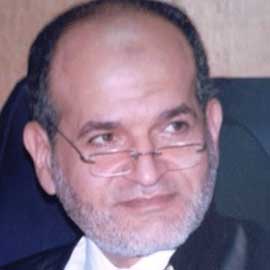
Fig. 5 Mohammad Al-Haggar
scimedpress.com
Cystic fibrosis (CF) is panethnic autosomal recessive disease that affects the exocrine glands of pancreas, lungs, and intestine. It is often misdiagnosed in developing countries as difficult-to-treat asthma. We enrolled 150 Egyptian families with one or more probands who were complaining of difficult-to-treat asthma, and 112 cases were studied extensively through history taking including pedigree construction and clinical examination. In addition, spirometry and computed tomography of the chest were done in selected cases. All cases were subjected to quantitative sweat chloride test and molecular screening for the three most common mutations of cystic fibrosis transconductance regulator ( CFTR ) gene ( ΔF508 , G542X , W1282X ) using amplification refractory mutation system (ARMS) technique.
Probands of difficult-to-treat asthma comprised 66 males and 46 females; their age range was 1 to 14 years. Sixty-one probands (54.5%) were carriers of one or more of the studied mutations (36 cases and 25 carriers). Six carriers of single mutations had mild respiratory symptoms and negative sweat test. The most common allele was ΔF508 , 60 alleles in 56 individuals (4 were homozygous ΔF508 / ΔF508 ) followed by W1282X in 25 individuals and G542X in 12 individuals. Allele W1282X had an increased risk of recurrent chest infection and bronchiectasis. Moreover, cases with two mutations had more severe symptoms compared with those with a single mutation.
CFTR mutations and CF-related syndromes are not rare as thought in Egypt, especially among the high-risk difficult-to-treat asthma. The readily available ARMS technique is recommended for ΔF508 and/or W1282X screening on priority basis among these children.
Mohammad Al-Haggar (fig.5) is Professor of Paediatrics and Genetics, Faculty of Medicine, Mansoura University, Mansoura, Egypt.
Albright JC, Houck AP, Pettit RS. Effects of CFTR modulators on pharmacokinetics of tobramycin during acute pulmonary exacerbations in the pediatric cystic fibrosis population [published online ahead of print, 2020 Jun 22]. Pediatr Pulmonol. 2020;10.1002/ppul.24917.

Fig. 6 Jared C Albright
LinkedIn
Individuals with cystic fibrosis (CF) require higher dosages of aminoglycosides due to an increased volume of distribution (Vd ) and clearance. Optimal dosing of aminoglycosides in the CF population is essential as repeated exposure to aminoglycosides during acute pulmonary exacerbations increases risk of nephrotoxicity and ototoxicity. To date, no studies have evaluated whether chronic CFTR modulator therapy affects pharmacokinetics of aminoglycoside antibiotics in CF patients. The objective of this study was to determine if the addition of a CFTR modulator affects elimination rate (Ke ) for intravenously administered tobramycin in the pediatric CF population
This retrospective study included patients aged 2 to 18 years with CF receiving chronic therapy with a CFTR modulator. Patients included had an admission both pre- and post-chronic CFTR modulator therapy during which they received therapy with IV tobramycin.
The pharmacokinetic parameters of intravenously administered tobramycin during admission for acute pulmonary exacerbation do not appear to change significantly after initiating chronic therapy with a CFTR modulator. Empiric dose adjustments for patients on CFTR modulators are not recommended.
— Valuable practical advice
Dr Jared C Albright (fig.6) is at the Riley Hospital for Children at IU Health, Indianapolis.
Allobawi R, Ghelani DP, Schneider-Futschik EK. Metabolomic Description of Ivacaftor Elevating Polymyxin B Mediated Antibacterial Activity in Cystic Fibrosis Pseudomonas aeruginosa. ACS Pharmacol Transl Sci. 2020;3(3):433-443. Published 2020 Apr 27. doi:10.1021/acsptsci.0c00030 [Pubmed]

Fig.7 Elena Schneider-Futschik biomedical sciences.unimelb.edu.au
We have demonstrated that ivacaftor displays synergistic antibacterial activity in combination with polymyxin B against polymyxin-resistant Pseudomonas aeruginosa that commonly colonizes the lungs of people with cystic fibrosis (CF). However, the underlying mechanism(s) remain unclear. In the present study, we employed untargeted metabolomics to investigate synergistic killing mechanism of polymyxin B in combination with ivacaftor against a polymyxin-susceptible P. aeruginosa FADDI-PA111 (polymyxin B MIC = 2 mg/L) and a polymyxin-resistant CF P. aeruginosaFADDI-PA006 (polymyxin B MIC = 8 mg/L). Metabolites were extracted at 3 h after treatments with polymyxin B alone (2 μg/mL for FADDI-PA111 and 4 μg/mL FADDI-PA006 P. aeruginosa), ivacaftor alone (8 μg/mL), and in combination. Polymyxin B monotherapy induced significant perturbations in the glycerophospholipid and fatty acid metabolism pathways against FADDI-PA111 and to a lesser extent in FADDI-PA006. In both strains, treatment with ivacaftor alone induced more pronounced perturbations in glycerophospholipid and fatty acid metabolism pathways than that with polymyxin B alone. This highlights the unique antimicrobial mode of action of ivacaftor. Pathway analysis revealed that in combination treatment, polymyxin B mediated killing is elevated by ivacaftor, largely due to the inhibition of cell envelope biogenesis via suppression of key membrane lipid metabolites (e.g., sn-glycerol 3-phosphate and sn-glycero-3-phosphoethanolamine) as well as perturbations in peptidoglycan and lipopolysaccharide biosynthesis. Furthermore, significant perturbations in the levels of amino sugars and nucleotide sugars, glycolysis, the tricarboxylic acid cycle, and pyrimidine ribonucleotide biogenesis were observed with the combination treatment.
These findings provide novel mechanistic information on the synergistic antibacterial activity of polymyxin-ivacaftor combination.
Elena Schneider-Futschik (fig.7) is Head of Laboratory at the Department of Pharmacology & Therapeutics, School of Biomedical Sciences, Faculty of Medicine, Dentistry and Health Sciences, The University of Melbourne, Parkville, Victoria 3010, Australia
Eric W F W Alton 1 2, A Christopher Boyd 2 3, Jane C Davies 1 2, Deborah R Gill 2 4, Uta Griesenbach 1 2, Tracy E Harman 1 2, Stephen Hyde 2 4, Gerry McLachlan 2 5 Gene Therapy for Respiratory Diseases: Progress and a Changing Context. Hum Gene Ther 2020 Sep;31(17-18):911-916.doi: 10.1089/hum.2020.142. Free full text [Pubmed]
- Eric Alton
- Christopher Boyd
- Jane Davies
- Deborah Gill
- Steve Hyde
- Uta Griesenbach
- Tracy Harman
- Gerry McLachan
The Gene Therapy Consortium (GTC) was formed in 2001 from three groups at the Universities of Edinburgh and Oxford and Imperial College, London to explore gene therapy as a therapeutic option for people with cystic fibrosis (CF). The gene responsible for CF, Cystic Fibrosis Transmembrane conductance Regulator (CFTR), was identified in 1989 and more than 2000 mutations are now known, typically classified into six groups.
The GTC has made substantial progress since they began working together 20 years ago. They have established proof- of-concept that repeated dosing of the CFTR gene to the lung can stabilize lung disease in a large, placebo- controlled double-blind Phase 2B trial. Their pseudotyped lentiviral program is partnered with both big pharma and arguably the world leaders in lentiviral manufacturing and is on target for a first-in-man trial. They have taken their experience in developing gene therapies for CF and are now applying it to other respiratory diseases. This progress has been made against the welcome changing context of CF lung disease, and this needs to be clearly recognized in the development of the next new therapy for CF. Earlier, they have outlined some of the issues and solutions they foresee as they look forward to introducing gene therapy into the CF therapeutic armoury.
(Modified from conclusions in the free full text of the article – which is recommended)
Affiliations are included to identify the various departments of those involved in this important UK collaboration.
1 Gene Therapy Group, National Heart and Lung Institute, Imperial College London, London, United Kingdom. 2 UK CF Gene Therapy Consortium, London, United Kingdom. 3 Centre for Genomic and Experimental Medicine, IGMM, University of Edinburgh, Edinburgh, United Kingdom. 4 Nuffield Division of Clinical Laboratory Sciences, Radcliffe Department of Medicine, University of Oxford, Oxford, United Kingdom. 5 The Roslin Institute & R(D)SVS, Easter Bush Campus, University of Edinburgh, Edinburgh, United Kingdom.
— This article discusses the present situation regarding the UK Gene Therapy Consortium, the many of whose members have been collaborating together in this area of research for over 20 years.
Margarida D Amaral, Margarida C Quaresma, Ines Pankonien.What Role Does CFTR Play in Development, Differentiation, Regeneration and Cancer?Int J Mol Sci 2020 Apr 29;21(9):E3133.doi: 10.3390/ijms21093133. [Pubmed]

Fig. 9 Margarida Quaresma ResearchGate

Fig. 8 Margarida Amaral ResearchGate
One of the key features associated with the substantial increase in life expectancy for individuals with CF is an elevated predisposition to cancer, firmly established by recent studies involving large cohorts. With the recent advances in cystic fibrosis transmembrane conductance regulator (CFTR) modulator therapies and the increased long-term survival rate of individuals with cystic fibrosis (CF), this is a novel challenge emerging at the forefront of this disease. However, the mechanisms linking dysfunctional CFTR to carcinogenesis have yet to be unravelled. Clues to this challenging open question emerge from key findings in an increasing number of studies showing that CFTR plays a role in fundamental cellular processes such as foetal development, epithelial differentiation/polarization, and regeneration, as well as in epithelial-mesenchymal transition (EMT).
Here, we provide state-of-the-art descriptions on the moonlight roles of CFTR in these processes, highlighting how they can contribute to novel therapeutic strategies. However, such roles are still largely unknown, so we need rapid progress in the elucidation of the underlying mechanisms to find the answers and thus tailor the most appropriate therapeutic approaches.
— A very interesting detailed and timely review of this important subject from Margarida Amaral’s laboratory.
Margarida Amaral (fig.8) is Professor of Molecular Biology at the Faculty of Sciences, University of Lisboa and Coordinator of BioISI research centre
Margarida Quaresma (fig.9) a medical writer and scientist from BioISI-Biosystems and Integrative Sciences Institute, Faculty of Sciences, University of Lisboa, 1749-016 Lisboa, Portugal.
Aoyama BC, Mogayzel PJ. Ivacaftor for the treatment of cystic fibrosis in children under six years of age. Expert Rev Respir Med. 2020 Mar 17:1-11. doi: 10.1080/17476348.2020.1741352. [Epub ahead of print] [Pubmed]

Fig. 10 Brianna C Aoyama
hopkinsmedicine.org
The authors reviewed the sentinel studies that lead to the approval of the use of ivacaftor in people with CF age six months and older with at least one CFTR gene mutation that is responsive to ivacaftor based on clinical trial and/or in vitro data. Children with CF have the greatest potential to benefit from CFTR modulator therapy when it is initiated prior to the development of permanent damage; however, challenges remain regarding use of ivacaftor in the youngest pediatric population.
Ivacaftor is safe and effective CFTR modulator that can be prescribed in children over six months of age with at least one CFTR gene mutation that is responsive to ivacaftor.
Brianna Clare Aoyama (fig.10) is assistant Professor of Pediatrics, Eudowood Division of Pediatric Respiratory Sciences, Johns Hopkins University School of Medicine, Baltimore,
Arnold CA, Burke AP, Calomeni E, Mayer RC, Rishi A, Singhi AD, Stashek K, Voltaggio L, Tondon R. Brown Bowel Syndrome: A Multi-institutional Case Series. Am J Surg Pathol. 2020 Jan 23. doi: 10.1097/PAS.0000000000001443. [Epub ahead of print][Pubmed]

Fig. 11 Christina Arnold The Pathologist
Brown bowel syndrome (BBS) is a rare condition associated with vitamin E deficiency and defined by prominent lipofuscin deposition in the muscularis propria. Eight unique cases of BBS were identified: 5 men and 3 women (mean age=58.6 y). Pertinent comorbidities included bariatric surgery=2, malnourishment=2, Crohn=2, cystic fibrosis=1, alcohol and cocaine abuse=1, and prior small bowel resections=1.
(Details are in the full summary)
BBS is important to recognize because it is linked with malnutrition, specifically vitamin E deficiency, and it can (rarely) clinically simulate malignancy. The diagnosis is based on the identification of the lipofuscin pigment in the cytoplasm of smooth muscle cells, which is most easily seen in the muscularis propria of the small bowel
Dr Christina A Arnold (f1g.11) is in the Department of Pathology, University of Colorado Anschutz Medical Campus, Aurora, CO.
— I had not heard of this and so included the abstract! Although there are a number of reported cases listed after the present PubMed abstract.
Ashcroft A, Chapman SJ, Mackillop L. The outcome of pregnancy in women with cystic fibrosis: a UK population based descriptive study. BJOG. 2020 Jul 19. doi: 10.1111/1471-0528.16423. Online ahead of print. [Pubmed]
All pregnant women with a diagnosis of cystic fibrosis who booked for antenatal care in a UK obstetric unit between March 2015 and February 2017. There were 71 pregnancies over a two-year period. There was one early miscarriage, four terminations and three sets of twins, resulting in the live birth of 69 infants. There were no maternal deaths. One infant died following spontaneous pre-term birth at 29 weeks gestation. The mean gestation at delivery was 36.2 completed weeks. The mean birthweight centile for gestational age was the 61st centile. We report a positive correlation between both maternal lung function (FEV1) and mean gestation at delivery, and between FEV1 and mean birthweight centile for gestational age.
The authors concluded pregnancy outcomes are generally good in women with cystic fibrosis. Successful pregnancy is possible even in those women with FEV1 <60% predicted although such women have higher chance of preterm delivery and a smaller baby
Dr Anna Ashcroft is at the Oxford University Hospitals NHS Foundation Trust.
Atteih SE, Raraigh KS, Blackman SM, Cutting GR, Collaco JM. Predictive effects of low birth weight and small for gestational age status on respiratory and nutritional outcomes in cystic fibrosis.
J Cyst Fibros. 2020 Feb 12. pii: S1569-1993(20)30048-5. doi: 10.1016/j.jcf.2020.02.003. [Epub ahead of print] [Pubmed]

Fig. 12 Michael Collaco hopkinscf.org
Prior literature shows that neonates with cystic fibrosis (CF) are more likely to be born low birth weight (LBW, <2500 grams) and/or small for gestational age (SGA, <10thpercentile for weight) than non-CF counterparts. There is limited literature exploring the predictive effects of birth parameters on long-term outcomes.The study population (CF Twin and Sibling Study) was recruited between 2000-2013 (n = 1677). Relationships between FEV1 percent predicted at 6, 12, or 18 years or BMI z-score at 2, 6, 12, or 18 years, and predictor variables (LBW or SGA status) were assessed using adjusted linear regressions.
Mean birth weight was 3.3 ± 0.7 kg (Females: 3.2 ± 0.7kg; males: 3.4 ± 0.7kg) and mean gestational age was 38.4 ± 2.6 weeks, with 10.2% of participants classified as SGA. Predictors of LBW included female sex, pancreatic insufficiency, and prematurity. Predictors of SGA included female sex. After adjustment, LBW was associated with lower BMI at ages 2-12 years and SGA was associated with lower BMI at age 2 years. LBW was associated with lower FEV1 percent predicted only at age 6 years. SGA was not associated with FEV1.
We did not observe higher rates of LBW or SGA in full term infants compared to the general population. We observed associations particularly between LBW and BMI or FEV1, but these associations decreased with age, suggesting that alternate factors contribute to outcomes over time. In lieu of the ability to target growth during gestation, efforts could be considered to optimize infant nutritional status, which may improve later life outcomes.
Dr Samar Atteih is a Third-Year Resident ta Johns Hopkins Children’s Center, Baltimore, MD, USA.
Dr J Michael Collaco (fig.12) is Associate Professor of Pediatrics at Johns Hopkins.
Andrew G Weber, Alice S Chau, Mikala Egeblad, Betsy J Barnes, Tobias Janowitz. Nebulized in-line endotracheal dornase alfa and albuterol administered to mechanically ventilated COVID-19 patients: A case series. medRxiv 2020 May 15;2020.05.13.20087734.doi: 10.1101/2020.05.13.20087734. Preprint Free article [Pubmed]

Fig. 13 Andrew G Weber
Loop (Frontiers)
Following nebulized in-line administration of dornase alfa with albuterol, the fraction of inspired oxygen requirements was reduced for all five patients. All patients remain alive and two patients have been discharged from the intensive care unit. No drug associated toxicities were identified
Conclusions. The results presented in this case series suggest that dornase alfa will be well-tolerated by critically ill patients with COVID-19. Clinical trials are required to formally test the dosing, safety, and efficacy of dornase alfa in COVID-19, and two have recently been registered (NCT04359654 and NCT04355364). With this case series, we hope to contribute to the development of management approaches for critically ill patients with COVID-19. See also.[Pubmed] for more detail
Dr Andrew G Weber (fig.13) is a Pulmonology and Critical Care Fellow in the Division of Pulmonary, Critical Care, and Sleep Medicine
Robert Bain, Rebecca Cosgriff, Marco Zampoli, Alexander Elbert, Pierre-Régis Burgel, Siobhán B Carr , Claudio Castaños, Carla Colombo, Harriet Corvol, Albert Faro, Christopher H Goss et al (19 others). Clinical characteristics of SARS-CoV-2 infection in children with cystic fibrosis: An international observational study. J Cyst Fibros. 2020 Dec 3;S1569-1993(20)30931-0.doi: 10.1016/j.jcf.2020.11.021.Online ahead of print. Free PMC article [Pubmed]
The presence of co-morbidities, including underlying respiratory problems, has been identified as a risk factor for severe COVID-19 disease. Information on the clinical course of SARS-CoV-2 infection in children with cystic fibrosis (CF) is limited, yet vital to provide accurate advice for children with CF, their families, caregivers and clinical teams.
Cases of SARS-CoV-2 infection in children with CF aged less than 18 years were collated by the CF Registry Global Harmonization Group across 13 countries between 1 February and 7 August 2020.
Results: Data on 105 children were collated and analysed. Median age of cases was ten years (interquartile range 6-15), 54% were male and median percentage predicted forced expiratory volume in one second was 94% (interquartile range 79-104). The majority (71%) of children were managed in the community during their COVID-19 illness. Out of 24 children admitted to hospital, six required supplementary oxygen and two non-invasive ventilation. Around half were prescribed antibiotics, five children received antiviral treatments, four azithromycin and one additional corticosteroids. Children that were hospitalised had lower lung function and reduced body mass index Z-scores. One child died six weeks after testing positive for SARS-CoV-2 following a deterioration that was not attributed to COVID-19 disease.
Conclusions: SARS-CoV-2 infection in children with CF is usually associated with a mild illness in those who do not have pre-existing severe lung disease
Robert Bain is in the Translational and Clinical Research Institute, Faculty of Medical Sciences, Newcastle University, Newcastle upon Tyne, United Kingdom.
— Reassuring data from many countries confirming the impression that SARS-CoV-2 is usually a relatively mild illness in CF children.
Elizabeth Baker , William T Harris, Steven M Rowe, Sarah B Rutland, Gabriela R Oates. Tobacco smoke exposure limits the therapeutic benefit of tezacaftor/ivacaftor in pediatric patients with cystic fibrosis. J Cyst Fibros 2020 Oct 3;S1569-1993(20)30870-5.doi: 10.1016/j.jcf.2020.09.011.Online ahead of print.[Pubmed]

Fig.14 Elizabeth Baker uab.edu
Objectives: Tobacco smoke exposure reduces CFTR functional expression in vitro and contributes to acquired CFTR dysfunction. We investigated whether it also inhibits the clinical benefit of CFTR modulators, focusing on tezacaftor/ivacaftor, approved in February 2018 for individuals with CF age ≥12 years.
Methods: A retrospective longitudinal analysis of encounter-based data from the CF Foundation Patient Registry (2016-2018) compared the slope of change in lung function (GLI FEV1% predicted) before and after tezacaftor/ivacaftor initiation in smoke-exposed vs unexposed age-eligible pediatric patients. Tobacco smoke exposure (Ever/Never) was determined from caregiver self-report. Statistical analyses used hierarchical linear mixed modeling and fixed effects regression modeling.
Results: The sample included 6,653 individuals with a total of 105,539 person-period observations. Tezacaftor/ivacaftor was prescribed to 19% (1,251) of individuals, mean age 17 years, mean baseline ppFEV1 83%, 28% smoke-exposed. Tezacaftor/ivacaftor users who were smoke-exposed had a lower baseline ppFEV1 and experienced a greater lung function decline. Over two years, the difference in ppFEV1 by smoke exposure among tezacaftor/ivacaftor users increased by 1.2% (7.6% to 8.8%, p<0.001). In both mixed effects and fixed effects regression models, tezacaftor/ivacaftor use was associated with improved ppFEV1 among unexposed individuals (1.2% and 1.7%, respectively; p<0.001 for both) but provided no benefit among smoke-exposed counterparts (0.3%, p = 0.5 and 0.6%, p = 0.07, respectively).
Conclusion: Tobacco smoke exposure nullifies the therapeutic benefit of tezacaftor/ivacaftor among individuals with CF aged 12-20 years old. To maximize the therapeutic opportunity of CFTR modulators, every effort must be taken to eliminate smoke exposure in CF.
Dr Elizabeth Baker Fig.14 is Associate Professor in the department of sociology at University of Alabama at Birmingham, Birmingham, AL, USA
I M Balfour-Lynn , J A King. CFTR Modulator Therapies – Effect on Life Expectancy in People With Cystic Fibrosis. Paediatr Respir Rev 2020 May 26;S1526-0542(20)30081-6. doi: 10.1016/j.prrv.2020.05.002. Online ahead of print. [Pubmed]

Fig.15 Ian Balfour-Lynn rbht.nhs.uk
CFTR modulators have dramatically changed the clinical course of CF in those fortunate enough to receive them. Inevitably, randomised controlled trials during the development of these drugs are too short to use mortality as an outcome. Evidence for their effect on life expectancy are best gained from real world registry studies specifically looking at mortality, but these are only available for ivacaftor to date. Therefore, indirect evidence must be obtained by looking at outcomes known to affect mortality and seeing the effect of these drugs on those outcomes.
Dr Ian Balfour-Lynn (fig.15) is a consultant paediatrician at the Royal Brompton Hospital, London.
Balfour-Lynn Ian. Environmental risks of Pseudomonas aeruginosa-What to advise patients and parents. J Cyst Fibros. 2020 Dec 12;S1569-1993(20)30937-1.doi: 10.1016/j.jcf.2020.12.005.Online ahead of print.[Pubmed]
Pseudomonas aeruginosa (PsA) is commonly found in soil and water so is impossible to avoid completely. Parents/carers of children with cystic fibrosis (CF) are concerned about them acquiring PsA from the environment, and different families view risk differently. Our ethos is to enable children with CF to take part as much as possible in educational and fun home activities, in order to maintain their quality of life (and their family’s), and not have them feel different from other children. This review presents advice for families as to what they must definitely avoid, what they must take precautions with but can allow, and what they must not avoid. It is mostly evidence-based, but where evidence is lacking it a consensus view from the Paediatric CF Unit at the Royal Brompton Hospital.
Dr Ian Balfour-Lynn(fig.15) is a consultant in the Dept of Paediatric Respiratory Medicine, Royal Brompton Hospital, London
— This is a useful extensive review but does not deal with the hospital environment and nosocomial infection, nor with medical equipment used in the home.
Jürg Barben, Carlo Castellani, Anne Munck, Jane C Davies, Karin deWinter, Silvia Gartner, Nataliya Kashirskaya, Barry Linnane, Sarah J Mayell, Susanna McColley, Chee Y Ooi, Marijke Proesmans, Clement L Ren. Danieli Salinas, Dorota Sands, Isabelle Sermet-Gaudelus, Olaf Sommerburg, Kevin W Southern, European CF Society Neonatal Screening Working Group (ECFS NSWG). Updated guidance on the management of children with cystic fibrosis transmembrane conductance regulator-related metabolic syndrome/cystic fibrosis screen positive, inconclusive diagnosis (CRMS/CFSPID). J Cyst Fibros 2020 Nov 27;S1569-1993(20)30909-7.doi: 10.1016/j.jcf.2020.11.006.Online ahead of print. [Pubmed]

Fig.16 Juerg Barben ECFS
Over the past two decades there has been considerable progress with the evaluation and management of infants with an inconclusive diagnosis following Newborn Screening (NBS) for cystic Fibrosis (CF). In addition, we have an increasing amount of evidence on which to base guidance on the management of these infants and, importantly, we have a consistent designation being used across the globe of CRMS/CFSPID. There is still work to be undertaken and research questions to answer, but these infants now receive more consistent and appropriate care pathways than previously.
It is clear that the majority of these infants remain healthy, do not convert to a diagnosis of CF in childhood, and advice on management should reflect this. However, it is also clear that some will convert to a CF diagnosis and monitoring of these infants should facilitate their early recognition. Those infants that do not convert to a CF diagnosis have some potential of developing a CFTR-RD later in life. At present, it is not possible to quantify this risk, but families need to be provided with clear information of what to look out for.
This paper contains a number of changes from previous guidance in light of developing evidence, but the major change is the recommendation of a detailed assessment of the child with CRMS/CFSPID in the sixth year of age, including respiratory function assessment and imaging. With these data, the CF team can discuss future care arrangements with the family and come to a shared decision on the best way forward, which may include discharge to primary care with appropriate information. Information is key for these families, and we recommend consideration of a further appointment when the individual is a young adult to directly communicate the implications of the CRMS/CFSPID designation.
Prof Jurg Barben (fig.16) at the Paediatric Pulmonology & CF Centre, Children’s Hospital of Eastern Switzerland, St. Gallen, Switzerland
Barreda CB, Farrell PM, Laxova A, Eickhoff JC, Braun AT, Coller RJ, Rock MJ. Newborn screening alone insufficient to improve pulmonary outcomes for cystic fibrosis. J Cyst Fibros. 2020 Jun 13:S1569-1993(20)30731-1. doi: 10.1016/j.jcf.2020.06.002. Online ahead of print.[Pubmed]

Fig. 17 Christina Barreda
The Wisconsin Cystic Fibrosis Neonatal Screening Project was a randomized clinical trial (RCT) revealing that children receiving an early diagnosis of CF via newborn screening (NBS) had improved nutritional outcomes but similar lung disease severity compared to those who presented clinically. Because the evaluations of these subjects by protocol ended in 2012, our objective was to assess long-term pulmonary and mortality outcomes.
Retrospective analysis of the RCT cohort utilized longitudinal outcome measures obtained from the Cystic Fibrosis Foundation Patient Registry (CFFPR). Data included screening assignment, clinical characteristics, percent predicted forced expiratory volume in 1 s (ppFEV1) and mortality. A random intercept model was used to compare the ppFEV1 decline of subjects between the two groups up to age 26 years. Mortality was analyzed using the Kaplan-Meier method.
Of the 145 subjects who consented to the original study, 104 subjects met inclusion criteria and had adequate data in the CFFPR. Of 57 subjects in the screened group and 47 in the control group, the rates of ppFEV1 decline were 1.76%/year (95% CI 1.62 to 1.91%) and 1.43%/year (95% CI 1.26 to 1.60%), respectively (p<0.0002). Pseudomonas aeruginosa acquired before 2 years was partially responsible. There was no difference in mortality between the two groups
Conclusions: NBS alone does not improve pulmonary outcomes in CF, particularly when other risk factors supervene. In an era prior to strict infection control and current therapies, NBS for CF may be associated with worse pulmonary outcomes.
Dr Christina B Barreda (fig.17) is a paediatrician in the Department of Pediatrics, University of Wisconsin-Madison School of Medicine and Public Health.
.Sara L Rassoulian Barrett, Elizabeth A Holmes, Dustin R Long, Ryan C Shean, Gilbert E Bautista, Sumedha Ravishankar, Vikas Peddu, Brad T Cookson, Pradeep K Singh, Alexander L Greninger, Stephen J Salipante. Cell Free DNA From Respiratory Pathogens Is Detectable in the Blood Plasma of Cystic Fibrosis Patients. 2020 Apr 23;10(1):6903.doi: 10.1038/s41598-020-63970-0. [Pubmed]

Fig 19 Stephen Salipante dlmp.uw.edu

Fig 18 Sara L Rassoulian Barrett
Diagnostically informative microbial cell-free DNA (cfDNA) can be detected from blood plasma during fulminant infections such as sepsis. However, the potential for DNA from airway pathogens to enter the circulation of cystic fibrosis (CF) patients during chronic infective states has not yet been evaluated.
The authors assessed whether patient blood contained measurable quantities of cfDNA from CF respiratory microorganisms by sequencing plasma from 21 individuals with CF recruited from outpatient clinics and 12 healthy controls. To account for possible contamination with exogenous microbial nucleic acids, statistical significance of microbe-derived read counts from CF patients was determined relative to the healthy control population.
In aggregate, relative abundance of microbial cfDNA was nearly an order of magnitude higher in CF patients than in healthy subjects (p = 8.0×10-3). 15 of 21 (71%) CF patients demonstrated cfDNA from one or more relevant organisms. In contrast, none of the healthy subjects evidenced significant microbial cfDNA for any of the organisms examined. Concordance of cfDNA with standard microbiological culture of contemporaneously collected patient sputum was variable.
The authors consider their findings provide evidence that cfDNA from respiratory pathogens are present in the bloodstream of most CF patients, which could potentially be exploited for the purposes of non-invasive clinical diagnosis.
Sara L Rassoulian Barrett (fig18) is in the Department of Laboratory Medicine, University of Washington, Seattle, WA, USA.
Stephen J Salipante (Fig 19) is a pathologist and Assistant professor of Laboratory Medicine in the Department of Laboratory Medicine, University of Washington, Seattle, WA, USA.
Jennifer A Bartell, Lea M Sommer, Rasmus L Marvig, Marianne Skov, Tacjana Pressler, Søren Molin, Helle Krogh Johansen. Omics-based tracking of Pseudomonas aeruginosa persistence in “eradicated” CF patients. Eur Respir J 2020 Oct 22;2000512. doi: 10.1183/13993003.00512-2020. Online ahead of print.[Pubmed]

Fig. 20 Jennifer Bartell heads.ku.dk
Whenever Pseudomonas aeruginosa (PA) is cultured from cystic fibrosis (CF) patient airways, the primary goal is eradication by antibiotic therapy. Success is defined by at least 6 months of negative bacterial airway cultures. However, we suspect that PA persists in airways without clinical detection for long periods. Of 298 PA-infected Copenhagen CF patients, we identified 80 with complete PA monitoring records and measured their maximum PA-free eradication periods (MEP). Isolates from 72 patients were whole genome sequenced (n=567) and clone typed. Select isolate relatedness was examined through phylogenetic analysis and phenotypic multivariate modelling.
Sixty-nine patients (86%) exhibited eradication in the monitoring period (2002-2018). Sequenced isolates bridged the MEP of 42 patients, and the same clone type persisted over the MEP in 18 (43%). Patients with failed eradication were on average treated more intensively with antibiotics, but this may be linked to their more severe pre-MEP infection trajectories. Of the 42 patients, 26 also had sinus surgery; the majority (15) show MEPs adjacent to surgery, and only 5 had persisting clone types. Importantly, combined phylogenetic-phenomic evaluation suggests that persisting clone types are a result of re-emergence of the same strain rather than re-infection from the environment, and similar relatedness is exhibited by paired lower and upper airway samples and in transmission cases.
In conclusion, nearly half of CF patients with supposed eradication may not truly be cleared of their original bacteria according to omics-based monitoring. This distinct cohort that is persistently infected would likely benefit from tailored antibiotic therapy.
Jennifer A Bartell (fig.20) is a Research Scientist at the Rigshospitalet Department of Clinical Microbiology, Copenhagen.
P Barth, P Bruijnzeel, A Wach, O Sellier Kessler, L Hooftman, J Zimmermann, N Naue, B Huber, I Heimbeck, D Kappeler, W Timmer, E Chevalier. Single dose escalation studies with inhaled POL6014, a potent novel selective reversible inhibitor of human neutrophil elastase, in healthy volunteers and subjects with cystic fibrosis J Cyst Fibros 2020 Mar;19(2):299-304.doi:10.1016/j.jcf.2019.08.020. Epub 2019 Sep. [Pubmed]
Background: POL6014 is a novel, orally inhaled neutrophil elastase (NE) inhibitor in development for cystic fibrosis (CF).
Methods: Two studies, one in healthy volunteers (HVs, doses 20 to 960 mg) and one in subjects with CF (doses 80 to 320 mg) were conducted to evaluate the safety, tolerability and pharmacokinetics (PK) of single ascending doses of inhaled POL6014 with a Pari eFlow® nebuliser. PK was evaluated over a period of 24 h. In addition, NE activity in CF sputum was measured.
Results: After single doses, POL6014 was safe and well tolerated up to 480 mg in HVs and at all doses in subjects with CF. POL6014 showed a dose-linear PK profile in both populations with Cmaxbetween 0.2 and 2.5 μM in HVs and between 0.2 and 0.5 μM in subjects with CF. Tmax was reached at approximately 2-3 h. Mean POL6014 levels in CF sputum rapidly reached 1000 μM and were still above 10 μM at 24 h. >1-log reduction of active NE was observed at 3 h after dosing.
Conclusion: Inhalation of POL6014 can safely lead to high concentrations within the lung and simultaneously low plasma concentrations, allowing for a clear inhibition of NE in the sputum of subjects with CF after single dosing..
Dr O Sellier Kessler is the corresponding author at: Santhera Pharmaceuticals, Hohenrainstrasse 24, 4133
Bartley BL, Gardner KJ, Spina S, Hurley BP, Campeau D, Berra L, Yonker LM, Carroll RW. High-Dose Inhaled Nitric Oxide as Adjunct Therapy in Cystic Fibrosis Targeting Burkholderia multivorans. Case Rep Pediatr. 2020 Jun 24;2020:1536714. doi: 10.1155/2020/1536714. eCollection 2020. Free PMC article.[Pubmed]

Fig. 21 Bethany L Bartley sleep.hms.harvard.edu
Background: Individuals with cystic fibrosis (CF) have persistent lung infections, necessitating the frequent use of antibiotics for pulmonary exacerbations. Some respiratory pathogens have intrinsic resistance to the currently available antibiotics, and any pathogen may acquire resistance over time, posing a challenge to CF care. Gaseous nitric oxide has been shown to have antimicrobial activity against a wide variety of microorganisms, including common CF pathogens, and offers a potential inhaled antimicrobial therapy. Case Presentation. Here, we present the case of a 16-year-old female with CF who experienced a precipitous decline in lung function over the prior year in conjunction with worsening antibiotic resistance of her primary pathogen, Burkholderia multivorans. She received 46 intermittent inhalations of 160 parts-per-million nitric oxide over a 28-day period. The gas was administered via a mechanical ventilator fitted with nitrogen dioxide scavenging chambers.
Conclusions: High-dose inhaled nitric oxide was safe, well tolerated, and showed clinical benefit in an adolescent with cystic fibrosis and pulmonary colonization with Burkholderia multivorans. Inhaled high-dose NO therapy, utilized as an anti-infective adjunct therapy, improved pathogen antibiotic resistance patterns and clinical outcomes in our patient. Inhaled high-dose NO therapy, utilized as an anti-infective adjunct therapy, improved pathogen antibiotic resistance patterns and clinical outcomes in our patient. Mechanistic studies in vitro and larger randomized controlled clinical trials are needed to better understand the bactericidal efficacy and biofilm dispersal properties of high-dose NO on B. multivorans. To our knowledge, this is the first report of high-dose inhaled NO therapy in an individual with CF and pulmonary colonization with B. multivorans. In follow-up, the patient continues to require frequent courses of antibiotics for pulmonary exacerbations though much less frequent inpatient admissions. During inpatient stays, we continue to offer high-dose inhaled NO therapy as an adjunct therapy to intravenous antibiotics. The patient’s genotype qualifies for the newly available, highly effective, triple combination CFTR modulator, elexacaftor-ivacaftor-tezacaftor (Vertex Pharmaceuticals) which has improved her lung function but has not yet altered her sputum microbiota. Recalcitrant infection with multidrug-resistant pathogens will likely continue to be a major problem in CF despite the advent of CFTR modulators , and high-dose inhaled NO may help those who continue to struggle with difficult to treat respiratory pathogens.
Dr Bethany L Bartley (fig 21) is at the Department of Pediatric Pulmonology, Massachusetts General Hospital, 55 Fruit Street, Boston, MA 02114, USA
Melanie M Beasley, Clare K Remy. Can we identify cystic fibrosis (CF) from skeletal remains?: A proposed differential diagnosis. Anat Rec (Hoboken) 2020 Dec 5. doi: 10.1002/ar.24576. Online ahead of print. [Pubmed]

Fig. 23 Clare Remy Pinterest
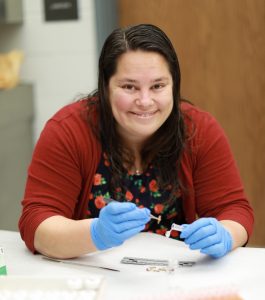
Fig. 22 Melanie Beasley cla.perdue.edu
With recent medical advancement, the life span of CF patients has been extended by decades and bone disease has been observed as a common complication of long-term survivors. In addition to bone disease and associated bone fracturing, living CF patients have a unique etiology of chronic sinusitis, which manifests as a medial bulge in the lateral walls of the nasal aperture, distinct from non-CF chronic sinusitis. We suggest that available data from medical literature is sufficient evidence to indicate that CF can be identified during skeletal analysis, but future work is needed to quantify the sensitivity of the lesions for confirming a CF diagnosi
Dr Melanie M Beasley (fig.22) is Assistant Professor in the Dept of Anthropology, Purdue University, West Lafayette, Indiana.
Dr Clare K Remy (fig.23) is Supplemental Instructor and Tutor in the Dept of Anthropology, University of Tennessee-Knoxville, Knoxville, Tennessee.
— This is interesting and the apparently characteristic medial bulging of the lateral sinonasal sidewall could be used to identify CF bones
Bell SC, Mall MA, Gutierrez H, Macek M, Madge S, Davies JC, Burgel PR, Tullis E, Castaños C, Castellani C, Byrnes CA, Cathcart F, Chotirmall SH, Cosgriff R, Eichler I, Fajac I, Goss CH, Drevinek P, Farrell PM, Gravelle AM, Havermans T, Mayer-Hamblett N, Kashirskaya N, Kerem E, Mathew JL, McKone EF, Naehrlich L, Nasr SZ, Oates GR, O’Neill C, Pypops U, Raraigh KS, Rowe SM, Southern KW, Sivam S, Stephenson AL, Zampoli M, Ratjen F. The Future of Cystic Fibrosis Care: A Global Perspective. Lancet Respir Med Jan 2020;8(1): 65-124 [Pubmed]

Fig. 25 Felix Ratjen

Fig. 24 Scott Bell
The past six decades have seen remarkable improvements in health outcomes for people with cystic fibrosis, which was once a fatal disease of infants and young children. However, although life expectancy for people with cystic fibrosis has increased substantially, the disease continues to limit survival and quality of life, and results in a large burden of care for people with cystic fibrosis and their families. Furthermore, epidemiological studies in the past two decades have shown that cystic fibrosis occurs and is more frequent than was previously thought in populations of non-European descent, and the disease is now recognised in many regions of the world. The Lancet Respiratory Medicine Commission on the future of cystic fibrosis care was established at a time of great change in the clinical care of people with the disease, with a growing population of adult patients, widespread genetic testing supporting the diagnosis of cystic fibrosis, and the development of therapies targeting defects in the cystic fibrosis transmembrane conductance regulator (CFTR), which are likely to affect the natural trajectory of the disease. The aim of the Commission was to bring to the attention of patients, health-care professionals, researchers, funders, service providers, and policy makers the various challenges associated with the changing landscape of cystic fibrosis care and the opportunities available for progress, providing a blueprint for the future of cystic fibrosis care. The discovery of the CFTR gene in the late 1980s triggered a surge of basic research that enhanced understanding of the pathophysiology and the genotype-phenotype relationships of this clinically variable disease. Until recently, available treatments could only control symptoms and restrict the complications of cystic fibrosis, but advances in CFTR modulator therapies to address the basic defect of cystic fibrosis have been remarkable and the field is evolving rapidly. However, CFTR modulators approved for use to date are highly expensive, which has prompted questions about the affordability of new treatments and served to emphasise the considerable gap in health outcomes for patients with cystic fibrosis between high-income countries, and low-income and middle-income countries (LMICs). Advances in clinical care have been multifaceted and include earlier diagnosis through the implementation of newborn screening programmes, formalised airway clearance therapy, and reduced malnutrition through the use of effective pancreatic enzyme replacement and a high-energy, high-protein diet. Centre-based care has become the norm in high-income countries, allowing patients to benefit from the skills of expert members of multidisciplinary teams. Pharmacological interventions to address respiratory manifestations now include drugs that target airway mucus and airway surface liquid hydration, and antimicrobial therapies such as antibiotic eradication treatment in early-stage infections and protocols for maintenance therapy of chronic infections. Despite the recent breakthrough with CFTR modulators for cystic fibrosis, the development of novel mucolytic, anti-inflammatory, and anti-infective therapies is likely to remain important, especially for patients with more advanced stages of lung disease. As the median age of patients with cystic fibrosis increases, with a rapid increase in the population of adults living with the disease, complications of cystic fibrosis are becoming increasingly common. Steps need to be taken to ensure that enough highly qualified professionals are present in cystic fibrosis centres to meet the needs of ageing patients, and new technologies need to be adopted to support communication between patients and health-care providers. In considering the future of cystic fibrosis care, the Commission focused on five key areas, which are discussed in this report: the changing epidemiology of cystic fibrosis (section 1); future challenges of clinical care and its delivery (section 2); the building of cystic fibrosis care globally (section 3); novel therapeutics (section 4); and patient engagement (section 5). In panel 1, we summarise key messages of the Commission. The challenges faced by all stakeholders in building and developing cystic fibrosis care globally are substantial, but many opportunities exist for improved care and health outcomes for patients in countries with established cystic fibrosis care programmes, and in LMICs where integrated multidisciplinary care is not available, and resources are lacking at present. A concerted effort is needed to ensure that all patients with cystic fibrosis have access to high-quality health care in the future.
Scott Bell and Felix Ratjen coordinated the Commision and reviewed and edited all sections of the paper.
Prof. Scott Bell (fig.24) of the Department of Thoracic Medicine, The Prince Charles Hospital, Brisbane, QLD, Australia; QIMR Berghofer Medical Research Institute, Brisbane, QLD, Australia. Previous editor of the JCF.
Prof. Felix Ratjen (fig.25) of the Division of Respiratory Medicine, Department of Paediatrics Translational Research Programme, Hospital for Sick Children, University of Toronto, Toronto, Canada
— This really impressive article by 38 of the world’s experts with 522 references can be unreservedly recommended for anyone who wishes a detailed comprehensive readable review of the subject.
Siân Bentley , Jane C Davies , Siobhán B Carr , Ian M Balfour-Lynn Combination Antifungal Therapy for Scedosporium Species in Cystic Fibrosis. . 2020 Apr 27.doi: 10.1002/ppul.24789. Online ahead of print. [Pubmed]

Fig. 26 Sian Bentley Royal Brompton Hospital
A study to evaluate safety and efficacy of oral posaconazole and terbinafine for Lomentospora prolificans and Scedosporium apiospermum in children with cystic fibrosis. There were five children (four girls), median age 15.0 years; three had S. apiospermum and two had L. prolificans. Treatment duration: median 5 months (range: 5-18 m). In no patient was eradication achieved, with the follow-up range being 6 months to 4 years. Effect on lung function was variable but encouraging. No adverse effects were reported, one child had transient elevation of liver enzymes.
The authors concluded while the combination therapy was well tolerated, it was unsuccessful at eradication
Sian Bentley (fig.26) is Lead Pharmacist, Paediatrics, Royal Brompton and Harefield NHS Foundation Trust, London
Bentur L, Gur M, Ashkenazi M, Livnat-Levanon G, Mizrahi M, Tal A, Ghaffari A, Geffen Y, Aviram M, Efrati O. Pilot study to test inhaled nitric oxide in cystic fibrosis patients with refractory Mycobacterium abscessus lung infection. J Cyst Fibros. 2020 Mar;19(2):225-231. doi: 10.1016/j.jcf.2019.05.002. Epub 2019 May 23.PMID: [Pubmed]

Fic. 27 Lea Bentur Booking Health
Background: Airways of Cystic Fibrosis (CF) patients are Nitric Oxide (NO) deficient which may contribute to impaired lung function and infection clearance. Mycobacterium abscessus (M. abscessus) infection prevalence is increasing in CF patients and is associated with increased morbidity and mortality. Here, we assess the safety and efficacy of intermittent inhaled NO (iNO) as adjuvant therapy in CF patients with refractory M. abscessus lung infection.
Methods: A prospective, open-label pilot study of iNO (160 ppm) administered five times/day during hospitalization (14 days), and three times/day during ambulatory treatment (7 days) was conducted. The primary outcome was safety measured by NO-related adverse events (AEs). Secondary outcomes were six-minute walk distance (6MWD), forced expiratory volume in 1 s (FEV1), and M. abscessus burden in airways.
Results: Nine subjects were recruited. INO at 160 ppm was well-tolerated and no iNO-related SAEs were observed during the study. Mean FEV1 and 6WMD were increased relative to baseline during NO treatment. M. abscessus culture conversion was not achieved, but 3/9 patients experienced at least one negative culture during the study. Mean time to positivity in M. abscessus culture, and qPCR analysis showed reductions in sputum bacterial load. The study was not powered to achieve statistical significance in FEV1, 6WMD, and bacterial load.
Conclusions: Intermittent iNO at 160 ppm is well tolerated and safe and led to increases in mean 6MWD and FEV1. INO exhibited potential antibacterial activity against M. abscessus. Further evaluation of secondary endpoints in a larger cohort of CF patients is warranted to demonstrate statistical significance.
Professor Lea Bentur (fig 27) is Director of the Pediatric Pulmonary Institute and CF Center, Ruth Children’s Hospital, Rambam Health Care Campus, POB 9602, Haifa, Israel; Technion-Israel Institute of Technology, Haifa, Israel
Berardis S, Verroken A, Vetillart A, Struyf C, Gilbert M, Gruson D, Gohy S. SARS-CoV-2 seroprevalence in a Belgian cohort of patients with cystic fibrosis J Cyst Fibros. 2020 Nov;19(6):872-874. doi: 10.1016/j.jcf.2020.08.005. Epub 2020 Aug 11 Free PMC article.[Pubmed]

Fig. 28 Silvia Berardis Cliniques Universitas Saint-Luc
In Belgium, COVID-19 epidemy began on February 4, 2020 with a peak on April 10, 2020. Patients with cystic fibrosis (CF) followed in the Cliniques universitaires Saint-Luc were rapidly isolated before the government lockdown.
After the peak of the epidemy, we measured anti-SARS-CoV-2 IgM and IgG antibodies in 149 patients and collected clinical data.
Only 3 asymptomatic patients presented IgG against the virus. In one patient hospitalized for COVID-19 (positive molecular testing), we did not detect any anti-SARS-CoV-2 antibodies, as in thirty-five other symptomatic patients considered as possible cases.
Conclusions: Even if respiratory symptoms linked to CF are frequent and compatible with COVID-19, anti-SARS-CoV-2 IgG antibodies were detected only in 3 asymptomatic patients. This reassuring study concerning the risk of COVID-19 in patients with CF illustrates the difficulty to distinguish COVID-19 symptoms from respiratory exacerbations and the need of generalized molecular testing to make a precise diagnosis.
Dr Silvia Berardis (fig.28) is at the Centre de référence pour la mucoviscidose, Cliniques universitaires Saint-Luc, Brussels, Belgium; Department of Pediatrics, Cliniques universitaires Saint-Luc, Brussels, Belgium.
Valentino Bezzerri , Francesca Lucca , Sonia Volpi , Marco Cipolli Does cystic fibrosis constitute an advantage in COVID-19 infection? Ital J Pediatr 2020 Oct 6;46(1):143.doi: 10.1186/s13052-020-00909-1. Free [Pubmed]

Fig.29 Valentino Bezzerri eunet-innochron
Veneto region is one of the most affected Italian regions by COVID-19. Chronic lung diseases, such as chronic obstructive pulmonary disease (COPD), may constitute a risk factor in COVID-19. Moreover, respiratory viruses were generally associated with severe pulmonary impairment in cystic fibrosis (CF). We would have therefore expected numerous cases of severe COVID-19 among the CF population. Surprisingly, we found that CF patients were significantly protected against infection by SARS-CoV-2. We discussed this aspect formulating some reasonable theories.
Demographic and Epidemiologic Data from the Veneto Region
| Condition | Population | Mean (years) | Tested subjects (% of regional population) | COVID-19 cases | Rate of infection (% of regional population) | COVID-19 fatalities | CFR |
| General population | 4,907,704a | 45,4 | 465,433 (9.5%) | 19,729 | 0.40% | 2062 | 10.4% |
| CF population | 532 | 27,5 | 118 (22.2%) | 1 | 0.19% | 0 | – |
Dr Valentino Bezzerri (fig.29) is head of pre-clinical research Lab presso Ospedali Riuniti, AnconaHead of preclinical research, Laboratory of Cystic Fibrosis and Shwachman-Diamond syndrome at Cystic Fibrosis Center
Bienvenu T, Lopez M, Girodon E. Molecular Diagnosis and Genetic Counseling of Cystic Fibrosis and Related Disorders: New Challenges. Genes (Basel). 2020 Jun 4;11(6):E619. doi: 10.3390/genes11060619. Free article. Review.[Pubmed]

Fig. 30 Thierry Bienvenu
Identification of the cystic fibrosis transmembrane conductance regulator (CFTR) gene and its numerous variants opened the way to fantastic breakthroughs in diagnosis, research and treatment of cystic fibrosis (CF). The current and future challenges of molecular diagnosis of CF and CFTR-related disorders and of genetic counseling are here reviewed. Technological advances have enabled to make a diagnosis of CF with a sensitivity of 99% by using next generation sequencing in a single step. The detection of heretofore unidentified variants and ethnic-specific variants remains challenging, especially for newborn screening (NBS), CF carrier testing and genotype-guided therapy. Among the criteria for assessing the impact of variants, population genetics data are insufficiently taken into account and the penetrance of CF associated with CFTRvariants remains poorly known. The huge diversity of diagnostic and genetic counseling indications for CFTR studies makes assessment of variant disease-liability critical. This is especially discussed in the perspective of wide genome analyses for NBS and CF carrier screening in the general population, as future challenges.
Dr Thierry Bienvenu (fig.30) is at the Molecular Genetics Laboratory, Cochin Hospital, APHP.Centre-Université de Paris, 75014 Paris, France.
Bieth E, Nectoux J, Girardet A, Gruchy N, Mittre H, Laurans M, Guenet D, Brouard J, Gerard M. Genetic counseling for cystic fibrosis: A basic model with new challenges. Arch Pediatr. 2020 Feb;27 Suppl 1:eS30-eS34. doi: 10.1016/S0929-693X(20)30048-8. [Pubmed]
While the goals of genetic counseling for cystic fibrosis – delivering relevant information on the risk of recurrence and nondirectional support of couples at risk in their reproductive choices – have not changed fundamentally, the practice has evolved considerably in the last decade, growing more complex to face new challenges but also proving more effective. Many factors have contributed to this evolution: technical progress in the exploration of the genome (new generation sequencing) and in reproductive medicine, but also societal developments promoting access to genetic information and the professionalization of genetic counselors in France. The prospect of expanded pre-conception screening of at-risk couples makes genetic counselors major actors not only in medical care centers, but also in modern society by contributing to genetic education among citizens.
Dr Eric Bieth is at Génétique Médicale, CHU Toulouse, France.
Birket SE, Davis JM, Fernandez-Petty CM, et al. Ivacaftor Reverses Airway Mucus Abnormalities in a Rat Model Harboring a Humanized G551D-CFTR [published online ahead of print, 2020 Jun 25]. Am J Respir Crit Care Med. 2020;10.1164/rccm.202002-0369OC. doi:10.1164/rccm.202002-0369O, [Pubmed]

Fig. 31 Susan Birket LinkedIn
Animal models have been highly informative for understanding characteristics, onset, and progression of cystic fibrosis (CF) lung disease. In particular, the CFTR-/- rat has revealed insights into the airway mucus defect characteristic of CF, but does not replicate a human-relevant CFTR variant. The authors hypothesized that a rat expressing a humanized version of CFTR, harbouring the ivacaftor-sensitive variant G551D, could be used to test the impact of CFTR modulators on pathophysiologic development and correction.
In this study, they describe a humanized-CFTR rat expressing the G551D variant, obtained by zinc finger nuclease editing of a human cDNA super-exon, spanning exon 2-27, with a 5′ insertion site into the rat gene just beyond intron 1. This targeted insertion takes advantage of the endogenous rat promoter, resulting in appropriate expression compared to wild-type.
Measurements and main results: The bioelectric phenotype of the epithelia recapitulates the expected absence of CFTR activity, which was restored with ivacaftor. Large airway defects, including depleted airway surface liquid and periciliary layers, delayed mucus transport rates, and increased mucus viscosity were normalized following administration of ivacaftor.
The authors conclude this model is useful to understand mechanisms of disease and the extent of pathology reversal with CFTR modulators.
Dr Susan Birket (fig.31) directs the CF Knockout Rat colony at the University of Alabama at Birmingham, Medicine, Cystic Fibrosis Center, Birmingham, Alabama, United States
Bonhoure A, Boudreau V, Litvin M, Colomba J, Bergeron C, Mailhot M4, Tremblay F, Lavoie A, Rabasa-Lhoret R. Overweight, obesity and significant weight gain in adult patients with cystic fibrosis association with lung function and cardiometabolic risk factors. Clin Nutr. 2020 Jan 10. pii: S0261-5614(20)30005-4. doi: 10.1016/j.clnu.2019.12.029. [Epub ahead of print] [Pubmed]

Fig. 32 Anne Bonhoure ResearchGate
Given therapy improvements, some CF patients are now overweight, obese or present rapid weight gain. However, the impact of being overweight on clinical outcomes (e.g. FEV1 & metabolic complications) remains unknown.
Baseline data from 290 adult CF patients and observational follow-up (3.5 years; n = 158) were collected. BMI categories: underweight (UW < 18.5 kg/m2), normal (NW 18.5-26.9 kg/m2), and overweight/obese (OW ≥ 27 kg/m2). Follow-up data (weight change over time): weight loss (WL>10%), stable (WS), and weight gain (WG>10%). BMI categories and follow-up data were compared to FEV1 and cardiometabolic parameters: glucose tolerance, estimated insulin resistance (IR), blood pressure (BP), and lipid profile.
For BMI categories, 35 patients (12.1%) were UW, 235 (81.0%) NW, and 20 (6.9%) OW. Compared to UW and NW patients, OW patients are older (p < 0.001), had less pancreatic insufficiency (p = 0.009), a higher systolic BP (p = 0.004), higher LDL (p < 0.001), and higher IR (p < 0.001). Compared to UW patients, OW patients had a better FEV1 (p < 0.001). For weight change, WL was observed in 7 patients (4.4%), WS in 134 (84.8%) and WG in 17 patients (10.8%). Compared to WL and WS patients, WG patients had a 5% increase in FEV1 accompanied by higher IR (p = 0.017) and triglycerides (p < 0.001). No differences were observed for glucose tolerance for neither BMI nor weight change.
The authors concluded a higher weight or weight gain over time are associated with a better FEV1 but also some unfavourable cardio-metabolic trends.
Dr Anne Bonhoure (fig 32) is at the Institut de Recherches Cliniques de Montréal (IRCM), Montréal, Canada; McGill University, Faculty of Medicine, Division of Experimental Medicine, Montréal, Canada.
M Boon , J Calvo-Lerma , I Claes , T Havermans, I Asseiceira, A Bulfamante, et al. Use of a Mobile Application for Self-Management of Pancreatic Enzyme Replacement Therapy Is Associated With Improved Gastro-Intestinal Related Quality of Life in Children With Cystic Fibrosis. J Cyst Fibros. 2020 Apr 22;S1569-1993(20)30114-4. doi: 10.1016/j.jcf.2020.04.001.Online ahead of print. [Pubmed]

Fig. 33 Mieke Boon UZ Leuven
Most patients with cystic fibrosis (CF) suffer from pancreatic insufficiency (PI), leading to fat malabsorption, malnutrition, abdominal discomfort and impaired growth. Pancreatic enzyme replacement therapy (PERT) is effective, but evidence based guidelines for dose adjustment are lacking. A mobile app for self-management of PERT was developed in the context of the HORIZON 2020 project MyCyFAPP. It contains an algorithm to calculate individual PERT-doses for optimal fat digestion, based on in vitro and in vivo studies carried out in the same project. In addition, the app includes a symptoms diary, educational material, and it is linked to a web tool allowing health care professionals to evaluate patient’s data and provide feedback.A 6-month open label prospective multicentre interventional clinical trial was performed to assess effects of using the App on gastro-intestinal related quality of life (GI QOL), measured by the CF-PedsQL-GI (shortened, CF specific version of the Pediatric Quality of Life Inventory, Gastrointestinal Symptoms Module).
Results: One hundred and seventy-one patients with CF and PI between 2 and 18 years were recruited at 6 European CF centers. Self-reported CF-PedsQL-GI improved significantly from month 0 (M0) (84.3, 76.4-90.3) to month 6 (M6) (89.4, 80.35-93.5) (p< 0.0001). Similar improvements were reported by parents. Lower baseline CF-PedsQL-GI was associated with a greater improvement at M6 (p < 0.001).
Conclusions: The results suggest that the MyCyFAPP may improve GI QOL for children with CF. This tool may help patients to improve self-management of PERT, especially those with considerable GI symptoms.
Dr Mieke Boon (fig.33) is a paediatric pulmonologist in the Department of Pediatrics, Center for Cystic Fibrosis, University Hospital Leuven, Leuven, Belgium.
— This is obviously a major project running from Jan 2015 to end 31 Dec 2018. My Cystic Fibrosis Application is funded by the European Commission under Grant Agreement number 643806 the overall budget: € 5,087,507,50 The team is composed by 12 European organisations. The multidisciplinary team comprises health institutions, biomedical research centres, IT developers, gaming companies and patients’ representatives. Since January 2018, around 200 patients from five European countries participated in the clinical trial successfully achieve a new Pancreatic Enzyme Replacement Therapy (PERT) plus make it accessible.
Bose SJ, Krainer G, Ng DRS, Schenkel M, Shishido H, Yoon JS, Haggie PM, Schlierf M, Sheppard DN, Skach WR. Towards next generation therapies for cystic fibrosis: Folding, function and pharmacology of CFTR. J Cyst Fibros. 2020 Jan 2. pii: S1569-1993(19)30989-0. doi: 10.1016/j.jcf.2019.12.009. [Epub ahead of print] [Pubmed]
The treatment of cystic fibrosis (CF) has been transformed by orally-bioavailable small molecule modulators of the cystic fibrosis transmembrane conductance regulator (CFTR), which restore function to CF mutants. However, CFTR modulators are not available to all people with CF and better modulators are required to prevent disease progression. Here, they review selectively recent advances in CFTR folding, function and pharmacology. They highlight ensemble and single-molecule studies of CFTR folding, which provide new insight into CFTR assembly, its perturbation by CF mutations and rescue by CFTR modulators. They discuss species-dependent differences in the action of the F508del-CFTR mutation on CFTR expression, stability and function, which might influence pharmacological studies of CFTR modulators in CF animal models. Finally, they illuminate the identification of combinations of two CFTR potentiators (termed co-potentiators), which restore therapeutically-relevant levels of CFTR activity to rare CF mutations. Thus, mechanistic studies of CFTR folding, function and pharmacology inform the development of highly effective CFTR modulators.
The first author of this multinational paper is S J Bose from the School of Physiology, Pharmacology and Neuroscience, University of Bristol, Bristol BS8 1TD, UK
Molly Bozic , Christopher H Goss, Rabindra M Tirouvanziam, Arthur Baines, Margaret Kloster, Liebe Antoine, Drucy Borowitz, Sarah Jane Schwarzenberg, GROW study group. Oral Glutathione and Growth in Cystic Fibrosis: A Multi-Center, Randomized, Placebo-Controlled, Double-Blind Trial J Pediatr Gastroenterol Nut 2020 Sep 21.doi: 10.1097/MPG.0000000000002948.Online ahead of print. [Pubmed]

Fig. 34 Molly A Bozic Riley Children’s Health
The nutritional status of children with cystic fibrosis (CF) is associated with mortality and morbidity. Intestinal inflammation may contribute to impaired digestion, absorption and nutrient utilization in patients with CF and oral glutathione may reduce inflammation, promoting improved nutritional status in patients with CF.
The GROW study was a prospective, multi-center, randomized, placebo-controlled, double-blind, Phase II clinical trial in pancreatic insufficient patients with CF between the ages of 2-10 years. Patients received reduced glutathione or placebo orally daily for 24 weeks. The primary endpoint was the difference in change in weight-for-age z-scores from baseline through week 24 between treatment groups. Secondary endpoints included other anthropometrics, serum and fecal inflammatory markers in addition to other clinical outcomes.Results: 58 participants completed the study. No significant differences were seen between glutathione (n = 30) and placebo (n = 28) groups in the 6 month change in weight-for-age z-score (-0.08; 95% CI: -0.22, 0.06; p = 0.25); absolute change in weight (kg) (-0.18; 95% CI: -0.55, 0.20; p = 0.35); or absolute change in BMI kg/m (-0.06; 95% CI: -0.37, 0.25; p = 0.69). There were no significant differences in other secondary endpoints. Overall, glutathione was safe and well tolerated.
Conclusion was that oral glutathione supplementation did not impact growth or change serum or fecal inflammatory markers in pancreatic insufficient children with CF when compared to placebo.
Dr Molly Bozic (fig.34) is a paediatric gastroenterologist and Associate Professor of Pediatrics at the Indiana University School of Medicine, Indianapolis, Indiana.
Nicoletta Brindani, Ambra Gianotti, Simone Giovani, Francesca Giacomina, Paolo Di Fruscia, Federico Sorana, Sine Mandrup Bertozzi, ,Giuliana Ottonello, Luca Goldoni, Ilaria Penna, Debora Russo, Maria Summa, Rosalia Bertorelli, Loretta Ferrera, Emanuela Pesce, Elvira Sondo, Luis J V Galietta, Tiziano Bandiera, Nicoletta Pedemonte, Fabio Bertozzi . Identification, Structure-Activity Relationship, and Biological Characterization of 2,3,4,5-Tetrahydro-1 H-pyrido[4,3- b]indoles as a Novel Class of CFTR Potentiators. J Med Chem 2020 Sep 18. doi: 10.1021/acs.jmedchem.0c01050. Online ahead of print. [Pubmed]

Fig. 35 Nicoletta Brindano
FTR modulators have been reported to address the basic defects associated with CF-causing mutations, partially restoring the CFTR function in terms of protein processing and/or channel gating. Small-molecule compounds, called potentiators, are known to ameliorate the gating defect.
In this study, we describe the identification of the 2,3,4,5-tetrahydro-1H-pyrido[4,3-b]indole core as a novel chemotype of potentiators. In-depth structure-activity relationship studies led to the discovery of enantiomerically pure 39 endowed with a good efficacy in rescuing the gating defect of F508del- and G551D-CFTR and a promising in vitro druglike profile. The in vivo characterization of γ-carboline 39 showed considerable exposure levels and good oral bioavailability, with detectable distribution to the lungs after oral administration to rats. Overall, these findings may represent an encouraging starting point to further expand this chemical class, adding a new chemotype to the existing classes of CFTR potentiators.
Dr Nicoletta Brindani (fig. 35) is a postdoctoral researcher at D3-PharmaChemistry, Istituto Italiano di Tecnologia (IIT), 16163 Genova, Italy.
Burgel PR, Durieu I, Chiron R, et al. Clinical response to lumacaftor-ivacaftor in patients with cystic fibrosis according to baseline lung function [published online ahead of print, 2020 Jun 23]. J Cyst Fibros. 2020;S1569-1993(20)30752-9. doi:10.1016/j.jcf.2020.06.012 [Pubmed]

Fig. 36 Pierre-Regis Burgel ResearchGate
Phase 3 trials have demonstrated the safety and efficacy of lumacaftor-ivacaftor (LUMA-IVA) (ORKAMBI) in patients with cystic fibrosis (CF) homozygous for the Phe508del CFTR mutation and percent predicted forced expiratory volume in 1s (ppFEV1) between 40 and 90. Marketing authorizations have been granted for patients at all levels of ppFEV1.
This study to evaluate the safety and effectiveness of LUMA-IVA over the first year of treatment in patients with ppFEV1<40 or ppFEV1≥90 in comparison with those with ppFEV1 [40-90[. Analysis of data collected during a real world study, which included all patients aged ≥12 years who started LUMA-IVA in 2016 across all 47 French CF centres.
827 patients were classified into 3 subgroups according to ppFEV1 at treatment initiation (ppFEV1<40, n = 121; ppFEV1 [40-90[, n = 609; ppFEV1≥90, n = 97). Treatment discontinuation rate was higher in ppFEV1<40 patients (28.9%) than in those with ppFEV1 [40-90[(16.4%) or ppFEV1≥90 (17.5%). In patients with uninterrupted treatment, significant increase in ppFEV1occurred in the ppFEV1 [40-90[subgroup (+2.9%, P<0.001), and in those ppFEV1<40 (+0.5%, P = 0.03) but not in those with ppFEV1≥90 (P = 0.46).Compared with the year prior to initiation, the number of days of intravenous antibiotics were reduced in all subgroups, although 72% of patients with ppFEV1<40 still experienced at least one exacerbation/year under LUMA-IVA. Comparable increase in body mass index was seen in the three subgroups.
The authors concluded Phe508del homozygous CF patients benefit from LUMA-IVA (ORKAMBI) at all levels of baseline lung function, but the characteristics and magnitude of the response vary depending on ppFEV1 at baseline.
Pierre Regis Burgel (fig.36) is at Université de Paris, Institut Cochin, Paris, France; Respiratory Medicine and National Reference Cystic Fibrosis Reference Center, Cochin Hospital; Assistance Publique Hôpitaux de Paris (AP-HP), Paris, France; ERN-Lung CF network.
L Caley, L Smith, H White, D G Peckham. Average Rate of Lung Function Decline in Adults With Cystic Fibrosis in the United Kingdom: Data From the UK CF Registry. J Cyst Fibros 2020 May 4;S1569-1993(20)30121-1. doi: 10.1016/j.jcf.2020.04.008.Online ahead of print.[Pubmed]
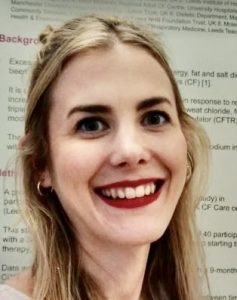
Fig. 37 Laura Caley
CF Trust
Rate of change in lung function is used as a measure of disease progression and a predictor of mortality in individuals with cystic fibrosis (CF). The aim of this study was to determine the national rate of decline in percent predicted Forced Expiratory Volume in 1 second (ppFEV1) in adults in the UK accounting for age, sex and pancreatic status.
Data on ppFEV1 for adults with CF, excluding those post lung transplantation, was extracted from the UK CF registry between 2015 and 2017. Multilevel modelling was conducted to calculate the annual rate of change in ppFEV1 accounting for age, sex and pancreatic status. The overall annual ppFEV1 decline was -1.52% (95% CI: -1.66 to -1.38%) and -0.55% (95% CI: -0.86 to -0.23%) in pancreatic insufficient (PI) and sufficient (PS) adults respectively. In PI individuals, females had a greater rate of decline in ppFEV1. There were differences between age groups. The fastest rate of decline was observed in the 18-28 years group, declining -1.76% (95% CI: -2.06 to -1.46) and -1.61% (95% CI: -1.91 to -1.31) per year in PI females and males respectively. The pattern between the sexes and age categories was more inconsistent in the PS group.
The average annual rates of decline in lung function in adults with CF in the UK are similar to reports from other large international cohorts. Pancreatic status has a marked impact on average rate of decline. Younger adults, especially females, have a faster rate of decline and need close monitoring.
Dr Laura Caley (37) is a researcher in the School of Medicine, Clinical Sciences Building, St James’s University Hospital, Leeds, LS9.
Diego A Calvopina , Charlton Noble, Anna Weis, Gunter F Hartel, Louise E Ramm, Fariha Balouch, Manuel A Fernandez-Rojo, Miranda A Coleman, Peter J Lewindon, Grant A Ramm. Supersonic shear-wave elastography and APRI for the detection and staging of liver disease in pediatric cystic fibrosis. J Cyst Fibros. 2020 May;19(3):449-454.doi: 10.1016/j.jcf.2019.06.017. Epub 2019 Jul 11 [Pubmed]

Fig 38 Grant A Ramm qimrberghofer.edu.au

Fig 39 Diego Calvopina
theorg.com
Background: Current diagnostic methods for the diagnosis of Cystic fibrosis (CF)-associated liver disease (CFLD) are non-specific and assessment of disease progression is difficult prior to the advent of advanced disease with portal hypertension. This study investigated the potential of Supersonic shear-wave elastography (SSWE) to non-invasively detect CFLD and assess hepatic fibrosis severity in children with CF.
Methods: 125 children were enrolled in this study including CFLD (n = 55), CF patients with no evidence of liver disease (CFnoLD = 41) and controls (n = 29). CFLD was diagnosed using clinical, biochemical and imaging best-practice guidelines. Advanced CFLD was established by the presence of portal hypertension and/or macronodular cirrhosis on ultrasound. Liver stiffness measurements (LSM) were acquired using SSWE and diagnostic performance for CFLD detection was evaluated alone or combined with aspartate aminotransferase-to-platelet ratio index (APRI).
Results: Liver stiffness measurements were significantly higher in CFLD (8.1 kPa, IQR = 6.7-11.9) versus CFnoLD (6.2 kPa, IQR = 5.6-7.0; P < 0.0001) and Controls (5.3 kPa, IQR = 4.9-5.8; P < 0.0001). LSM was also increased in CFnoLD versus Controls (P = 0.0192). Receiver Operating Characteristic (ROC) curve analysis demonstrated good diagnostic accuracy for LSM in detecting CFLD using a cut-off = 6.85 kPa with an AUC = 0.79 (Sensitivity = 75%, Specificity = 71%, P < 0.0001). APRI also discriminated CFLD (AUC = 0.74, P = 0.004). Classification and regression tree modelling combining LSM + APRI showed 14.8 times greater odds of accurately predicting CFLD (AUC = 0.84). The diagnostic accuracy of SSWE for discriminating advanced disease was excellent with a cut-off = 9.05 kPa (AUC = 0.95; P < 0.0001).
Conclusions: SSWE-determined LSM shows good diagnostic accuracy in detecting CFLD in children, which was improved when combined with APRI. SSWE alone discriminates advanced CFLD.
Dr Diego A Calvopina (fig39) is in the Hepatic Fibrosis Group, QIMR Berghofer Medical Research Institute, Herston Australia and a member of the Faculty of Medicine, The University of Queensland, Brisbane
Professor Grant A Ramm,(fig.38) the corresponding author, is Head of the Hepatic Fibrosis Group d Coordinator of the Cell and Molecular Biology Department at QIMR Berghofer.
Jose Caparrós-Martín, Stephanie Flynn, F Jerry Reen, David F Woods, Patricia Agudelo-Romero, Sarath C Ranganathan , Stephen M Stick, Fergal O’Gara. The Detection of Bile Acids in the Lungs of Paediatric Cystic Fibrosis Patients Is Associated With Altered Inflammatory Patterns. Diagnostics (Basel). 2020 May 6;10(5):E282.doi: 10.3390/diagnostics10050282. [Pubmed]

Fig 41 Fergal Ogara
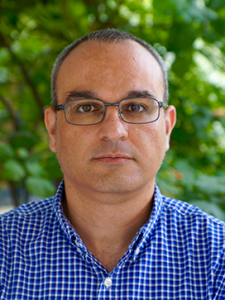
Fig. 40 Jose Caparros-Martin
Cystic fibrosis respiratory disease starts early in life, with the detection of inflammatory markers and infection evident even before respiratory symptoms arise. Thus, identifying factors that dysregulate immune responsiveness at the earliest stages of the disease will provide novel targets for early therapeutic intervention.
The authors evaluated the clinical significance of bile acid detection in the bronchoalveolar lavage fluid of clinically stable preschool-aged children diagnosed with CF. Results: We applied an unbiased classification strategy to categorize these specimens based on bile acid profiles. We provide clear associations linking the presence of bile acids in the lungs with alterations in the expression of inflammatory markers. Using multiple regression analysis, we also demonstrate that clustering based on bile acid profiles is a meaningful predictor of the progression of structural lung disease.
The authors consider their work has identified a clinically relevant host-derived factor that may participate in shaping early events in the aetiology of CF respiratory disease.
Dr Jose A Caparrós-Martín (fig.40) is a Research Associate with the Human Microbiome Programme, School of Pharmacy and Biomedical Sciences, Curtin University, Perth 6102, Australia and the Curtin Health Innovation Research Institute (CHIRI), Curtin University, Perth 6102, Australia.
He is senior researcher in the Human Microbiome Programme directed by Professor Fergal O’Gara.(fig.41)
Christopher Boyd A, Guo S, Huang L, Kerem B, Oren YS, Walker AJ, Hart SL. New approaches to genetic therapies for cystic fibrosis. J Cyst Fibros. 2020 Jan 13. pii: S1569-1993(19)30992-0. doi: 10.1016/j.jcf.2019.12.012. [Epub ahead of print] [Pubmed]

Fig 42 Christopher Boyd
Gene therapy offers great promise for cystic fibrosis which has never been quite fulfilled due to the challenges of delivering sufficient amounts of the CFTR gene and expression persistence for a sufficient period of time in the lungs to have any effect. Initial trials explored both viral and non-viral vectors but failed to achieve a significant breakthrough. However, in recent years, new opportunities have emerged that exploit our increased knowledge and understanding of the biology of CF and the airway epithelium. New technologies include new viral and non-viral vector approaches to delivery, but also alternative nucleic acid technologies including oligonucleotides and siRNA approaches for gene silencing and gene splicing, described in this review, as presented at the 2019 Annual European CF Society Basic Science meeting (Dubrovnik, Croatia). They also briefly discuss other emerging technologies including mRNA and CRISPR gene editing that are advancing rapidly. The future prospects for genetic therapies for CF are now diverse and more promising probably than any time since the discovery of the CF gene.
Chris Boyd (fig 42) and colleagues from the University of Edinburgh, Centre for Genomic and Experimental Medicine, University of Edinburgh and Institute of Genetics & Molecular Medicine, Western General Hospital, Edinburgh UK; UK Cystic Fibrosis Gene Therapy Consortium, UK
Calthorpe RJ, Smith S, Gathercole K, Smyth AR. Using digital technology for home monitoring, adherence and self-management in cystic fibrosis: a state-of-the-art review. Thorax. 2020 Jan;75(1):72-77. doi: 10.1136/thoraxjnl-2019-213233. Epub 2019 Oct 8.[Pubmed]
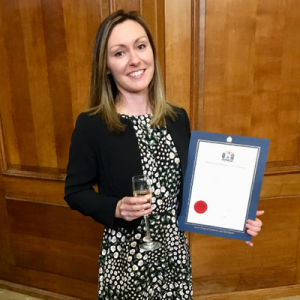
Fig. 43 Rebecca Calthorpe
Digital healthcare is a rapidly growing healthcare sector. Its importance has been recognised at both national and international level, with the WHO recently publishing its first global strategy for digital health. The use of digital technology within cystic fibrosis (CF) has also increased. CF is a chronic, life-limiting condition, in which the treatment burden is high and treatment regimens are not static. Digital technologies present an opportunity to support the lives of people with CF. We included 59 articles and protocols in this state-of-the-art review, relating to 48 studies from 1999 until 2019. This provides a comprehensive overview of the expansion and evolution of the use of digital technology. Technology has been used with the aim of increasing accessibility to healthcare, earlier detection of pulmonary exacerbations and objective electronic adherence monitoring. It may also be used to promote adherence and self-management through education, treatment management Apps and social media.
— This is a comprehensive review of the use of technology in various aspects of CF care. The fully referenced Thorax draft of the paper is available on the internet (R J Calthorpe) and is an excellent source of information for anyone looking in depth into this area.
Dr Rebecca J Calthorpe (fig 43) Division of Child Health, Obstetrics and Gynaecology, University of Nottingham, Nottingham, UK.
Calvo-Lerma J, Roca M, Boon M, Colombo C, de Koning B, Fornés-Ferrer V, Masip E, Garriga M, Bulfamante A, Asensio-Grau A, Andrés A, de Boeck K, Hulst J, Ribes-Koninckx C. Association between faecal pH and fat absorption in children with cystic fibrosis on a controlled diet and enzyme supplements dose. Pediatr Res. 2020 Apr 4. doi: 10.1038/s41390-020-0860-3. [Epub ahead of print [Pubmed]

Fig. 44 Joaquim Calvo-Lerma
Despite treatment with pancreatic enzyme replacement therapy (PERT), patients with cystic fibrosis (CF) can still suffer from fat malabsorption. A cause could be low intestinal pH disabling PERT. The aim of this study was to assess the association between faecal pH (as intestinal pH surrogate) and coefficient of fat absorption (CFA). Additionally, faecal free fatty acids (FFAs) were quantified to determine the amount of digested, but unabsorbed fat.
In a 24-h pilot study, CF patients followed a standardised diet with fixed PERT doses, corresponding to theoretical optimal doses determined by an in vitro digestion model. Study variables were faecal pH, fat and FFA excretion, CFA and transit time. Linear mixed regression models were applied to explore associations.
In 43 patients, median (1st, 3rd quartile) faecal pH and CFA were 6.1% (5.8, 6.4) and 90% (84, 94), and they were positively associated (p < 0.001). An inverse relationship was found between faecal pH and total fat excretion (p < 0.01), as well as total FFA (p = 0.048). Higher faecal pH was associated with longer intestinal transit time (p = 0.049) and the use of proton pump inhibitors (p = 0.009).
The authors concluded although the clinical significance of faecal pH is not fully defined, its usefulness as a surrogate biomarker for intestinal pH should be further explored. They suggest faecal pH is a physiological parameter that may be related to intestinal pH and may provide important physio-pathological information on CF-related pancreatic insufficiency. Faecal pH is correlated with fat absorption, and this may explain why pancreatic enzyme replacement therapy is not effective in all patients with malabsorption related to CF. Use of proton pump inhibitors is associated to higher values of faecal pH. Faecal pH could be used as a surrogate biomarker to routinely monitor the efficacy of pancreatic enzyme replacement therapy in clinical practice. Strategies to increase intestinal pH in children with cystic fibrosis should be targeted.
J Calvo-Lerma (Fig. 44) is at the Cystic Fibrosis Unit, Instituto de Investigación Sanitaria La Fe de Valencia, 46026, Valencia, Spain and the Research Institute of Food Engineering for Development, Universitat Politècnica de València, 46022, Valencia, Spain.
— This is an interesting paper and there are figures showing a good correlation of faecal pH with both the coefficient of fat absorption and faecal fat excretion. The authors’ suggestion that faecal pH could be used as a routine monitor of the efficacy of pancreatic replacement therapy seems to be worth exploring – particularly as faecal fat estimations are understandably unpopular and rarely used except for research purposes.
Joaquim Calvo-Lerma, Mieke Boon, Carla Colombo, Barbara de Koning, Inês Asseiceira, Maria Garriga, Maria Roca, Ine Claes, Anna Bulfamante, Sylvia Walet, Luisa Pereira, Mar Ruperto, Etna Masip, Andrea Asensio-Grau, Arianna Giana, Philine Affourtit, Ana Heredia, Saioa Vicente, Ana Andrés, Kris de Boeck, Jessie Hulst, Carmen Ribes-Koninckx. Clinical evaluation of an evidence-based method based on food characteristics to adjust pancreatic enzyme supplements dose in cystic fibrosis J Cyst Fibros 2020 Dec 2;S1569-1993(20)30926-7.doi: 10.1016/j.jcf.2020.11.016.Online ahead of print. [Pubmed]
Background: Patients with cystic fibrosis (CF) and pancreatic insufficiency need pancreatic enzyme replacement therapy (PERT) for dietary lipids digestion. There is limited evidence for recommending the adequate PERT dose for every meal, and controlling steatorrhea remains a challenge. This study aimed to evaluate a new PERT dosing method supported by a self-management mobile-app.
Methods: Children with CF recruited from 6 European centres were instructed to use the app, including an algorithm for optimal PERT dosing based on in vitro digestion studies for every type of food. At baseline, a 24h self-selected diet was registered in the app, and usual PERT doses were taken by the patient. After 1 month, the same diet was followed, but PERT doses were indicated by the app. Change in faecal fat and coefficient of fat absorption (CFA) were determined.
Results: 58 patients (median age 8.1 years) participated. Baseline fat absorption was high: median CFA 96.9%, median 2.4g faecal fat). After intervention CFA did not significantly change, but range of PERT doses was reduced: interquartile ranges narrowing from 1447-3070 at baseline to 1783-2495 LU/g fat when using the app. Patients with a low baseline fat absorption (CFA<90%, n=12) experienced significant improvement in CFA after adhering to the recommended PERT dose (from 86.3 to 94.0%, p=0.031).
Conclusion: the use of a novel evidence-based PERT dosing method, based on in vitro fat digestion studies incorporating food characteristics, was effective in increasing CFA in patients with poor baseline fat absorption and could safely be implemented in clinical practice.
Joaquim Calvo-Lerma (Fig. 44) is at the Instituto de Investigación Sanitaria La Fe de Valencia. Cystic Fibrosis Unit. 46026 Valencia, Spain; Universitat Politècnica de València, Research Institute of Food Engineering for Development. 46022 Valencia, Spain.
Cares K, Klein M, Thomas R, El-Baba M. Rectal Prolapse in Children: An Update to Causes, Clinical Presentation, and Management. J Pediatr Gastroenterol Nutr. 2020 Feb;70(2):243-246. doi: 10.1097/MPG.0000000000002546 [Pubmed]
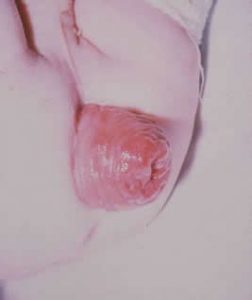
Fig. 45 Rectal Prolapse Leeds photo
A total of 158 patients were diagnosed with rectal prolapse, with mean age of onset being 3 years. Constipation was the leading cause, with straining being the most common complaint. Cystic fibrosis was only diagnosed in 4 patients. Thirty-four patients (22%) required surgical correction.
Constipation remains the main cause of rectal prolapse. Cystic fibrosis is no longer a common aetiology for rectal prolapse, because of the implementation of newborn screening. Patients with social stressors or atypical behaviour may be at risk for recurrent rectal prolapse.
From the Children’s Research Center, Children’s Hospital of Michigan, Detroit, MI.
Ryan M Centko , Graeme W Carlile, Isabel Barne , Brian O Patrick, Polina Blagojevic, David Y Thomas , Raymond J Andersen. Combination of Selective PARP3 and PARP16 Inhibitory Analogues of Latonduine A Corrects F508del-CFTR Trafficking ACS Omega. 2020 Sep 29;5(40):25593-25604. doi: 10.1021/acsomega.0c02467.eCollection 2020 Oct 13. Free PMC article [Pubmed]

Fig. 46 Ryan Centko
Harvard University
The marine natural product latonduine A (1) shows F508del-cystic fibrosis transmembrane regulator (CFTR) corrector activity in cell-based assays. Pull-down experiments, enzyme inhibition assays, and siRNA knockdown experiments suggest that the F508del-CFTR corrector activities of latonduine A and a synthetic analogue MCG315 (4) result from simultaneous inhibition of PARP3 and PARP16. A library of synthetic latonduine A analogs has been prepared in an attempt to separate the PARP3 and PARP16 inhibitory properties of latonduine A with the goal of discovering selective small-molecule PARP3 and PARP16 inhibitory cell biology tools that could confirm the proposed dual-target F508del-CFTR corrector mechanism of action.
The structure activity relationship (SAR) study reported herein has resulted in the discovery of the modestly potent (IC50 3.1 μM) PARP3 selective inhibitor (±)-5-hydroxy-4-phenyl-2,3,4,5-tetrahydro-1H-benzo[c]azepin-1-one (5) that shows 96-fold greater potency for inhibition of PARP3 compared with its inhibition of PARP16 in vitro and the potent (IC50 0.362 μM) PARP16 selective inhibitor (±)-7,8-dichloro-5-hydroxy-4-(pyridin-2-yl)-2,3,4,5-tetrahydro-1H-benzo[c]azepin-1-one (6) that shows 205-fold selectivity for PARP16 compared with PARP3 in vitro. At 1 or 10 μM, neither 5 or 6alone showed F508del-CFTR corrector activity, but when added together at 1 or 10 μM each, the combination exhibited F508del-CFTR corrector activity identical to 1 or 10 μM latonduine A (1), respectively, supporting its novel dual PARP target mechanism of action. Latonduine A (1) showed additive in vitro corrector activity in combination with the clinically approved corrector VX809, making it a potential new partner for cystic fibrosis combination drug therapies.
Dr Ryan M Centko (fig.46) is at the Department of Chemistry and Department of Earth, Ocean & Atmospheric Sciences, University of British Columbia, Canada
Hung-Hsin Chen, Douglas M Shaw, Lauren E Petty, Misa Graff, Ryan J Bohlender, Hannah G Polikowsky, et al. Host genetic effects in pneumonia. Am J Hum Genet 2020 Dec 13;S0002-9297(20)30446-8.doi: 10.1016/j.ajhg.2020.12.010.Online ahead of print. [Pubmed]

Fig. 47 Hung-Hsin Chen medschool.vanderbilt.edu
Given the coronavirus disease 2019 (COVID-19) pandemic, investigations into host susceptibility to infectious diseases and downstream sequelae have never been more relevant. Pneumonia is a common complication of infectious diseases, including COVID-19. Few genome-wide association studies (GWASs) of host susceptibility and severity of pneumonia have been conducted.
We performed GWASs of pneumonia susceptibility and severity in the Vanderbilt University biobank (BioVU) with linked electronic health records (EHRs), including Illumina Expanded Multi-Ethnic Global Array (MEGAEX)-genotyped European ancestry (EA, n= 69,819) and African ancestry (AA, n = 15,603) individuals. Two regions of large effect were identified: the CFTR locus in EA (rs113827944; OR = 1.84, p value = 1.2 × 10-36) and HBB in AA (rs334 [p.Glu7Val]; OR = 1.63, p value = 3.5 × 10-13).
Mutations in these genes cause cystic fibrosis (CF) and sickle cell disease (SCD), respectively. After removing individuals diagnosed with CF and SCD, we assessed heterozygosity effects at our lead variants.
Further GWASs after removing individuals with CF uncovered an additional association in R3HCC1L (rs10786398; OR = 1.22, p value = 3.5 × 10-8), which was replicated in two independent datasets: UK Biobank (n = 459,741) and 7,985 non-overlapping BioVU subjects, who are genotyped on arrays other than MEGAEX. This variant was also validated in GWASs of COVID-19 hospitalization and lung function. Our results highlight the importance of the host genome in infectious disease susceptibility and severity and offer crucial insight into genetic effects that could potentially influence severity of COVID-19 sequelae.
Hung-Hsin Chen (fig.47) is a Post Doctoral Fellow at the Vanderbilt Genetics Institute and Division of Genetic Medicine, Department of Medicine, Vanderbilt University Medical Center, Nashville, TN 37232, USA.
Laurent R Chiarelli, Viola Camilla Scoffone, Gabriele Trespidi, Giulia Barbieri, Olga Riabova, Natalia Monakhova, Alessio Porta, Giulia Manina, Giovanna Riccardi, Vadim Makarov, Silvia Buroni.. Chemical, Metabolic, and Cellular Characterization of a FtsZ Inhibitor Effective Against Burkholderia cenocepacia. Front Microbiol 2020 Apr 7;11:562.doi: 10.3389/fmicb.2020.00562. eCollection 2020. [Pubmed]

Fig 48 Laurant R Chiarelli LinkedIn
There is an urgent need for new antimicrobials to treat the opportunistic Gram-negative Burkholderia cenocepacia, which represents a problematic challenge for cystic fibrosis patients. Recently, a benzothiadiazole derivative, C109, was shown to be effective against the infections caused by B. cenocepacia and other Gram-negative and-positive bacteria. C109 has a promising cellular target, the cell division protein FtsZ, and a recently developed PEGylated formulation make it an attractive molecule to counteract Burkholderia infections. However, the ability of efflux pumps to extrude it out of the cell represents a limitation for its use. Here, more than 50 derivatives of C109 were synthesized and tested against Gram-negative species and the Gram-positive Staphylococcus aureus. In addition, their activity was evaluated on the purified FtsZ protein. The chemical, metabolic and cellular stability of C109 has been assayed using different biological systems, including quantitative single-cell imaging. However, no further improvement on C109 was achieved, and the role of efflux in resistance was further confirmed. Also, a novel nitroreductase that can inactivate the compound was characterized, but it does not appear to play a role in natural resistance. All these data allowed a deep characterization of the compound, which will contribute to a further improvement of its properties.
Laurant R Chiarelli (fig.48) is at the Laboratory of Molecular Microbiology, Department of Biology and Biotechnology “L. Spallanzani”, University of Pavia, Pavia, Italy.
Brian Cicali , Tao Long, Sarah Kim, Rodrigo Cristofoletti. Assessing the Impact of Cystic Fibrosis on the Antipyretic Response of Ibuprofen in Children: Physiologically-Based Modeling as a Candle in the Dark. Br J Clin Pharmacol 2020 Apr 25.doi: 10.1111/bcp.14326. Online ahead of print. [Pubmed]

Fig. 49 Rodrigo Cristofoletti pc.pharmacy.ufl.edu
The goal of this study is to present the utility of quantitative modelling for extrapolation of drug safety and efficacy to underrepresented populations in controlled clinical trials. To illustrate this, the stepwise development of an integrated disease/pharmacokinetics/pharmacodynamics model of antipyretic efficacy of ibuprofen in children with cystic fibrosis (CF) is presented along with therapy optimization suggestions.
Published clinical trials, in vitro data and drug physiochemical properties were used to develop an ibuprofen-mediated antipyresis model for febrile children also having CF. Workflow included first developing a mechanistic absorption model using in vitro-in vivo extrapolation followed by physiologically-based pharmacokinetic (PBPK) modeling. The verified PBPK model was then scaled to pediatric patients with CF. Once verified, the PBPK model was linked to an indirect response model of antipyresis for simulation of the overall antipyretic efficacy of ibuprofen in CF children.
Model simulations showed therapeutic inequivalence between healthy children and pediatric patients with CF; Cmax and AUC decreased by 39% (32-46%) and 44% (36-52%), respectively, in patients. Further and in agreement with literature reports, predicted pharmacodynamics time courses suggest a slower onset and faster offset of action in patients compared to healthy children, 30 and 60 minutes, respectively. Exploratory simulations suggest an increase in dosing frequency for CF children as a better therapeutic strategy.
The authors concluded model-informed approaches to leveraging knowledge obtained throughout the life cycle of drug development may play a key role in extrapolating drug efficacy and safety to underrepresented populations.
Dr Rodrigo Cristofoletti (fig. 49) is Research Assistant Professor at the Center for Pharmacometrics and Systems Pharmacology, Department of Pharmaceutics, College of Pharmacy, University of Florida, Orlando, FL, USA
Cipolli M, Fethney J, Waters D, Zanolla L, Meneghelli I, Dutt S, Assael BM, Gaskin KJ.Occurrence, outcomes and predictors of portal hypertension in cystic fibrosis: A longitudinal prospective birth cohort study. J Cyst Fibros. 2020 May;19(3):455-459. doi: 10.1016/j.jcf.2019.09.016. Epub 2019 Oct 31. [Pubmed]

Fig. 51 Kevin Gaskin author’s photo

Fig. 50 Marco Cipolli kitherbiotech.com
Background: The reported prevalence of portal hypertension (PH) in Cystic Fibrosis is variable, incidence rates rarely provided and the utility of liver function tests (LFT’s) early in life to predict PH is questionable. The aims were to (1) determine PH prevalence (P) and incidence rate (IR) and combined mortality transplant (MTX) data in PH vs non-PH patients and (2) to assess association of LFTs in early life with liver disease and PH.
Method: (1) A double centre longitudinal cohort study of 577 CF patients diagnosed by newborn screening (NBS) with annual examinations for PH up to 18.5 years of age (max) was performed over 28 years for P, IR, and MTX data; (2) Cox proportional hazard models were used to assess the association of elevated LFTs on 2 or more occasions over 0-6.5 years and PH.
Results: 51/577(8.8%) developed PH with an average IR of near 3/1000 patient years per 5 year interval representing young, mid and late childhood respectively in patients 3-18 years of age. Combined mortality/liver transplant occurred in 12/51 (23.5%) PH and 25/526 (4.8%) non-PH (p < 0.001). Elevated enzymes particularly GGT (HR:5.71, 95% CI 3.11-10.47); ALT/GGT (HR: 5.56, 95% CI 2.82-10.98); and ALP/GGT (HR: 5.74, 95% CI 2.78-11.86) were associated with the onset of PH.
The authors concluded: This birth cohort with annual examination for PH provides an accurate assessment of the prevalence, and IR of PH and MTX of PH vs non-PH. Early elevated LFTs are associated with onset of MBC/PH.
Marco Cipolli (fig. 50) is Director of the Cystic Fibrosis Center, Azienda Ospedaliera Universitaria Integrata, Verona, Italy.
Kevin J Gaskin (fig. 51) (1948-2021) Professor at the Department of Gastroenterology/James Fairfax Institute of Paediatric Nutrition, The Children’s Hospital at Westmead, Sydney, Australia
— A study from the Verona CF Centre in Italy and the Children’s Hospital at Westmead CF clinic Australia – the former introduced neonatal CF screening in the mid-Seventies (Gianni Mastella) and the latter from the early Eighties (Bridget Wilcken). This is the first time a CF neonatal cohort has been followed for 18.5 years assessing the occurrence and subsequent evolution of severe liver disease
Nazan Çobanoğlu, Uğur Özçelik, Erkan Çakır, Tuğba Şişmanlar Eyüboğlu, Sevgi Pekcan, Güzin Cinel.et al. Patients eligible for modulator drugs: Data from cystic fibrosis registry of Turkey. Pediatr Pulmonol 2020 Sep;55(9):2302-2306. doi: 10.1002/ppul.24854. Epub 2020 May 26. [Pubmed]

Fig. 52 Nazan Çobanoğlu
Clinical Case Reports
Background: A better understanding of cystic fibrosis transmembrane conductance regulator biology has led to the development of modulator drugs such as ivacaftor, lumacaftor-ivacaftor, tezacaftor-ivacaftor, and elexacaftor-tezacaftor-ivacaftor. This cross-sectional study evaluated cystic fibrosis (CF) patients eligible for modulator drugs.
Methods: Data for age and genetic mutations from the Cystic Fibrosis Registry of Turkey collected in 2018 were used to find out the number of patients who are eligible for modulator therapy.
Results: Of registered 1488 CF patients, genetic analysis was done for 1351. The numbers and percentages of patients and names of the drugs, that the patients are eligible for, are as follows: 122 (9.03%) for ivacaftor, 156 (11.54%) for lumacaftor-ivacaftor, 163 (11.23%) for tezacaftor-ivacaftor, and 57 (4.21%) for elexacaftor-tezacaftor-ivacaftor. Among 1351 genotyped patients total of 313 (23.16%) patients are eligible for currently licensed modulator therapies (55 patients were shared by ivacaftor and tezacaftor-ivacaftor, 108 patients were shared by lumacaftor-ivacaftor and tezacaftor-ivacaftor, and 22 patients were shared by tezacaftor-ivacaftor and elexacaftor-tezacaftor-ivacaftor groups).
Conclusions: The present study shows that approximately one-fourth of the registered CF patients in Turkey are eligible for modulator drugs. As, frequent mutations that CF patients have in Turkey are different from North American developing countries like Turkey is noteworthy and European CF patients, developing modulator drugs effective for those mutations is necessary. Furthermore, as modulator drugs are very expensive currently, financial support of the government in developing countries like Turkey is noteworthy.
Prof. Dr Fatama Nazan Çobanoğlu (fig.52) is in the Division of Pediatric Pulmonology, Faculty of Medicine, Ankara University, Ankara, Turkey.
Coffey MJ, Garg M, Homaira N, Jaffe A, Ooi CY. Probiotics for people with cystic fibrosis. Cochrane Database Syst Rev. 2020 Jan 22;1:CD012949. doi: 10.1002/14651858.CD012949.pub2. [Pubmed]

Fig. 53 Michael J Coffey
The conclusions of this review were that probiotics significantly reduce faecal calprotectin (a marker of intestinal inflammation) in children and adults with CF, however the clinical implications of this require further investigation. Probiotics may make little or no difference to pulmonary exacerbation rates, however, further evidence is required before firm conclusions can be made. Probiotics are associated with a small number of adverse events including vomiting, diarrhoea and allergic reactions. In children and adults with CF, probiotics may be considered by patients and their healthcare providers. Given the variability of probiotic composition and dosage, further adequately-powered multicentre RCTs of at least 12 months duration are required to best assess the efficacy and safety of probiotics for children and a
Dr Michael Jonathon Coffey (fig. 53) is a researcher at the University of New South Wales, School of Women’s and Children’s Health,
Colombo C, Burgel PR, Gartner S, van Konigbruggen-Rietschel S, Noehrlich L, Seet-Gaudelus I, Southern KW. Impact of COVID-19 on people with cystic fibrosis. Lancet Respir Med. 2020;8(5):e35‐e36. doi:10.1016/S2213-2600(20)30177-6 [Pubmed] Free PMC article

Fig. 54 Carla Colombo
Carla Colombo and colleagues briefly review certain aspects of the coronavirus pandemic as it affects people with CF. In Lombardy there have been only 10 people with CF out of total of 42,161 infected patients. They usually acquired the infection from family members. Similar experience came from UK, Germany and Spain with no serious impact on their CF disease severity of patients. The ECFS Registry is collecting data. Features of COVID-19 are clearly differentiated from those of cystic fibrosis. Requirement for availability of medication, foods are required for affected patients. No new clinical trials are starting and support is given to subjects with CF on current trials.
The article concludes “People with cystic fibrosis and their families have invested considerable time and energy to maintain good health and, now, on the cusp of remarkable new therapies to transform their condition, they face a global pandemic, the effect of which is unclear. Early data suggest that most patients with cystic fibrosis are doing an exceptional job avoiding SARS-CoV-19 infection, but they must remain dedicated to this task, as data are gathered from across Europe to better understand factors that affect the severity of COVID-19 in people with cystic fibrosis.
Prof. Carla Colombo (fig.54) is at the Cystic Fibrosis Regional Reference Center, University of Milan and the Department of Pathophysiology and Transplantation, Milan, Italy See also.[Pubmed] for more detail
Rebecca Cosgriff, Susannah Ahern, Scott C Bell, Keith Brownlee, Pierre-Régis Burgel, Cass Byrnes, Harriet Corvol, Stephanie Y Cheng, Alexander Elbert, Albert Faro, Christopher H Goss, Vincent Gulmans, Bruce C Marshall, Edward McKone, Peter G Middleton, Rasa Ruseckaite, Anne L Stephenson, Siobhán B Carr . A multinational report to characterise SARS-CoV-2 infection in people with cystic fibrosis. J Cyst Fibros 2020 May;19(3):355-358.doi: 10.1016/j.jcf.2020.04.012. Epub 2020 Apr 25. Free PMC article[Pubmed]

Fig. 55 Rebecca Cosgriff
Information is lacking on the clinical impact of the novel coronavirus, SARS-CoV-2, on people with cystic fibrosis (CF). Our aim was to characterise SARS-CoV-2 infection in people with cystic fibrosis. Methods: Anonymised data submitted by each participating country to their National CF Registry was reported using a standardised template, then collated and summarised.
Results: 40 cases have been reported across 8 countries. Of the 40 cases, 31 (78%) were symptomatic for SARS-CoV-2 at presentation, with 24 (60%) having a fever. 70% have recovered, 30% remain unresolved at time of reporting, and no deaths have been submitted.
Conclusions: This early report shows good recovery from SARS-CoV-2 in this heterogeneous CF cohort. The disease course does not seem to differ from the general population, but the current numbers are too small to draw firm conclusions and
Rebecca Cosgriff (fig.55) is Director of Data & Quality Improvement at the Cystic Fibrosis Trust, London. Subsequently Head of Strategy, Data for R&D
Cottrill KA, Farinha CM, McCarty NA. The bidirectional relationship between CFTR and lipids. Commun Biol. 2020;3(1):179. Published 2020 Apr 20. doi:10.1038/s42003-020-0909-1 [Pubmed]

Fig. 56 Kirsten Cottrill
While work to understand this CFTR has resulted in new treatment strategies, it is important to emphasise that CFTR exists within a complex lipid bilayer – a concept largely overlooked when performing structural and functional studies. In this review the authors discuss cellular lipid imbalances in CF, mechanisms by which lipids affect membrane protein activity, and the specific impact of detergents and lipids on CFTR function.
Kirsten A Cottrill (fig.56) is a Graduate Student at the McCarty Lab, Molecular and Systems Pharmacology Program, Emory University, Atlanta, GA, USA.
Cuevas-Ocaña S, Laselva O, Avolio J, Nenna R. The era of CFTR modulators: improvements made and remaining challenges Breathe (Sheff). 2020 Jun;16(2):200016. doi: 10.1183/20734735.0016-2020. [Pubmed] PMC article.

Fig.57 Sara Cuevas-Ocaña
The entry into the clinic of CFTR modulators such as TRIKAFTA has significantly improved life for 90% CF patients carrying one or two F508del mutations but challenges remain for rare CFTR mutations and the management of lung infections.
This last decade has created historical moments for CF, primarily driven by the development of CFTR modulators. First for patients with gating mutations who benefited from Kalydeco, then for those patients with one F508del copy who could benefit from Orkambi, and most recently, patients with at least one F508del copy who can benefit from Trikafta. Despite heterogeneity in patient response, the majority of CF patients will be greatly impacted by using a CFTR modulator therapy, thus changing the trajectory of their life. Furthermore, it remains to be determined whether the next generation of modulators will be effective for individuals bearing rare mutations that are Orkambi resistant. However, it should not be forgotten that there still remains 10% of the CF population who do not have a targeted CFTR modulator treatment. In addition, even with these novel drug therapies, managing infections will continue to be a challenge, thus the CF community will need to adapt the standards for an improving, but ageing CF population.
Dr Sara Cuevas-Ocaña (fig.57) is a Research Fellow in the University of Nottingham Biodiscovery Institute, Nottingham, UK
– An excellent very readable summary of the present situation regarding the modulators including the key references.
Alejandro Da Silva Sanchez, Kalina Paunovska, Ana Cristian, James E Dahlman. Treating Cystic Fibrosis with mRNA and CRISPR. Hum Gene Ther 2020 Sep;31(17-18):940-955.doi: 10.1089/hum.2020.137.Epub 2020 Sep 8. [Pubmed]

Fig. 59 James Dahlman Winship Cancer Institute

Fig.58 Alejandro Da Silva Sanchezj ResearchGate
Less than 20% of the protein coding genome is thought to be targetable using small molecules. mRNA therapies are not limited in the same way since in theory, they can silence or edit any gene by encoding CRISPR nucleases, or alternatively, produce any missing protein. Yet not all mRNA therapies are equally likely to succeed. Over the past several years, an increasing number of clinical trials with siRNA- and antisense oligonucleotide-based drugs have revealed three key concepts that will likely extend to mRNA therapies delivered by nonviral systems. First, scientists have come to understand that some genes make better targets for RNA therapies than others. Second, scientists have learned that the type and position of chemical modifications made to an RNA drug can alter its therapeutic window, toxicity, and bioavailability. Third, scientists have found that safe and targeted drug delivery vehicles are required to ferry mRNA therapies into diseased cells.
In this study, we apply these learnings to cystic fibrosis (CF). We also describe lessons learned from a subset of CF gene therapies that have already been tested in patients. Finally, we highlight the scientific advances that are still required for nonviral mRNA- or CRISPR-based drugs to treat CF successfully in patients.
Dr Alejandro Da Silva Sanchez (fig.58) is a graduate research assistant at the Petit Institute for Bioengineer and Biosciences, Georgia Institute of Technology, Atlanta, Georgia, USA and the School of Chemical & Biomolecule Engineering, Georgia Institute of Technology, Atlanta, Georgia, USA.
Dr. Dahlman (fig.59) is a chemical and bioengineer whose work lies at the interface of nanotechnology, genomics, and gene editing. He is Associate Professor and holds the McCamish Foundation Early Career Professorship in the Wallace H. Coulter Department of Biomedical Engineering at Georgia Tech University.
Danahay HL, Lilley S, Fox R, Charlton H, Sabater J, Button B, McCarthy C, Collingwood SP, Gosling M. TMEM16A Potentiation: A Novel Therapeutic Approach for the Treatment of Cystic Fibrosis.
Am J Respir Crit Care Med. 2020 Jan 3. doi: 10.1164/rccm.201908-1641OC. [Epub ahead of print] [Pubmed]

Fig. 60 Henry Donahay
Rationale: Enhancing non-CFTR mediated anion secretion is an attractive therapeutic approach for the treatment of cystic fibrosis and other muco-obstructive diseases. Objectives: To determine the effects of TMEM16A potentiation upon epithelial fluid secretion and mucociliary clearance. Methods: The effects of a novel low molecular weight TMEM16A potentiator (ETX001) were evaluated in human cell and animal models of airway epithelial function and mucus transport. Measurements & Main Results: Potentiating the activity of TMEM16A with ETX001 increased the Ca2+-activated Cl- channel activity and anion secretion in human bronchial epithelial cells from cystic fibrosis patients without impacting on calcium signalling. ETX001 rapidly increased fluid secretion and airway surface liquid height in cystic fibrosis human bronchial epithelial cells under both static and conditions designed to mimic the shear stress associated with tidal breathing. In ovine models of mucus clearance (tracheal mucus velocity and mucociliary clearance), inhaled ETX001 was able to accelerate clearance both when CFTR function was reduced by administration of a pharmacological blocker and when CFTR was fully functional. Conclusions: Enhancing the activity of TMEM16A increases epithelial fluid secretion and enhances mucus clearance independent of CFTR function. TMEM16A potentiation is a novel approach for the treatment of patients with cystic fibrosis and non-CF muco-obstructive diseases. This article is open access and distributed under the terms of the Creative Commons Attribution Non-Commercial No Derivatives License 4.0 (http://creativecommons.org/licenses/by-nc-nd
Dr Henry Donahay (fig.60) is co-founder of Enterprise Therapeutics Ltd, Brighton, head of biology and Hon. Senior Research Fellow University of Sussex.
Sayan Das , Debaki R Howlader, Qi Zheng, Siva Sai Kumar Ratnakaram, Sean K Whittier . Development of a Broadly Protective, Self-Adjuvanting Subunit Vaccine to Prevent Infections by Pseudomonas aeruginosa. Front Immunol 2020 Nov 17;11:583008. doi: 10.3389/fimmu.2020.583008. eCollection 2020. [Pubmed]

Fig. 61 Sayan Das
Infections caused by the opportunistic pathogen Pseudomonas aeruginosa can be difficult to treat due to innate and acquired antibiotic resistance and this is exacerbated by the emergence of multi-drug resistant strains. Unfortunately, no licensed vaccine yet exists to prevent Pseudomonasinfections. Here we describe a novel subunit vaccine that targets the P. aeruginosa type III secretion system (T3SS). This vaccine is based on the novel antigen PaF (Pa Fusion), a fusion of the T3SS needle tip protein, PcrV, and the first of two translocator proteins, PopB. Additionally, PaF is made self-adjuvanting by the N-terminal fusion of the A1 subunit of the mucosal adjuvant double-mutant heat-labile enterotoxin (dmLT). Here we show that this triple fusion, designated L-PaF, can activate dendritic cells in vitro and elicits strong IgG and IgA titers in mice when administered intranasally. This self-adjuvanting vaccine expedites the clearance of P. aeruginosafrom the lungs of challenged mice while stimulating host expression of IL-17A, which may be important for generating a protective immune response in humans. L-PaF’s protective capacity was recapitulated in a rat pneumonia model, further supporting the efficacy of this novel fusion vaccine.
Dr Sayan Das (fig 61) is a post-doctoral researcher in the Department of Pharmaceutical Chemistry, School of Pharmacy, University of Kansas, Lawrence, KS, United States.
De Boeck K, Lee T, Amaral M, Drevinek P, Elborn JS, Fajac I, Kerem E, Davies JC. Cystic fibrosis drug trial design in the era of CFTR modulators associated with substantial clinical benefit: stakeholders’ consensus view. J Cyst Fibros. 2020 Jun 8:S1569-1993(20)30162-4. doi: 10.1016/j.jcf.2020.05.012. Online ahead of print.[Pubmed]
CFTR modulators associated with substantial clinical benefit are expected to rapidly improve the baseline condition of people with cystic fibrosis (PWCF) as well as decrease the rate of lung function decline, the occurrence of pulmonary exacerbations and likely even other disease complications. These changes in clinical status of PWCF introduced by clinically effective modulator therapy will have major repercussions on modalities of future CF drug development.
As part of its ‘Strategic Plan to speed up Access to new Drugs’, the European Cystic Fibrosis Society (ECFS) convened a meeting in Brussels on November 27th 2019 with relevant stakeholders (CF researchers and clinicians, patient organization and pharmaceutical company representatives, regulators, health technology assessors; see Acknowledgments for list of attendees) to discuss the future of clinical trials in cystic fibrosis (CF) in the context of HEMT entering the clinical arena. The following is the conclusion of the presentations and discussions. It is hoped that these concepts will be considered in future regulatory guidelines and may provide rationale and support for alternative trial designs.
Department of Paediatrics, University Hospital of Leuven, University of Leuven, Leuven, Belgium.
– A distinguished group of authors make an important point in this era of changing treatments and outlooks
Angélique Denis , Sandrine Touzet , Lamoussa Diabaté , Isabelle Durieu , Lydie Lemonnier , Stéphanie Poupon-Bourdy, Jean Iwaz , Quitterie Reynaud , Muriel Rabilloud . Quantifying Long-Term Changes in Lung Function and Exacerbations After Initiation of Azithromycin in Cystic Fibrosis. Ann Am Thorac Soc 2020; 17(2):195-201. [Pubmed]
In cystic fibrosis, information on the efficacy of azithromycin past 12 months of treatment is still scarce. The study sought to quantify the changes in lung function and the number of intravenous antibiotic courses (IVACs) after initiation of azithromycin in patients included in the French Cystic Fibrosis Registry. The study followed 1,065 children and 990 adults from 2 years before to 5 years after long-term azithromycin treatment initiated between 2001 and 2011. Mixed change-point models were used to quantify the changes in the forced expiratory volume (FEV) in 1 second and the yearly number of IVACs.
The authors concluded in children, long-term azithromycin treatment was associated with immediate and sustained beneficial changes in lung function and sustained beneficial changes in the frequency of pulmonary exacerbations. In adults, it was associated with immediate beneficial changes in lung function.
Dr Angelique Denis is at Hospices Civils de Lyon, Pole Sante Publique and the Universite de Lyon
Davies G, Thia LP, Stocks J, Bush A, Hoo AF, Wade A, Nguyen TTD, Brody AS, Calder A, Klein NJ, Carr SB, Wallis C, Suri R, Pao CS, Ruiz G, Balfour-Lynn IM; London Cystic Fibrosis Collaboration (LCFC). Minimal change in structural, functional and inflammatory markers of lung disease in newborn screened infants with cystic fibrosis at one year. J Cyst FIBROS 2020 Feb 7. pii: S1569-1993(20)30031-X.doi: 10.1016/j.jcf.2020.01.006. [Epub ahead of print] [Pubmed[]
With the widespread introduction of newborn screening for cystic fibrosis(CF), there has been considerable emphasis on the need to develop objective markers of lung health that can be used during infancy. We hypothesised that in a newborn screened (NBS) UK cohort, evidence of airway inflammation and infection at one year would be associated with adverse structural and functional outcomes at the same age.
Infants underwent lung function testing, chest CT scan and bronchoscopy with bronchoalveolar lavage (BAL) at 1 year of age when clinically well. Microbiology cultures were also available from routine cough swabs.
65 infants had lung function, CT and BAL. Mean (SD) lung clearance index and forced expiratory volume in 0.5 s z-scores were 0.9(1.2) and -0.6(1.1) respectively; median Brody II CF-CT air trapping score on chest CT =0 (interquartile range 0-1, maximum possible score 27). Infants isolating any significant pathogen by 1 yr of age had higher LCI z-score (mean difference 0.9; 95%CI:0.4-1.4; p = 0.001) and a trend towards higher air trapping scores on CT (p = 0.06). BAL neutrophil elastase was detectable in 23% (10/43) infants in whom BAL supernatant was available. This did not relate to air trapping score on CT.
The authors concluded that in this UK NBS cohort at one year of age, lung and airway damage is much milder and associations between inflammation, abnormal physiology and structural changes were at best weak, contrary to our hypothesis and previously published reports. Continued follow-up will clarify longer term implications of these very mild structural, functional and inflammatory changes.
Dr Gwyneth Davies is a Research Associate Respiratory, Critical Care and Anaesthesia section, UCL Great Ormond Street Institute of Child Health (GOS ICH), London,
Davies JC, Sermet-Gaudelus I, Naehrlich L, Harris RS, Campbell D, Ahluwalia N, Short C, Haseltine E, Panorchan P, Saunders C, Owen CA, Wainwright CE; VX16-661-115 Investigator Group. A phase 3, double-blind, parallel-group study to evaluate the efficacy and safety of tezacaftor in combination with ivacaftor in participants 6 through 11 years of age with cystic fibrosis homozygous for F508del or heterozygous for the F508del-CFTR mutation and a residual function mutation. J Cyst Fibros. 2020 Sep 21:S1569-1993(20)30811-0. doi: 10.1016/j.jcf.2020.07.023. Online ahead of print.Free article. [Pubmed]
Background: The CFTR modulator tezacaftor/ivacaftor (SYMDEKO) was efficacious and generally safe and well tolerated in Phase 3 studies in participants ≥12 years of age with cystic fibrosis (CF) homozygous for the F508del-CFTR mutation or heterozygous with a residual function-CFTR mutation (F/F or F/RF respectively). We evaluated tezacaftor/ivacaftor’s efficacy and safety over 8 weeks in participants 6 through 11 years of age with these mutations.
Methods: Participants were randomized 4:1 to tezacaftor/ivacaftor or a blinding group (placebo for F/F, ivacaftor for F/RF). The primary endpoint was within-group change from baseline in the lung clearance index 2·5 (LCI2·5) through Week 8. Secondary endpoints were change from baseline in sweat chloride (SwCl), cystic fibrosis questionnaire-revised (CFQ-R) respiratory domain score, and safety.
Results: Sixty-seven participants received at least one study drug dose. Of those, 54 received tezacaftor/ivacaftor (F/F, 42; F/RF, 12), 10 placebo, and 3 ivacaftor; 66 completed the study. The within-group change in LCI2·5 was significantly reduced (improved) by -0·51 (95% CI: -0·74, -0·29). SwCl concentration decreased (improved) by -12·3 mmol/L and CFQ-R respiratory domain score increased (improved, nonsignificantly) by 2·3 points. There were no serious adverse events (AEs) or AEs leading to tezacaftor/ivacaftor discontinuation or interruption. The most common AEs (≥10%) in participants receiving tezacaftor/ivacaftor were cough, headache, and productive cough.
Conclusions: Tezacaftor/ivacaftor improved lung function (assessed using LCI) and CFTR function (measured by SwCl concentration) in participants 6 through 11 years of age with F/F or F/RF genotypes. Tezacaftor/ivacaftor was safe and well tolerated; no new safety concerns were identified.
Jane Davies (fig.62) is Professor at the National Heart and Lung Institute, Imperial College London, London, United Kingdom; Royal Brompton & Harefield NHS Foundation Trust, London, United Kingdom
Jane C Davies , Claire E Wainwright , Gregory S Sawicki , Mark N Higgins, Daniel Campbell, Christopher Harris , Paul Panorchan , Eric Haseltine , Simon Tian , Margaret Rosenfeld , ARRIVAL Study Group. Ivacaftor in Infants Aged 4 to <12 Months With Cystic Fibrosis and a Gating Mutation: Results of a 2-Part Phase 3 Clinical Trial. Am J Respir Crit Care Med 2020 Oct 7. doi: 10.1164/rccm.202008-3177OC.Online ahead of print.[Pubmed]

Fig. 62 Jane Davies
Rationale: We previously reported that ivacaftor was safe and well tolerated in cohorts aged 12 to <24 months with cystic fibrosis and gating mutations in the ARRIVAL study; here we report results for cohorts aged 4 to <12 months. Objectives: Evaluate safety, pharmacokinetics, and pharmacodynamics of ivacaftor in infants aged 4 to <12 months with ≥1 gating mutation.
Methods: ARRIVAL is a single-arm phase 3 study. Infants received ivacaftor 25 or 50 mg every 12 hours based on age and weight for 4 days in part A and 24 weeks in part B.
Measurements and Main Results: Primary endpoints were safety (parts A and B) and pharmacokinetics (part A). Secondary/tertiary endpoints (part B) included pharmacokinetics and changes in sweat chloride levels, growth, and markers of pancreatic function. Twenty-five infants received ivacaftor, 12 in part A and 17 in part B (4 participated in both). Pharmacokinetics was consistent with that in older groups. Most adverse events were mild/moderate. In part B, cough was the most common adverse event (n=10 [58.8%]). Five infants (part A: n=1 [8.3%]; part B: n=4 [23.5%]) had serious adverse events, all considered not/unlikely related to ivacaftor. No deaths or treatment discontinuations occurred. One infant (5.9%) experienced an alanine transaminase elevation >3 to ≤5 × upper limit of normal at week 24. No other adverse trends in laboratory tests, vital signs, or electrocardiogram parameters were reported. Sweat chloride levels and measures of pancreatic obstruction improved.
Conclusions: This study of ivacaftor in the first year of life supports treating the underlying cause of cystic fibrosis in children aged ≥4 months with ≥1 gating mutation. Clinical trial registration available at www.clinicaltrials.gov, ID:NCT02725567.
Prof Jane Davies (fig. 62) is at the National Heart & Lung Institute, Imperial College London and Royal Brompton Hospital, London, United Kingdom of Great Britain and Northern Ireland.
De Jong E, Garratt LW, Looi K, Lee AHY, Ling KM, Smith ML, Falsafi R, Sutanto EN, Hillas J, Iosifidis T, Martinovich KM, Shaw NC, Montgomery ST, Kicic-Starcevich E, Lannigan FJ, Vijayasekaran S, Hancock REW, Stick SM, Kicic A; WAERP, Arest CF. Ivacaftor or lumacaftor/ivacaftor treatment does not alter the core CF airway epithelial gene response to rhinovirus. J Cyst Fibros. 2020 Jul 17:S1569-1993(20)30796-7. doi: 10.1016/j.jcf.2020.07.004. Online ahead of print. [Pubmed]

Fig. 63 Emma De Jong. uwa.edu.au
Background: Aberrant responses by the cystic fibrosis airway epithelium during viral infection may underly the clinical observations. Whether CFTR modulators affect antiviral responses by CF epithelia is presently unknown. We tested the hypothesis that treatment of CF epithelial cells with ivacaftor (Iva) or ivacaftor/lumacaftor (Iva/Lum) would improve control of rhinovirus infection.
Methods: Nineteen CF epithelial cultures (10 homozygous for p.Phe508del as CFTR Class 2, 9 p.Phe508del/p.Gly551Asp as Class 3) were infected with rhinovirus 1B at multiplicity of infection 12 for 24 h. Culture RNA and supernatants were harvested to assess gene and protein expression respectively.
Results: RNA-seq analysis comparing rhinovirus infected cultures to control identified 796 and 629 differentially expressed genes for Class 2 and Class 3, respectively. This gene response was highly conserved when cells were treated with CFTR modulators and were predicted to be driven by the same interferon-pathway transcriptional regulators (IFNA, IFNL1, IFNG, IRF7, STAT1). Direct comparisons between treated and untreated infected cultures did not yield any differentially expressed genes for Class 3 and only 68 genes for Class 2. Changes were predominantly related to regulators of lipid metabolism and inflammation, aspects of epithelial biology known to be dysregulated in CF. In addition, CFTR modulators did not affect viral copy number, or levels of pro-inflammatory cytokines produced post-infection.
Conclusions: Though long-term clinical data is not yet available, results presented here suggest that first generation CFTR modulators do not interfere with core airway epithelial responses to rhinovirus infection. Future work should investigate the latest triple modulation therapies
Emma de Jong (fig.63) is at Senior Research Officer at the Telethon Kids Institute Respiratory Research Centre, Nedlands, 6009, Western Australia, Australia.
Hugo R de Jonge , Maria C Ardelean , Marcel Jc Bijvelds , Paola Vergani Strategies for cystic fibrosis transmembrane conductance regulator inhibition: from molecular mechanisms to treatment for secretory diarrhoeas. FEBS Lett . 2020 Oct 28. doi: 10.1002/1873-3468.13971. Online ahead of print. [Pubmed]

Fig. 64 Hugo de Jonge Author’s photo
Cystic fibrosis transmembrane conductance regulator (CFTR) is an unusual ABC transporter. It acts as an anion-selective channel that drives osmotic fluid transport across many epithelia. In the gut, CFTR is crucial for maintaining fluid and acid-base homeostasis, and its activity is tightly controlled by multiple neuro-endocrine factors. However, microbial toxins can disrupt this intricate control mechanism and trigger protracted activation of CFTR. This results in the massive faecal water loss, metabolic acidosis and dehydration that characterise secretory diarrhoeas, a major cause of malnutrition and death of children under 5 years of age. Compounds that inhibit CFTR could improve emergency treatment of diarrhoeal disease. Drawing on recent structural and functional insight, we discuss how existing CFTR inhibitors function at the molecular and cellular level. We compare their mechanisms of action to those of inhibitors of related ABC transporters, revealing some unexpected features of drug action on CFTR. Although challenges remain, especially relating to the practical effectiveness of currently available CFTR inhibitors, we discuss how recent technological advances might help develop therapies to better address this important global health need.
Professor Hugo R de Jonge (fig.64)( – 2022) a senior scientist in the Department of Gastroenterology & Hepatology, Erasmus University Medical Center, Rotterdam, The Netherlands.
de Vries JM, Green D, Kucera JN, Fabbrini AL, Kidder M, Brown J, Wilsey M. Cystic Fibrosis-Related Pancreatic Cysts Decrease in Size and Number Upon Treatment With Cystic Fibrosis Transmembrane Conductance Regulator Modulators. Pancreas. 2020;49(6):e50-e51. doi:10.1097/MPA.0000000000001567 [Pubmed]

Fig. 65 Michael Wilsey vitals.com
No access to abstract at time of reviewing – although the title contains the message!
Dr J M de Vries is in the Department of Pediatric Gastroenterology and Nutrition, Johns Hopkins All Children’s Hospital.
Dr. Michael Wilsey (fig.65) specializes in pediatric gastroenterology, hepatology and nutrition in the Department of Medicine. He became chief of the medical staff in January 2020 and is vice chair of the Department of Gastroenterology.
Johanna F Dekkers, Gitte Berkers, Evelien Kruisselbrink, Annelotte Vonk, Hugo R de Jonge, Hettie M Janssens, Inez Bronsveld, Eduard A van de Graaf, Edward E S Nieuwenhuis, Roderick H J Houwen, Frank P Vleggaar, Johanna C Escher, Yolanda B de Rijke, Christof J Majoor, Harry G M Heijerman, Karin M de Winter-de Groot, Hans Clevers, Cornelis K van der Ent, Jeffrey M Beekman. Characterizing responses to CFTR-modulating drugs using rectal organoids derived from subjects with cystic fibrosis. Sci Transl Med 2016 Jun 22;8(344):344ra84.doi: 10.1126/scitranslmed.aad8278. [Pubmed]

Fig. 65 Jeffrey Beekman www.uu.nl

Fig. 64 Johanna Dekkers ECFS Awards
Identifying subjects with cystic fibrosis (CF) who may benefit from cystic fibrosis transmembrane conductance regulator (CFTR)-modulating drugs is time-consuming, costly, and especially challenging for individuals with rare uncharacterized CFTR mutations. We studied CFTR function and responses to two drugs-the prototypical CFTR potentiator VX-770 (ivacaftor/KALYDECO) and the CFTR corrector VX-809 (lumacaftor)-in organoid cultures derived from the rectal epithelia of subjects with CF, who expressed a broad range of CFTR mutations. We observed that CFTR residual function and responses to drug therapy depended on both the CFTR mutation and the genetic background of the subjects. In vitro drug responses in rectal organoids positively correlated with published outcome data from clinical trials with VX-809 and VX-770, allowing us to predict from preclinical data the potential for CF patients carrying rare CFTR mutations to respond to drug therapy. We demonstrated proof of principle by selecting two subjects expressing an uncharacterized rare CFTR genotype (G1249R/F508del) who showed clinical responses to treatment with ivacaftor and one subject (F508del/R347P) who showed a limited response to drug therapy both in vitro and in vivo. These data suggest that in vitro measurements of CFTR function in patient-derived rectal organoids may be useful for identifying subjects who would benefit from CFTR-correcting treatment, independent of their CFTR mutation.
Johanna F Dekkers (fig.64) is in the Department of Pediatric Pulmonology, University Medical Center Utrecht, Laboratory of Translational Immunology, Wilhelmina Children’s Hospital. She was awarded the first ECFS Gerd Döring award in 2015. Her description of forskolin induced swelling of intestinal organoids as a disease model for CF was the first disease model in adult stem cell cultures with great impact on CF diagnosis, drug discovery and personalised medicine.
Professor Jeffrey Beekman (fig.65), the corresponding author, is affiliated with the Department of Pediatric Pulmonology and the Regenerative Medicine Center, Utrecht. He leads the research group.
Elie Dolgin. In utero intervention to stem the damage of cystic fibrosis. Nature 2020 Jul; 583(7818): S6-S7.doi: 10.1038/d41586-020-02108-8. [Pubmed]

Fig. 66 Elie Dolgin X.com
There is no abstract with article so the text is summarised as follows –
The author reviews the past and present situation regarding intrauterine treatment of the CF genetic defect now that specific modulator treatments are increasingly available since 2012. Organ damage or maldevelopment occurs in utero to many organs such as the pancreas, liver, male genital tract and others and is present and irreversible after birth. Animal evidence suggests this damage is preventable by antenatal use of appropriate modulators such as ivacaftor. Promising animal research in CF mice along these lines by Janet Larson team 20 years ago using intrauterine gene therapy with viruses encoding for CFTR showed promise. However, the death of an 18-year-old undergoing gene therapy for another unrelated condition in 1999 set progress back years, caused funding to dry up. Also two prominent UK groups failed to reproduce Larson’s findings.
More recently precise techniques for gene editing such as CRISPR allow more precise correction of the genetic defect and have revived interest in the intrauterine approach. The precise gene fixing technology could repair F508del CFTR mutation in mice and human cells. Apparently, treatment during a limited critical period in utero will prevent some prenatal damage.
Also, an antenatal blood test is now available which can identify a number of genetic disease including CF by 10 weeks’ gestation and also identify the exact mutation. Also, identifying the exact mutation would enable the mother to take the specific modulator effective against the foetal mutation. Present experience seems to indicate modulators are safe during pregnancy. Treatment of ferrets with CFTR mutations susceptible to ivacaftor are protected from widespread organ damage before birth.
The importance of having normal CFTR function before birth seems established. John Engelhardt who conducted this research considers “There is this in utero period when it is really important to have CFTR function”. As modulators such as ivacaftor are approved for increasingly young CF infants he considers of foetal treatment “It’s probably coming. It’s a natural progression”.
Dr Elie Dolgin (fig.66) is a science journalist and editor in Somerville Massachusetts
Scott H Donaldson, T Danielle Samulski, Caroline LaFave, Kirby Zeman, Jihong Wu, Aaron Trimble, Agathe Ceppe, William D Bennett, Stephanie D Davis. A four-week trial of hypertonic saline in children with mild cystic fibrosis lung disease: Effect on mucociliary clearance and clinical outcomes. J Cyst Fibros 2020 Jul 12;S1569-1993(20)30801-8.doi: 10.1016/j.jcf.2020.07.009.Online ahead of print. [Pubmed]

Fig. 67 Scott H Donaldson
Hypertonic saline (HS) is commonly prescribed for children with cystic fibrosis (CF) despite the absence of strong data indicating clinical efficacy in a population with mild lung disease. We hypothesized that HS treatment would result in a sustained improvement in mucociliary clearance (MCC) in children with CF who had minimal lung disease, thus providing evidence for a biologically relevant effect that also may be associated with clinical improvements.
The authors performed a randomized, placebo controlled, double blind study of 6% versus 0.12% sodium chloride, delivered three-times daily with an eFlow nebuliser for 4 weeks. MCC was measured using gamma scintigraphy at baseline, 2-hours after the first study treatment, and ~12-hours after the final dose (at day 28). Spirometry, respiratory symptoms (CFQ-R), was generally well tolerated and safe. HS (6% sodium chloride) resulted in a significant, sustained improvement from baseline in whole lung clearance after 4 weeks of therapy (p = 0.014), despite absence of a prolonged single-dose effect after the initial dose. This sustained change (12 hrs after prior dose) was significantly greater when compared to placebo (0.12% sodium chloride) treatment (p = 0.016). Improvements in spirometry with HS did not reach statistical significance but correlated with MCC changes
Conclusions: The observed sustained improvement in MCC with HS suggests that this treatment may yield health benefits, even in relatively mildly affected children with CF. Highlighting this physiologic finding is important due to the lack of meaningful, validated endpoints in this population.
Dr Scott Donaldson (fig.67) is at the University of North Carolina School of Medicine, Chapel Hill.
DiMango E, Overdevest J, Keating C, Francis SF, Dansky D, Gudis D. Effect of highly effective modulator treatment on sinonasal symptoms in cysticfibrosis. J Cyst Fibros. 2020 Jul 18:S1569-1993(20)30794-3. doi: 10.1016/j.jcf.2020.07.002. Online ahead of print [Pubmed]

Fig.68 Emily DiMango American Lung Association
Elexacaftor-tezacaftor-ivacaftor is a highly effective modulator for cystic fibrosis (CF) patients homozygous or heterozygous for F508del. Effects of the drug on sinonasal symptoms have not been studied Adult participants were prospectively evaluated at baseline and after three months of treatment using validated questionnaires assessing sinonasal symptoms (SNOT-22) and CF-related quality of life (CFQ-R).
Results: Forty-three participants completed the study; 23 were taking other CF transmembrane conductance (CFTR) modulators at the time of study participation. There was a significant improvement in mean SNOT-22 from 34.8 (29.4-40, 95% confidence interval) to 24.4 (19.9-29.0) (p = 0.000003) and in the Respiratory domain of the CFQR from 60.6 (57.1-64.1) to 83.3 (79.4-87.2) (p = 0.0000002), both achieving a minimal clinically important difference. Patients previously taking CFTR modulators experienced a greater benefit in sinonasal and respiratory symptoms.
Conclusions: Elexacaftor-tezacaftor-ivacaftor is associated with significant improvement in sinonasal symptoms; previous use of CFTR modulators is associated with greater benefit
Dr Emily DiMango (fig. 68) is Professor of Medicine at Columbia University Medical Center; Director, John Edsall-John Wood Asthma Center; Director, Adult Cystic Fibrosis Program
Egan ME. Emerging Technologies for Cystic Fibrosis Transmembrane Conductance Regulator (CFTR) Restoration in all People with CF. Pediatr Pulmonol. 2020 Jul 18. doi: 10.1002/ppul.24965. Online ahead of print.[Pubmed]

Fig. 69 Mary Egan
These therapies optimize the function of the patients’ endogenous mutant Cystic FibrosisTransmembrane Conductance Regulator (CFTR), which results in return of CFTR channel function. 2019 will be remembered as a landmark year for the Cystic Fibrosis (CF) community because it marks the year when effective modulator therapy became available for most CF patients. It is unlikely that this approach will provide a game changing therapy for all. In part because the response to even the most promising modulator therapy is variable and an area of active investigation. Also, there are about 10% of patients with CF who don’t produce a mutant protein to modulate, potentiate or optimize and for these patients such therapies are unlikely to be of significant benefit. Efforts to develop small molecule therapy to promote protein production in patients with nonsense mutations such as PTC124 has proved to be far more challenging than predicted.
There is a need to develop new therapeutic approaches that can work for this patient population. These new therapies will be genetic-based therapies that include ribonucleic acid (RNA) therapies, deoxyribonucleic acid (DNA) therapies and gene editing technologies. Each approach will result in functional CFTR expression in CF affected cells. Ideally, these approaches would require less frequent dosing than effective modulators, which are given daily. For instance, RNA based treatments could be given periodically.
Ultimately, treatment with certain gene-altering treatments could be given once in a lifetime and lead to a permanent cure. In this review which is based on Plenary 1 from the North American Cystic Fibrosis Conference in 2019 the potential of RNA therapies, gene transfer therapies and gene editing therapies for the treatment of CF are reviewed, as well as the challenges that will need to be faced as we harness the power of these emerging therapies towards a one-time cure.
Dr Marie E Egan (fig.69) is Professor of Pediatrics (Respiratory) and of Cellular and Molecular Physiology; Director Cystic fibrosis Center and Vice Chair of Research Pediatrics, School of Medicine, Yale University, New Haven, CT, USA.
Elkins M, Dentice R. Timing of hypertonic saline inhalation for cystic fibrosis. Cochrane Database Syst Rev. 2020 Feb 28;2:CD008816. doi: 10.1002/14651858.CD008816.pub4. [Pubmed]

Fig.70 Mark Elkins Better Breathing
Inhalation of hypertonic saline improves sputum rheology, accelerates mucociliary clearance and improves clinical outcomes of people with cystic fibrosis. This is an update of a previously published Cochrane Review.
The authors concluded timing of hypertonic saline inhalation makes little or no difference to lung function (low-certainty evidence). However, inhaling hypertonic saline before or during airway clearance techniques may maximise perceived efficacy and satisfaction. The long-term efficacy of hypertonic saline has only been established for twice-daily inhalations; however, if only one dose per day is tolerated, the time of day at which it is inhaled could be based on convenience or tolerability until evidence comparing these regimens is available.
Mark Elkins (fig.70) is Clinical Associate Professor in the University of Sydney, Sydney Medical School and Senior research physiotherapist at the Royal Prince Albert Hospital, Sydney.
Maria Valeria Esposito , Achille Aveta, Marika Comegna, Gustavo Cernera , Paola Iacotucci, Vincenzo Carnovale, Giovanni Taccetti, Vito Terlizzi, Giuseppe Castaldo. Extensive CFTR Gene Analysis Revealed a Higher Occurrence of Cystic Fibrosis Transmembrane Regulator-Related Disorders (CFTR-RD) among CF Carriers. J Clin Med 2020 Nov 27;9(12):E3853.doi: 10.3390/jcm9123853. Free [Pubmed]

Fig 71 Maria Valeria Esposito
Background: A wide range of cystic fibrosis (CF)-related conditions are reported in CF carriers, but no study has explored the possibility that such subjects may be affected by cystic fibrosis transmembrane regulator-related disorders (CFTR-RD). No data are available so far on the occurrence of CFTR-RD among CF carriers.
Methods: We studied 706 CF carriers-first- and second-degree relatives of CF patients that carried the parental mutation; such subjects were divided in two groups: a first group (353 subjects, group A) performed at first only the analysis of the CFTR proband mutation; we retrospectively evaluated the number of cases that had been diagnosed as CFTR-RD based on subsequent symptoms; a second group (353 subjects, group B) performed extensive CFTR molecular analysis in absence of any reported symptoms, followed by a clinical evaluation in cases that carry a second CFTR mutation; we evaluated the number of cases that prospectively were diagnosed as CFTR-RD.
Results: We found seven (2.0%) out of 353 subjects of group A and 24 (6.8%) out of 353 subjects of group B as affected by CFTR-RD (chi square, p = 0.002).
Conclusions: A percentage of CF carriers are affected by undiagnosed CFTR-RD. Genetic tasting scanning analysis helps to identify CFTR-RD, some of which may benefit from follow-up and specific therapies improving their outcome.
Dr Maria Valeria Esposito (fig 71) at CEINGE-Biotecnologie Avanzate, 80131 Naples, Italy.
Farrell PM, Rock MJ, Baker MW. The Impact of the CFTR Gene Discovery on Cystic Fibrosis Diagnosis, Counseling, and Preventive Therapy. Genes 2020 Apr 8;11(4). pii: E401. doi: 10.3390/genes11040401. Free full text [Pubmed]

Fig. 75 Mei Baker

Fig. 73 Michael Rock

Fig.72 Philip Farrell
Discovery of the cystic fibrosis transmembrane conductance regulator (CFTR) gene was the long-awaited scientific advance that dramatically improved the diagnosis and treatment of cystic fibrosis(CF). The combination of a first-tier biomarker, immunoreactive trypsinogen (IRT), and, if high, DNA analysis for CF-causing variants, has enabled regions where CF is prevalent to screen neonates and achieve diagnoses within 1-2 weeks of birth when most patients are asymptomatic. In addition, IRT/DNA (CFTR) screening protocols simultaneously contribute important genetic data to determine genotype, prognosticate, and plan preventive therapies such as CFTR modulator selection. As the genomics era proceeds with affordable biotechnologies, the potential added value of whole genome sequencing will probably enhance personalized, precision care that can begin during infancy. Issues remain, however, about the optimal size of CFTR panels in genetically diverse regions and how best to deal with incidental findings. Because prospects for a primary DNA screening test are on the horizon, the debate about detecting heterozygote carriers will likely intensify, especially as we learn more about this relatively common genotype. Perhaps, at that time, concerns about CF heterozygote carrier detection will subside, and it will become recognized as beneficial. We share new perspectives on that issue in this article.
Dr Philip M Farrell (fig.72) is Emeritus Dean & Professor Departments of Pedaitrics and population Health Sciences, University of Wisconsin
Dr Michael J Rock (fig.73) is division Head of Pediatric Pulmonology, Director of the Cystic Fibrosis Center, director of the pediatric pulmonology fellowship and he chairs the CF Newborn Screening Advisory group University of Wisconsin School of Medicine
Dr Mei W Baker (fig.74) is a professor in the Dept of Pediatrics and co-director in the Newborn Screening Laboratory at the University of Wisconsin School of Medicine and Public Health
— The authors state that the era of genetic/genomic medicine has brightened the outlook for all patients with CF and especially children. There is a detailed account of the development of the Wisconsin neonatal CF screening programme. The Full Free Text can is recommended.
Fawcett LK, Widger J, Henry GM, Ooi CY. Case report: Cholecystoduodenostomy for cholestatic liver disease in a premature infant with cystic fibrosis and short gut syndrome.
BMC Pediatr. 2019 Mar 11;19(1):78. doi: 10.1186/s12887-019-1443-5.[Pubmed] Free PMC Article

Fig. 75 Laura Fawcett Twitter.com
Cholecystoduodenostomy is a surgical procedure that bypasses the extrahepatic biliary tree and connects the gallbladder directly to the duodenum. This case describes the successful use of this procedure in a novel situation.
A premature (34 weeks gestation) female infant with cystic fibrosis required a laparotomy on day 1 of life due to an intrauterine small bowel perforation. Resection of small bowel and ileostomy formation resulted in short gut syndrome, with 82 cm residual small bowel and intact ileocaecal valve. Post-ileostomy reversal at 2 months old, she developed conjugated hyperbilirubinaemia. Despite conservative management including increased enteral feeding, ursodeoxycholic acid, cholecystostomy drain insertion and flushes, her cholestatic jaundice persisted. A liver biopsy revealed an “obstructive/cholestatic” picture with fibrosis. To avoid further shortening her gut with an hepatoportoenterostomy, cholecystoduodenostomy was performed at 3 months of age with subsequent post-operative improvement and eventual normalisation of her clinical jaundice and liver biochemistry.
This is the first reported case of a cholecystoduodenostomy being used successfully to treat an infant with persistent conjugated hyperbilirubinemia, cystic fibrosis and short gut syndrome. Cholecystoduodenostomy is a treatment option that with further study, may be considered for obstruction of the common bile duct in patients with short gut and/or where a shorter operating time with minimal intervention is preferred.
Laura Fawcett (fig.75) is a paediatrician in the Department of Respiratory Medicine, Sydney Children’s Hospital, level 0 South West Wing, High St, Randwick, NSW, 2031, Australia.
J Fedder , M W Jørgensen , B Engvad Prevalence of CBAVD in azoospermic men carrying pathogenic CFTR mutations – evaluated in a cohort of 639 non-vasectomized azoospermic men. Andrology. 2020 Oct 23 doi: 10.1111/andr.12925. Online ahead of print. [Pubmed]

Fig. 76 Jens Fedder ResearchGate
A study to determine the frequency of Congenital Bilateral Absence of Vas deferens (CBAVD) in men with azoospermia carrying CFTR gene mutations.
Among the 639 men with azoospermia, 69 (10.8%) had at least one CFTR mutation. Of the 43 patients with at least one of the two CFTR mutations, ΔF508 and R117H, 19 (44.2%) showed CBAVD, 2 (4.7%) Congenital Unilateral Absence of Vas deferens (CUAVD), and 22 (51.2%) presence of the scrotal parts of the Vasa deferentia. In contrast, only 1/21 men (4.8%) with an isolated IVS8-5T variant showed CBAVD. Among the further 20 men with an isolated IVS8-5T variant, 11 had a history of cryptorchidism. Thirty-one men with either ΔF508 or R117H mutations, or both, had a testicular biopsy. Motile sperm were found in 100% of 16 cases with CBAVD but in only 6 out of 15 cases with present Vasa deferentia (p<0.01; Fisher’s exact test).
The authors concluded CBAVD was found in ~44% of men with ΔF508/R117H mutations. The data may support that CFTR mutations might affect male fertility through other mechanisms than obstruction of the genital tract. For a practical, clinical purpose analysis for only ΔF508, R117H and IVS8-5T seems sufficient until further research shows anything else.
Jens Fedder (fig.76) is at the Centre of Andrology & Fertility Clinic, and Professor at Odense University Hospital, Odense, Denmark.
Flume PA, VanDevanter DR. Leveraging early markers of cystic fibrosis structural lung disease to improve outcomes. Eur Respir J. 2020 Apr 3;55(4). pii: 2000105. doi: 10.1183/13993003.00105-2020. Print 2020 Apr. [Pubmed]
Comment on the article of Wijker NE, Vidmar S et al Eur Respir J 2020 Apr 3;55(4):pubmed.ncbi.nlm.nih.gov/31949117/

Fig.77 Patrick Flume
(Précis of the article as there is no abstract but full article available )
Development of a diagnostic tool for a chronic disease is a necessary first step in a longer process of testing interventions and (hopefully) demonstrating subsequent disease modification. Clarification of temporal associations between early CF lung disease manifestations and subsequent irreversible damage by CT prompts the obvious question of how intervention might be deployed to prevent or delay this process. Prescription of inhaled antipseudomonal antibiotics upon the identification of bacteria, notably Pseudomonas, has become standard of care, but what of the chronic therapies such as hypertonic saline, dornase alfa and macrolides? The data presented by WIJKER et al. suggest that earlier interventions guided by CT and inflammatory marker findings may be warranted.
Beyond hypothesising that “benefit is likely” in a subpopulation, we should feel obliged to study interventions longitudinally in that population to determine if benefit has occurred, and if so to what extent. Children with poor nutritional indices at age 3 years have lower lung function by age 6 years and the trajectory of nutritional status is associated with subsequent pulmonary function, justifying nutritional intervention in young children with poor nutritional indices. Is it time to consider subjecting all our infants with CF to MBW and/or CT imaging to identify those patients showing early signs of progression, or could we be more selective in whom we perform testing?
Ideally, we seek demonstration that a therapy can reverse or attenuate abnormal findings of diagnostic tests. WIJKER et al. have left little doubt that addressing early inflammation in the CF lung will be integral to slowing or stopping CF lung disease progression. Further, their results suggest that studies of intervention-associated change in atelectasis, airway thickening and/or IL-8 concentrations may be justified in infants with CF. Finally, they have provided the methodology for using CT to evaluate the effects of such interventions on lung disease progression in children. Many if not most subjects in this study were already receiving at least some chronic pulmonary interventions intended to mitigate obstruction and infection. It will be of great interest to observe whether early highly effective modulator therapy (HEMT) intervention will slow the development of structural disease later in life, and it appears that we will now be able to use CT to start these observations at a very early age. It may be that a decade from now, it will be possible to use the CT methodologies described by WIJKER et al to discriminate between those children with CF who enjoyed access to CFTR modulators early in life and those who did not.
As we are now in the era of highly effective modulator therapy (HEMT), with drugs that increase the activity of the cystic fibrosis transmembrane conductance regulator (CFTR) activity, this “next level” of intervention has already demonstrated considerable benefits as an “add on” to background therapy. CFTR modulators have been associated with a reduction in the rate of lung function decline, suggesting disease modification, presumably by impacting the obstructive aspects of the condition, but perhaps also reducing, or delaying, the infection and inflammatory components. It will be of great interest to observe whether early HEMT intervention will slow the development of structural disease later in life, and it appears that we will now be able to use CT to start these observations at a very early age.
Sadly, we appear to be on the cusp of a naturalistic study of CFTR modulators in very young children with CF that may inform this discussion. Although the global CF community likely concurs that there is potential for early modulator access to retard lung disease progression by improving CFTR activity in the airway, the reality is that the cost of these drugs to payers (whether public or private) has produced regional disparities in modulator access to very young children with CF. It may be that a decade from now, it will be possible to use the CT methodologies described by WIJKER et al to discriminate between those children with CF who enjoyed access to CFTR modulators early in life and those who did not.
Ryosuke Fukuda, Tsukasa Okiyoneda. Cystic Fibrosis Transmembrane Conductance Regulator (CFTR) Ubiquitylation as a Novel Pharmaceutical Target for Cystic Fibrosis. Pharmaceuticals (Basel) 2020 Apr 22;13(4):E75. doi: 10.3390/ph13040075 Full text [Pubmed]

Fig. 79 Tsukasa Okiyoneda

Fig. 78 Ryosuke Fukuda
Mutations in the cystic fibrosis transmembrane conductance regulator (CFTR) gene decrease the structural stability and function of the CFTR protein, resulting in cystic fibrosis. Recently, the effect of CFTR-targeting combination therapy has dramatically increased, and it is expected that add-on drugs that modulate the CFTR surrounding environment will further enhance their effectiveness. Various interacting proteins have been implicated in the structural stability of CFTR and, among them, molecules involved in CFTR ubiquitylation are promising therapeutic targets as regulators of CFTR degradation. This review focuses on the ubiquitylation mechanism that contributes to the stability of mutant CFTR at the endoplasmic reticulum (ER) and post-ER compartments and discusses the possibility as a pharmacological target for cystic fibrosis (CF).
Ryosuke Fukuda (fig.78) is Research Associate in the Department of Biomedical Chemistry, School of Science and Technology, Kwansei Gakuin University, Japan.
Tsukasa Okiyoneda(fig. 79) is Associate Professor, Kwansei Gakuin University
(Ubiquitination: The “kiss of death” process for a protein. In ubiquitination, a protein is inactivated by attaching ubiquitin to it. Ubiquitin is a small molecule. It acts as a tag that signals the protein-transport machinery to ferry the protein to the proteasome for degradation).
Garić D, Dumut DC, Shah J, De Sanctis JB, Radzioch D. The role of essential fatty acids in cystic fibrosis and normalizing effect of fenretinide [published online ahead of print, 2020 May 11]. Cell Mol Life Sci. 2020;10.1007/s00018-020-03530-x. doi:10.1007/s00018-020-03530-x [Pubmed] Cystic fibrosis (CF) is the most common autosomal-recessive disease in Caucasians caused by mutations in the CF transmembrane regulator (CFTR) gene. Patients are usually diagnosed in infancy and are burdened with extensive medical treatments throughout their lives. One of the first documented biochemical defects in CF, which predates the cloning of CFTR gene for almost three decades, is an imbalance in the levels of polyunsaturated fatty acids (PUFAs). The principal hallmarks of this imbalance are increased levels of arachidonic acid and decreased levels of docosahexaenoic acids (DHA) in CF. This pro-inflammatory profile of PUFAs is an important component of sterile inflammation in CF, which is known to be detrimental, rather than protective for the patients. Despite decades of intensive research, the mechanistic basis of this phenomenon remains unclear. In this review we summarized the current knowledge on the biochemistry of PUFAs, with a focus on the metabolism of AA and DHA in CF. Finally, a synthetic retinoid called fenretinide (N-(4-hydroxy-phenyl) retinamide) was shown to be able to correct the pro-inflammatory imbalance of PUFAs in CF. Therefore, its pharmacological actions and clinical potential are briefly discussed as well.
Dr Dusan Garic is in the Department of Human Genetics, McGill University, Montreal, QC, Canada
Elizabeth Marie Gavioli, Nerli Guardado, Farah Haniff, Nouran Deiab, Etty Vider. A current review of the safety of cystic fibrosis transmembrane conductance regulator modulators. J Clin Pharm Ther 2020 Dec 7.doi: 10.1111/jcpt.13329. Online ahead of print. [Pubmed]

Fig. 80 Elizabeth M Gavioli
congress2022.sccm.org
What is known and objective: Treatment with cystic fibrosis transmembrane conductance regulator (CFTR) modulators has led to improved clinical outcomes and an increase in lifespans of cystic fibrosis (CF) patients. As CF patients continue to live longer, they are at risk for developing adverse drug reactions associated with polypharmacy and CFTR modulators.
Comment: The authors aim to describe safety concerns of the current combination CFTR modulators, based upon a literature review, including notable safety concerns and recommendations for drug-drug interactions.
What is new and conclusion: Cystic fibrosis transmembrane conductance regulator agents are generally well tolerated with low discontinuation rates when compared to placebo. Elevations in liver enzymes and drug-drug interactions are the most notable safety concerns. Additionally, lumacaftor/ivacaftor has shown more respiratory-related adverse events and drug-drug interactions compared to elexacaftor/tezacaftor/ivacaftor and tezacaftor/ivacaftor. Postmarketing studies are needed to determine long-term safety concerns.
Elizabeth Marie Gavioli (fig.80) is assistant professor of pharmacy practice at the Arnold and Marie Schwartz College of Pharmacy and Health Sciences, Brooklyn, NY, USA. Subsequently, Associate Director of medical Affairs Dompe U S Inc Boston
Monica Gelzo, Paola Iacotucci, Mafalda Caputo, Gustavo Cernera, Marika Comegna, Vincenzo Carnovale, Gaetano Corso, Giuseppe Castaldo. Lumacaftor/ivacaftor improves liver cholesterol metabolism but does not influence hypocholesterolemia in patients with cystic fibrosis. J Cyst Fibros 2020 Jun 22;S1569-1993(20)30779-7.doi: 10.1016/j.jcf.2020.06.015.Online ahead of print. [Pubmed]

Fig. 81 Monica Gelzo docenti.unina.it
Cystic fibrosis (CF) patients have reduced intestinal absorption of sterols and, despite enhanced endogenous synthesis, low plasma cholesterol. Lumacaftor/ivacaftor (ORKAMBI) CFTR protein modulator therapy is used to improve the clinical outcome of CF patients homozygous for F508del mutation (homo-deltaF508).Aim of this study is to evaluate the cholesterol metabolism and hepatobiliary injury/function in adult homo-deltaF508 patients, before and after lumacaftor/ivacaftor treatment. Baseline parameters in homo-deltaF508 patients were compared to those in CF patients compound heterozygous for F508del mutation and another severe mutation (hetero-deltaF508).
Methods: Cholesterol metabolism was evaluated measuring plasma phytosterols and cholestanol, as intestinal absorption markers, and lathosterol, as liver biosynthesis marker. We quantified serum vitamin E, as nutritional marker. We evaluated liver injury by aspartate aminotransferase (AST) and alanine transaminase (ALT), biliary injury by γ-glutamyltransferase (γGT) and AP, and the liver function by bilirubin and albumin.
Results: Before the treatment, homo-deltaF508 patients (n = 20) had significantly lower cholesterol and vitamin E compared to hetero-deltaF508 (n = 20). Lumacaftor/ivacaftor (ORKAMBI) treatment caused: 1) further reduction of cholesterol; 2) lathosterol reduction, suggesting a normalization of endogenous synthesis; 3) cholestanol and vitamin E increment, indicating an improvement of lipid digestion/absorption. Vitamin E difference (after-before treatment) was positively associated to treatment months. Alkaline phosphatase was also reduced.
Conclusions: These data suggest an effect of lumacaftor/ivacaftor on cholesterol metabolism and enterohepatic flux in CF patients. However, lumacaftor/ivacaftor (ORKAMBI) does not promote the increase of cholesterol serum concentration that on the contrary declines. Further studies are needed to research the real mechanism causing this reduction.
Monica Gelzo (fig.81) is in the Dipartimento di Medicina Molecolare e Biotecnologie Mediche, Università di Napoli Federico II, Naples, Italy; CEINGE – Biotecnologie avanzate, Naples, Italy.
Geurts MH, de Poel E, Amatngalim GD, Oka R, Meijers FM, Kruisselbrink E, van Mourik P, Berkers G, de Winter-de Groot KM, Michel S, Muilwijk D, Aalbers BL, Mullenders J, Boj SF, Suen SWF, Brunsveld JE, Janssens HM, Mall MA, Graeber SY, van Boxtel R, van der Ent CK, Beekman JM, Clevers H. CRISPR-Based Adenine Editors Correct Nonsense Mutations in a Cystic Fibrosis Organoid Biobank. Cell Stem Cell. 2020 Feb 13. pii: S1934-5909(20)30019-9. doi: 10.1016/j.stem.2020.01.019. [Epub ahead of print][Pubmed]

Fig. 81 Maarten Geurts

Fig. 82 Hans Clevers
Adenine base editing (ABE) enables enzymatic conversion from A-T into G-C base pairs. ABE holds promise for clinical application, as it does not depend on the introduction of double-strand breaks, contrary to conventional CRISPR/Cas9-mediated genome engineering. Here, the authors describe a cystic fibrosis (CF) intestinal organoid biobank, representing 664 patients, of which ~20% can theoretically be repaired by ABE. We apply SpCas9-ABE (PAM recognition sequence: NGG) and xCas9-ABE (PAM recognition sequence: NGN) on four selected CF organoid samples. Genetic and functional repair was obtained in all four cases, while whole-genome sequencing (WGS) of corrected lines of two patients did not detect off-target mutations. These observations exemplify the value of large, patient-derived organoid biobanks representing hereditary disease and indicate that ABE may be safely applied in human cells.
Maarten Geurts (Fig.81) is a PhD student at the Hubrecht Institute, Royal Netherlands Academy of Arts and Sciences (KNAW) and University Medical Center Utrecht, the Netherlands and working in the Clevers Group.
Professor Hans Clevers (fig.82) is leader of the Clevers Group and Chief Scientific Officer/Director Research of the Princess Máxima Center for pediatric oncology, Utrecht
Guhr Lee TN, Cholon DM, Quinney NL, Gentzsch M, Esther CR Jr. Accumulation and persistence of ivacaftor in airway epithelia with prolonged treatment. J Cyst Fibros. 2020 Jun 11:S1569-1993(20)30123-5. doi: 10.1016/j.jcf.2020.04.010. Online ahead of print.[Pubmed]

Fig. 83 Tara Guhr Lee LinkedIn
Current dosing strategies of CFTR modulators are based on serum pharmacokinetics, but drug concentrations in target tissues such as airway epithelia are not known. Previous data suggest that CFTR modulators may accumulate in airway epithelia, and serum pharmacokinetics may not accurately predict effects of chronic treatment.
CF (F508del homozygous) primary human bronchial epithelial (HBE) cells grown at air-liquid interface were treated for 14 days with ivacaftor plus lumacaftor or ivacaftor plus tezacaftor, followed by a 14-day washout period. At various intervals during treatment and washout phases, drug concentrations were measured via mass spectrometry, electrophysiological function was assessed in Ussing chambers, and mature CFTR protein was quantified by Western blotting.
During treatment, ivacaftor accumulated in CF-HBEs to a much greater extent than either lumacaftor or tezacaftor and remained persistently elevated even after 14 days of washout. CFTR activity peaked at 7 days of treatment but diminished with further ivacaftor accumulation, though remained above baseline even after washout.
Conclusions: Intracellular accrual and persistence of CFTR modulators during and after chronic treatment suggest complex pharmacokinetic and pharmacodynamic properties within airway epithelia that are not predicted by serum pharmacokinetics. Direct measurement of drugs in target tissues may be needed to optimize dosing strategies, and the persistence of CFTR modulators after treatment cessation has implications for personalized medicine approaches.
Tara Nicole Guhr Lee (fig.83) is a Research Technician in the Division of Pediatric Pulmonology, Department of Pediatrics, University of North Carolina School of Medicine.
Guimbellot JS, Ryan KJ, Anderson JD, Liu Z, Kersh L, Esther CR, Rowe SM, Acosta EP. Variable cellular ivacaftor concentrations in people with cystic fibrosis on modulator therapy. J Cyst Fibros. 2020 Feb 7. pii: S1569-1993(20)30035-7. doi: 10.1016/j.jcf.2020.01.011. [Epub ahead of print) [Pubmed]

Fig. 85 Edward P Acosta

Fig.84 Jennifer S Guimbellot
The development of CFTR modulators has transformed the care of patients with cystic fibrosis(CF). Although the clinical efficacy of modulators depends on their concentrations in target tissues, the pharmacokinetic properties of these drugs in epithelia are not utilized to guide patient care. The authors developed assays to quantitate ivacaftor in cells and plasma from patients on modulator therapy, and analyses revealed that cellular ivacaftor concentrations differ from plasma concentrations measured concurrently, with evidence of in vivo accumulation of ivacaftor in the cells of patients.
While the nature of this study is exploratory and limited by a small number of patients, these findings suggest that techniques to measure modulator concentrations in vivo will be essential to interpreting their clinical impact, particularly given the evidence that ivacaftor concentrations influence the activity and stability of restored CFTR protein.
Dr Jennifer S Guimbellot (Fig. 84) is a respiratory paediatrician at the Gregory Fleming James Cystic Fibrosis Research Center, University of Alabama and the Department of Pediatrics, Division of Pulmonary and Sleep Medicine, UAB, Birmingham, Alabama.,
Professor Edward Acosta (Fig 85) is Professor; Director, Division of Clinical Pharmacology and the Antiviral Pharmacology laboratory in the University of Alabama, Birmingham
Hahn A, Burrell A, Ansusinha E, Peng D, Chaney H, Sami I, Perez GF, Koumbourlis AC, McCarter R, Freishtat RJ, Crandall KA, Zemanick ET. Airway microbial diversity is decreased in young children with cystic fibrosiscompared to healthy controls but improved with CFTR modulation. Heliyon. 2020 Jun 1;6(6):e04104. doi: 10.1016/j.heliyon.2020.e04104. eCollection 2020 Jun. Free PMC article. [Pubmed]

Fig.86 Andrea Hahn Children’s National
The study objective was to test for differences in the upper airway microbiome of children with CF and healthy controls and age-related differences in children with CF.
Oropharyngeal swabs and clinical data were obtained from 25 children with CF and 50 healthy controls aged ≤6 years. Bacterial DNA was amplified and sequenced for the V4 region of 16S rRNA marker-gene. Alpha diversity was measured using operational taxonomic units (OTUs), Shannon diversity, and the inverse Simpson’s index. Beta diversity was measured using Morisita-Horn and Bray-Curtis and Jaccard distances. General linear models were used for comparison of alpha diversity measures between groups to account for differences in demographics and exposures. Mixed effects general linear models were used for longitudinal comparisons 1) between children with CF of different ages and 2) between children with CF receiving CF transmembrane conductance regulator (CFTR) modulators, children with CF not receiving CFTR modulators, and healthy controls to adjust for repeated measures per subject.
Children with CF were more likely to have received antibiotics in the prior year than healthy controls (92% vs 24%, p < 0.001). Controlling age, race, ethnicity, length of breastfeeding, and having siblings, children with CF had a lower richness than healthy controls: OTUs 62.1 vs 83, p = 0.022; and trended toward lower diversity: Shannon 2.09 vs 2.35, p = 0.057; inverse Simpson 5.7 vs 6.92, p = 0.118. Staphylococcus, three Rothia OTUs, and two Streptococcus OTUs were more abundant in CF children versus healthy controls (all p < 0.05). Bray-Curtis and Jaccard distances, which reflect overall microbial community composition, were also significantly different (both p = 0.001). In longitudinally collected samples from children with CF, Morisita-Horn trended toward more similarity in those aged 0-2 years compared to those aged 3-6 years (p = 0.070). In children >2 years of age, there was a significant trend in increasing alpha diversity measures between children with CF not receiving CFTR modulators, children with CF receiving CFTR modulators, and healthy controls: OTUs 63.7 vs 74.7 vs 97.6, p < 0.001; Shannon 2.11 vs 2.34 vs 2.56, p < 0.001; inverse Simpson 5.78 vs 7.23 vs 7.96, p < 0.001.
Conclusions: Children with CF have lower bacterial diversity and different composition of organisms compared with healthy controls. This appears to start in early childhood, is possibly related to the use of antibiotics, and may be partially corrected with the use of CFTR modulators.
Dr Andrea Hahn (fig.86) is an infectious disease specialist and investigator in the Division of Infectious Diseases, Children’s National Hospital, Washington, DC, USA.
Harris JK, Wagner BD, Zemanick ET, Robertson CE, Stevens MJ, Heltshe SL, Rowe SM, Sagel SD. Changes in Airway Microbiome and Inflammation with Ivacaftor Treatment in Patients with Cystic Fibrosis and the G551D Mutation. Ann Am Thorac Soc. 2020 Feb;17(2):212-220. doi: 10.1513/AnnalsATS.201907-493OC.[Pubmed]

Fig. 87 J Kirk Harris cuanschutz.edu
It remains unclear how improving CFTR function modifies existing airway infection and inflammation. This study aimed to compare sputum microbiome and markers of inflammation before and after 6 months of ivacaftor treatment. The authors concluded 6 months of ivacaftor treatment were not associated with significant changes in airway microbial communities or measures of inflammation. These data suggest that concomitant antimicrobial and anti-inflammatory treatments will still be needed to manage airway disease in patients with CF treated with highly effective CFTR modulator therapy, especially in older patients with more advanced disease.
J Kirk Harris (fig 87) Associate Professor Department of Pediatrics, Children’s Hospital Colorado,
— These findings are not unexpected as the situation in the airways will have passed from the uninfected CFTR state to the chronic progressive inflammatory phase where restoration of CFTR will not affected the progression of the damaging chronic inflammation.
Hayden HS, Eng A, Pope CE, Brittnacher MJ, Vo AT, Weiss EJ, Hager KR, Martin BD, Leung DH5, Heltshe SL, Borenstein E, Miller SI, Hoffman LR. Fecal dysbiosis in infants with cystic fibrosis is associated with early linear growth failure. Nat Med. 2020 Jan 20. doi: 10.1038/s41591-019-0714-x. [Epub ahead of print] pubmed.ncbi.nlm.nih.gov/31959989/
Most infants with cystic fibrosis (CF) have pancreatic exocrine insufficiency that results in nutrient malabsorption and requires oral pancreatic enzyme replacement. Newborn screening for CF has enabled earlier diagnosis, nutritional intervention and enzyme replacement for these infants, allowing most infants with CF to achieve their weight goals by 12 months of age. Nevertheless, most infants with CF continue to have poor linear growth during their first year of life. Although this early linear growth failure is associated with worse long-term respiratory function and survival, the determinants of body length in infants with CF have not been defined. Several characteristics of the CF gastrointestinal (GI) tract, including inflammation, maldigestion and malabsorption, may promote intestinal dysbiosis. As GI microbiome activities are known to affect endocrine functions, the intestinal microbiome of infants with CF may also impact growth.
The authors identified an early, progressive fecal dysbiosis that distinguished infants with CF and low length from infants with CF and normal length. This dysbiosis included altered abundances of taxa that perform functions that are important for GI health, nutrient harvest and growth hormone signalling, including decreased abundance of Bacteroidetes and increased abundance of Proteobacteria. Thus, the GI microbiota represent a potential therapeutic target for the correction of low linear growth in infants with CF.
Dr Hillary S Hayden is in the Department of Microbiology, University of Washington, Seattle, WA, USA
Hernandez-Nieto C, Alkon-Meadows T, Lee J, Cacchione T, Iyune-Cojab E, Garza-Galvan M, Luna-Rojas M, Copperman AB, Sandler B. Expanded carrier screening for preconception reproductive risk assessment: Prevalence of carrier status in a Mexican population. Prenat Diagn. 2020 Jan 31. doi: 10.1002/pd.5656. [Epub ahead of print] [Pubmed]

Fig. 88 Carlos Hernandez-Nieto RMA of New York
Genetic carrier screening has the potential to identify couples at risk of having a child affected with an autosomal recessive or X-linked disorder. However, the current prevalence of carrier status for these conditions in developing countries is not well defined. This study assesses the prevalence of carrier status of selected genetic conditions utilizing an expanded, pan-ethnic genetic carrier screening panel (ECS) in a large population of Mexican patients.
A retrospective chart review of all patients tested with a single ECS panel at an international infertility centre from 2012-2018 were included, the prevalence of positive carrier status in a Mexican population was evaluated.
805 individuals were analysed with ECS testing for 283 genetic conditions. 352 carriers (43.7%) were identified with 503 pathogenic variants in 145 different genes. Seventeen of the 391 participating couples (4.34%) were identified as being at-risk couples. The most prevalent alleles found were associated with alpha-thalassemia, cystic fibrosis, GJB2 non-syndromic hearing loss, biotinidase deficiency, and familial Mediterranean fever.
Based on the prevalence and severity of Mendelian disorders, the authors recommend that couples, who wish to conceive regardless of their ethnicity background, explore carrier screening and genetic counselling prior to reproductive medical treatment.
Dr Carlos Alberto Hernández Nieto (fig 88) is Reproductive Endocrinologist at Reproductive Medicine Associates of New York, New York, United States and Mexico, Mexico City, Mexico
Katherine B Hisert, Timothy P Birkland Kelly Q Schoenfelt, Matthew E Long, Brenda Grogan, Suzanne Carter, W Conrad Liles, Edward F McKone, Lev Becker, Anne M Manicone Ivacaftor Decreases Monocyte Sensitivity to Interferon-γ in People with Cystic Fibrosis. ERJ Open Res 2020 Apr 19;6(2):00318-2019.doi: 10.1183/23120541.00318-2019.eCollection 2020 Apr.[Pubmed] (http://bit.ly/2TeI6LG) Free article

Fig. 89 Katherine Hisert
This study demonstrates that initiation of the CFTR modulator ivacaftor in people with cystic fibrosis and susceptible CFTR mutations causes an acute reduction in blood monocyte sensitivity to the key proinflammatory cytokine IFN-γ ……..”Studies examining individuals before and after initiation of CFTR modulators have revealed novel functions of CFTR and shown that CFTR modulators do not reverse all disease manifestations. Thus, knowledge of the post-modulator cystic fibrosis disease state is crucial for understanding what continued therapies will be needed for people with cystic fibrosis and what new challenges may arise”…….
Dr Katherine Hisert (fig 89) is in the Dept of Medicine, University of Washington, Seattle, WA, USA
Michelle Hjelm, Ala K Shaikhkhalil Celiac Disease in Patients With Cystic Fibrosis on Ivacaftor: A Case Series. J Pediatr Gastroenterol Nutr 2020 Aug;71(2):257-260.doi: 10.1097/MPG.0000000000002736. [Pubmed]

Fig 91 Ala Shaikhkhalil nationwidechildrens.org

Fig 90 Michelle Hjelm LinkedIn
Cystic fibrosis transmembrane conductance regulator (CFTR) protein modulators have revolutionized care for individuals with cystic fibrosis (CF) with positive effects on the gastrointestinal (GI) tract. There is emerging evidence linking CFTR dysfunction to celiac disease (CD).
We present 3 cases of patients with CF, genotype F508del/G551D, treated with CFTR modulator, ivacaftor, and diagnosed with CD. These patients tested for CD because they had persistent GI symptoms that had partially improved with ivacaftor. This case series highlights the importance of a better understanding of how CFTR modulators impact the GI tract, their possible link to CD, and the importance of considering CD when evaluating GI symptoms in individuals with CF.
Dr Michelle Hjelm (fig.90) is Associate Professor in the Division of Pulmonary Medicine, Nationwide Children’s Hospital, Columbus Ohio
Dr Ala K Shaikhkhalil (fig. 91) is in the Division of Gastroenterology and Nutrition Nationwide Children’s Hospital, Columbus.
— There are number of reports of people with CF also having coeliac disease. Now that coeliac disease can be excluded on a blood test (tTG-IgA) rather than requiring a jejunal biopsy it would be reasonable to exclude it in any of the considerable number of people with CF who are frequently reported to have troublesome unexplained chronic abdominal symptoms.
Christine Højte , Marianne Hørby Jørgensen, Flemming Jensen, Terese L Katzenstein, Marianne Skov. Extended Screening for Cystic Fibrosis Related Liver Disease Including Elastography In children and Adolescents. Pediatr Gastroenterol Nutr 2020 Jul 28. J doi: 10.1097/MPG.0000000000002872.Online ahead of print. [Pubmed]

Fig. 92 Christine Hoejte
cystiskfibrose.dk
Objectives: Advances in treatment of cystic fibrosis (CF) have increased survival and thereby prevalence of patients with liver disease, making chronic liver disease one of the major complications of CF. We describe the prevalence of liver fibrosis, portal hypertension, and liver decompensation by extended screening for cystic fibrosis related liver disease (CFLD) including ultrasound, elastography, and an extended panel of biochemical markers.
Methods: A cross sectional study of CFLD in all pediatric CF patients (1-18 years) from the Copenhagen CF Center. Screening for liver disease included physical examination, biochemical analysis, Vibration-Controlled Transient Elastography (FibroScan), conventional ultrasound, and Real-Time Shear Wave elastography (SWE). Patients were scored according to Williams’ ultrasound scoring scale (WUSS) within six months.
Results: A total of 84 consecutive patients (male sex 46.4%, median age 10.4 years) were included. Eight patients (9.5%) had both ≥ two abnormal results of sonographic methods and ≥ two abnormal biochemical results and were in this study categorized as having manifest CFLD. Manifest CFLD patients were significantly older and had a higher mean value of APRI, but no differences in gender, z-height, z-weight, z-BMI, FEV1% or mean value of bilirubin or albumin were found.
Conclusions: In total eight patients (9.5%) in this pediatric CF population were categorized as having CFLD according to both biochemical and sonographic tests. Consistency was found among the results of FibroScan and SWE. We suggest WUSS and either FibroScan or SWE, combined with GGT as diagnostic markers for CFLD.
Christine Højte (fig 92) is a PhD-student the Copenhagen Cystic Fibrosis Center, Rigshospitalet.
Lindsay Jablonski, Carlton K K Lee, Beryl J Rosenstein, Peter J Mogayzel Jr, Shruti Paranjape, Alice Pan Real World Experience of Pseudomonas aeruginosa Eradication at an Urban Pediatric Cystic Fibrosis Center. J Pediatr Pharmacol Ther 2020;25(7):623-628.doi: 10.5863/1551-6776-25.7.623.[Pubmed] Free PMC article

Fig.93 Alice Pan med.unc.edu
Objectives: Clinical practice guidelines for eradication of Pseudomonas aeruginosa (PA) in patients with cystic fibrosis (CF) have been established, but current studies have not assessed how these guidelines translate into clinical practice. This study aimed to characterize the real-world eradication strategies, eradication rates, and microbiologic outcomes of patients with first acquisition of PA at an urban pediatric CF center.
Methods: The Cystic Fibrosis Foundation Patient Registry was used to identify patients with CF who received care between January 2014 and September 2018 and had PA isolated from an airway culture. Patients were included if they had a first positive PA culture or the first positive culture in 2 years. Data regarding patient demographics, timing and results of airway cultures, and treatment regimens were collected.
Results: Over a 3.75-year period, 75 patients had an initial positive culture for PA. Of those patients, 74 (98.7%) received eradication treatment. Tobramycin inhalation solution (TIS) monotherapy was the most common regimen prescribed (52.7%) followed by TIS plus an oral fluoroquinolone (28.4%) (TIS + FQ). Of those treated, 62 (83.8%) patients had eradication of PA at first follow-up culture (median, 58 days; IQR, 49-77 days). Eradication rates (84.6% vs 76.2%, p = 0.421) and times to recurrence (6.37 months vs 5.1 months, p = 0.726) were comparable between TIS and TIS + FQ cohorts.
Conclusions: The eradication rate for PA in clinical practice is similar to that published in the literature. Consistent with published guidelines, these microbiologic outcomes do not support the addition of an oral FQ to TIS for initial PA eradication.
Corresponding author Dr Alice Pan (fig.93), Department of Pharmacy (LJ, CKL, AP) and Eudowood Division of Pediatric Respiratory Sciences (BJR, PJM, SP), Johns Hopkins Medical Institutions, Baltimore, Maryland
Horati H, Janssens HM, Margaroli C, Veltman M, Stolarczyk M, Kilgore MB, Chou J, Peng L, Tiddens HAMW, Chandler JD, Tirouvanziam R, Scholte BJ. Airway profile of bioactive lipids predicts early progression of lung disease in cystic fibrosis. 2020 Feb 10. pii: S1569-1993(20)30034-5. doi: 10.1016/j.jcf.2020.01.010. [Epub ahead of print] [Pubmed]

Fig. 95 Hamid Horati
nrs.science.nl

Fig. 94 Bob Scholte ResearchGate.net
Previously, these authors showed that abnormal levels of bioactive lipids in bronchoalveolar lavage fluid (BALF) from infants with cystic fibrosis (CF) correlated with early structural lung damage. To extend these studies, BALF bioactive lipid measurement by mass spectrometry and chest computed tomography (CT, combined with the sensitive PRAGMA-CF scoring method) were performed longitudinally at 2-year intervals in a new cohort of CF children (n = 21, aged 1-5 yrs).
Results: PRAGMA-CF, neutrophil elastase activity, and myeloperoxidase correlated with BALF lysolipids and isoprostanes, markers of oxidative stress, as well as prostaglandin E2 and combined ceramide precursors (Spearman’s Rho > 0.5; P < 0.01 for all). Multiple protein agonists of inflammation and tissue remodeling, measured by Olink protein array, correlated positively (r = 0.44-0.79, p < 0.05) with PRAGMA-CF scores and bioactive lipid levels. Notably, levels of lysolipids, prostaglandin E2 and isoprostanes at first BALF predicted the evolution of PRAGMA-CF scores 2 years later. In wild-type differentiated primary bronchial epithelial cells, and in CFTR-inducible iCFBE cells, treatment with a lysolipid receptor agonist (VPC3114) enhanced shedding of pro-inflammatory and pro-fibrotic proteins.
The authors concluded their findings suggest that bioactive lipids in BALF correlate with and possibly predict structural lung disease in CF children, which supports their use as biomarkers of disease progression and treatment efficacy. Furthermore, our data suggest a causative role of airway lysolipids and oxidative stress in the progression of early CF lung disease, unveiling potential therapeutic targets.
Dr Hamed Horati (fig.95) is Paediatric Resident in the Department of Pediatrics, Division of Respiratory Medicine and Allergology, Erasmus MC-Sophia Children’s Hospital, University Hospital Rotterdam, the Netherlands
Dr B J Bob Scholte (fig.94) is group leader and assistant professor (Gene therapy, experimental therapy of lung disease) at Erasmus MC Rotterdam since 1986, presently associated with the Pediatric Pulmonology department, and the Cell biology department (Biomedical Sciences Theme).
— The early detection of bronchial infection is an important area of research if such infection is to be identified before irreversible tissue damage occurs – often at a very early age.
Lindsay Jackson , Valerie Waters. Factors influencing the acquisition and eradication of early Pseudomonas aeruginosa infection in cystic fibrosis. J Cyst Fibros 2020 Nov 7;S1569-1993(20)30883-3.doi: 10.1016/j.jcf.2020.10.008.Online ahead of print. [Pubmed]

Fig. 97 Valerie Waters sickkids.ca

Fig. 96 Lindsay Jackson
LinkedIn.com
In recent years considerable improvements have been made in increasing the life expectancy of patients with cystic fibrosis. New highly effective modulator therapies targeting the underlying defect in the cystic fibrosis transmembrane conductance regulator protein are expected to enhance lifespan even further.However, chronic Pseudomonas aeruginosa pulmonary infections continue to threaten CF patient lung health and mortality rates. Early and aggressive antibiotic eradication therapies targeting P. aeruginosa are standard practice, but these eradication therapies fail in 10-40% of patients. The reasons for P. aeruginosa eradication failure remain unclear.
This review summarizes the evidence to date for pseudomonal acquisition and eradication failure in the cystic fibrosis lung. A complex combination of host and bacterial factors are responsible for initial establishment of P. aeruginosa pulmonary infections. Moreover, host and pseudomonal factors, polymicrobial interactions, and antimicrobial limitations in relation to P. aeruginosa eradication therapy failure are summarized
Both authors are at the Translational Medicine, Hospital for Sick Children, Toronto, Canada.
Dr Lindsay Jackson (fig.96) is Postdoctoral Research Fellow and Medical Writer INVIVO Communications Inc.
Dr Valerie Waters (fig 97) is Staff Physician Division of Infectious Diseases and Associate Professor, Department of Paediatrics also Senior Associate Scientist in the Translational Medicine.
Jarosz-Griffiths HH, Scambler T, Wong CH Lara-Reyna S, Holbrook J, Martinon F, Savic S, Whitaker P, Etherington C, Spoletini G, Clifton I6, Mehta A, McDermott MF, Peckham D. Different CFTR modulator combinations downregulate inflammation differently in cystic fibrosis. Elife. 2020 Mar 2;9. pii: e54556. doi: 10.7554/eLife.54556.[Pubmed] Free full text

Fig. 99 Thomas E Scambler HI Connect

Fig. 98 Heledd Jarosz-Griffiths medicine health.leeds.ac.uk
Previously, we showed that serum and monocytes from patients with CF exhibit an enhanced NLRP3-inflammasome signature with increased IL-18, IL-1β, caspase-1 activity and ASC speck release (Scambler et al. eLife 2019). Here we show that CFTR modulators down regulate this exaggerated proinflammatory response following LPS/ATP stimulation. In vitro application of ivacaftor/lumacaftor or ivacaftor/tezacaftor to CF monocytes showed a significant reduction in IL-18, whereas IL-1β was only reduced with ivacaftor/tezacaftor. Thirteen adults starting ivacaftor/lumacaftor and eight starting ivacaftor/tezacaftor were assessed over three months. Serum IL-18 and TNF decreased significantly with treatments, but IL-1β only declined following ivacaftor/tezacaftor. In (LPS/ATP-stimulated) PBMCs, IL-18/TNF/caspase-1 were all significantly decreased and IL-10 was increased with both combinations. Ivacaftor/tezacaftor alone showed a significant reduction in IL-1β and pro-IL-1β mRNA.
This study demonstrates that these CFTR modulator combinations have potent anti-inflammatory properties, in addition to their ability to stimulate CFTR function, which could contribute to improved clinical outcomes.
Co-authors – Dr Heledd H Jarosz-Griffiths (fig.98) is in Leeds Institute of Medical Research at St James’s and the Leeds Cystic Fibrosis Trust Strategic Research Centre, University of Leeds, United Kingdom.
Dr Thomas Scambler (fig.99) of the Institute of Medical Research at St James’s, University of Leeds and the Leeds Institute of Rheumatic and Musculoskeletal Medicine, University of Leeds, United Kingdom.
Comments from the journal Editors, (Jos WM van der Meer and Siroon Bekkering, Radboud University, Netherlands) – “the paper convincingly shows the auto-inflammatory characteristics of CF, and its dependence on NLRP3. The underlying mechanisms have been thoroughly studied. With that, the paper is innovative and provides insights that will be clinically relevant, especially as it will probably have consequences for new treatment modalities”.
Lead authors (Dr Thomas Scambler and Dr Heledd Jarosz-Griffiths, St James’ University Hospital) comment “Blocking the sodium channel (ENaC) in combination with therapies targeting chemical cytokines (IL-18 and IL-1b) which are over-produced in CF is a potential strategy to reduce inflammation in CF, and may help combat the onset of secondary diseases such as diabetes and joint disease.”
Kapnadak SG, Dimango E, Hadjiliadis D, Hempstead SE, Tallarico E, Pilewski JM, Faro A, Albright J, Benden C, Blair S, Dellon EP, Gochenour D, Michelson P, Moshiree B, Neuringer I, Riedy C, Schindler T, Singer LG, Young D, Vignola L, Zukosky J, Simon RH. Cystic Fibrosis Foundation consensus guidelines for the care of individuals with advanced cystic fibrosis lung disease.
J Cyst Fibros. 2020 Feb 27. pii: S1569-1993(20)30064-3. doi: 10.1016/j.jcf.2020.02.015. [Epub ahead of print] Free full text [Pubmed]

Fig. 100 Siddhartha Kapnadak uwmedicine.org
The CF Foundation assembled a multidisciplinary expert panel consisting of three workgroups: Pulmonary management; Management of comorbid conditions; Symptom management and psychosocial issues. Topics were excluded if the management considerations did not differ in ACFLD from in the overall CF population or if already addressed in other published guidelines. Recommendations were based on a systematic literature review combined with expert opinion when appropriate.
The committee formulated twenty-three recommendation statements specific to ACFLD that address the definition of ACFLD, pulmonary and intensive care unit management, management of selected comorbidities, symptom control, and psychosocial issues.
These recommendations are intended to be paired with previously published management guidelines for the overall CF population, with the objective of reducing practice variability and improving overall care, quality of life, and survival in those with ACFLD.
Dr Siddhartha G Kapnadak (fig.100) is Assistant Professor Division of Pulmonary, Critical Care, and Sleep Medicine, Department of Medicine, University of Washington, Seattle, WA, USA.
Claire L Keating, Jonathan B Zuckerman, Pradeep K Singh, Matthew McKevitt, Oksana Gurtovaya, Mark Bresnik, Bruce C Marshall, Lisa Saiman, CFFPR-AZLI Study Group Pseudomonas aeruginosa Susceptibility Patterns and Associated Clinical Outcomes in People with Cystic Fibrosis following Approval of Aztreonam Lysine for Inhalation. Antimicrob Agents Chemother2020 Dec 14;AAC.02327-20.doi: 10.1128/AAC.02327-20.Online ahead of print. Free article [Pubmed]

Fig 101 Claire Keating doctors.columbia.edu
Approval of aztreonam lysine for inhalation solution (AZLI) raised concerns that additional antibiotic exposure would potentially affect susceptibility profiles of Pseudomonas aeruginosa (PA) isolates from cystic fibrosis (CF) patients. Objective: This 5-year, prospective, observational study tracked susceptibility changes and clinical outcomes in CF patients in the United States with chronic PA infection.
Aztreonam susceptibility of PA remained consistent during the 5-year study. The relationship between PA isolate susceptibilities and clinical outcomes is complex; reduced susceptibility was not associated with accelerated decline in lung function, but was associated with more exacerbations and hospitalizations, likely reflecting increased overall antibiotic exposure.
Dr Claire L Keating (fig.101) is in the Division of Pulmonary, Allergy and Critical Care, Columbia University Irving Medical Center, New York,
Eitan Kerem. ELX-02: an investigational read-through agent for the treatment of nonsense mutation related genetic disease. Expert Opin Investig Drugs 2020 Sep 24.doi: 10.1080/13543784.2020.1828862.Online ahead of print. [Pubmed]

Fig. 102 Eitan Kerem receiving the ECFS Award from President Stuart Elborn in 2014
ELX-02, an investigational compound that is structurally an aminoglycoside analogue, induces read-through of nonsense mutations through interaction with the ribosome, through which full-length functional proteins can be produced. It is being developed as a therapy for genetic diseases caused by nonsense mutations such as cystic fibrosis (CF) and nephropathic cystinosis. In Phase 1 clinical trials, 105 volunteers were exposed to ELX-02. To date, ELX-02 is well tolerated and there has been no reported treatment-related serious adverse events or deaths. Areas Covered: The development of this molecule, from its pharmacology to the ongoing Phase 2 clinical trials is discussed.
Expert Opinion: Globally, nonsense mutations account for ~11% of all described gene lesions causing inherited monogenetic diseases. In CF and nephropathic cystinosis, they comprise from 10-12% of the disease-causative alleles. ELX-02 is in development as a therapeutic for patients with these alleles as in vitro and in vivo data demonstrated dose-dependent read-through of nonsense mutations to produce full-length, functional proteins. Since read-through efficiency varies between alleles, and mRNA context, careful consideration of target patient populations is required. The results to date support the on-going Phase 2 clinical evaluations of ELX-02 as a read-through agent.
Prof. Eitan Kerem (fig. 102) is in the Department of Pediatrics and CF Center, Hadassah Hebrew University Medical Center , Jerusalem, Israel.
Eitan Kerem , Malena Cohen-Cymberknoh, Reuven Tsabari , Michael Wilschanski, Joel Reiter, David Shoseyov, Alex Gileles-Hillel, Thea Pugatsch , Jane C Davies , Christopher Short , ClareSaunders , CynthiaDeSouza James C Sullivan , Jamie R Doyle, Keval Chandarana, . Ivacaftor in People With Cystic Fibrosis and a 3849+10kb C →T or D1152H Residual Function Mutation Ann Am Thorac Soc 2020 Oct 23. doi: 10.1513/AnnalsATS.202006-659OC.Online ahead of print. [Pubmed]
Ivacaftor’s clinical effects in the residual function mutations 3849+10kb C →T and D1152H warrant further characterization.
Objectives: Evaluate ivacaftor’s effect in people with cystic fibrosis aged ≥6 years with 3849+10kb C→T or D1152H residual function mutations; explore the correlation between ivacaftor-induced organoid-based cystic fibrosis transmembrane conductance regulator function measurements and clinical response to ivacaftor.
Methods: Participants were randomized (1:1) in this placebo-controlled crossover study; each treatment sequence included two 8-week treatments with an 8-week washout period. The primary endpoint was absolute change in lung clearance index2.5 from baseline through Week 8. Additional endpoints included lung function, patient-reported outcomes, and in vitro intestinal organoid-based measurements of ivacaftor-induced cystic fibrosis transmembrane conductance regulator function.
Results: Of 38 participants, 37 completed the study. The primary endpoint was met; the Bayesian posterior probability of improvement in lung clearance index2.5 with ivacaftor vs placebo was >99%. Additional endpoints improved with ivacaftor. Safety findings were consistent with ivacaftor’s known safety profile. Dose-dependent swelling was observed in 23/25 viable organoid cultures with ivacaftor treatment. Correlations between ivacaftor-induced organoid swelling and clinical endpoints were negligible to low.
Conclusions: In people with cystic fibrosis aged ≥6 years with a 3849+10kb C →T or D1152H mutation, ivacaftor treatment improved clinical endpoints vs placebo; however, there was no correlation between organoid swelling and change in clinical endpoints. The organoid assay may assist in identification of ivacaftor-responsive mutations but in this study did not predict magnitude of clinical benefit for individual people with cystic fibrosis with these two mutations.
— This failure of the organoid response to predict the magnitude of the response to the ivacaftor is disappointing.
Kessels SJM, Carter D, Ellery B, Newton S, Merlin TL. Prenatal genetic testing for cystic fibrosis: a systematic review of clinical effectiveness and an ethics review. Genet Med. 2020 Feb;22(2):258-267. doi: 10.1038/s41436-019-0641-8. Epub 2019 Aug 30 [Pubmed]

Fig 103 Sharon J M Kessels
ResearchGate
The authors aimed to assess the clinical value of prenatal testing for cystic fibrosis (CF) and whether ethical considerations would affect endpoint selection. To determine effectiveness, they conducted a systematic literature review whose protocol outlined search strategies across eight databases, study inclusion criteria, and prespecified literature screening, data extraction, and synthesis processes. They conducted a scoping search on ethical considerations.
The genetic test showed good diagnostic performance. A change in clinical management was observed: termination of pregnancy (TOP) occurred in most cases where two pathogenic variants were identified in a fetus of carrier parents (158/167; 94.6%). The TOP rate was lower in pregnancies where CF was diagnosed after fetal echogenic bowel detection (~65%). TOP and caring for a child with CF were both associated with poor short-term parental psychological outcomes. Ethical analyses indicated that informed decisions should have been the main endpoint, rather than CF-affected births prevented.
The authors conclude CF testing leads to fewer CF-affected births. It is difficult to assess whether this means the test is valuable, since patients may not value termination of pregnancy primarily in terms of maternal or fetal health outcomes, psychological or otherwise. The value of testing should arguably be measured in terms of improving patient autonomy rather than health.
Sharon J M Kessels (fig. 103) Senior HTA Analyst, Adelaide Health Technology Assessment (AHTA), School of Public Health, The University of Adelaide, Adelaide, SA, Australia.
Kessler L. Can lumacaftor-ivacaftor reverse glucose-tolerance abnormalities in cystic fibrosis? J Cyst Fibros. 2020 May 5. pii: S1569-1993(20)30126-0. doi: 10.1016/j.jcf.2020.04.013. [Epub ahead of print] [Pubmed]

Fig. 104 Laurence Kessler
EASD.org
We are thankful to Manfred Ballmann and his colleagues for their interest in our recently published article [1]. By analyzing the effect of one year of lumacaftor–ivacaftor treatment on metabolic status in 40 cystic fibrosis patients affected by early glucose tolerance abnormalities, we observed an improvement in glucose tolerance, together with favourable changes in weight and pulmonary function. Furthermore, both one- and two-hour glycemia decreased in the subgroup, with improved oral glucose tolerance test (OGTT) categories. In their correspondence, Manfred Ballmann et al. propose that the effects of lumacaftor–ivacaftor should be interpreted with caution, due to the selected study population and natural history of glucose-tolerance abnormalities in cystic fibrosis.
The study population was composed of patients with either initial impaired glucose tolerance (IGT) or newly diagnosed cystic fibrosis-related diabetes (CFRD), since the moderate functional alteration of beta cells is still potentially reversible at this stage of the disease. We agree with Manfred Ballmann because, in our study, we did not consider the potential worsening of glucose tolerance in subjects with NGT after treatment. However, at this stage of CFRD, very early structural alterations of islets can be observed in the pancreata of CF patients. As such, CFRD suggests that the CFTR modulator is of low interest at this stage of the disease. Bogdani et al. [2] have evaluated the morphology of tissue from very young CF children (<4 years of age), as well as adult patients with CF and CFRD. The relative number of beta cells in young CF tissue was reduced by 50% or more, when compared to age-matched controls. Furthermore, young CF tissue displayed significantly smaller insulin-positive areas. CFRD pancreata exhibited greater islet injury, with further reduction in islet density and a decreased relative number of beta cells. Together, these results strongly suggest that an early deficiency in beta-cell number in CF may contribute to the development of glucose intolerance in the young CF population and, later in life, to CFRD.
Although our analysis could not exclude any impact of the natural disease history, various longitudinal studies have reported spontaneous improvements in glucose tolerance in CF patients, as well as improvements in patients’ nutritional status and respiratory function. This is due to the natural disease history. To illustrate this point, Manfred Ballmann cited data from the Scheuing study [3], which observed substantial variability in glucose-tolerance abnormalities in CF, as a large cohort of 1128 CF patients benefited from 4643 OGTT over 9 years. Scheuing reported regression from CFRD to NGT in 21.7% of cases, which is comparable with our study data (22.2%, including 31 patients with IGT and 9 with CFRD). Interestingly, when we analyze Scheuing’s [3] data for patients with IGT, 40.1% of patients returned to NGT and 14.6% altered their glucose tolerance and developed a CFRD. Conversely, in our study, 58% of patients returned to NGT and no patients presented with diabetes. Obviously, analysis of these data should consider the limited number of patients involved in our study.
In comparison with other types of diabetes, CFRD is characterized by very particular abnormalities of glucose tolerance. Early postprandial hyperglycemia is indicated by one-hour glucose values at OGTT and by continuous glucose measurement, which may impact lung function and nutritional status for several years prior to the development of diabetes. Recently, research has highlighted a decrease in the incretin effect, together with the role of a CFTR chloride-channel defect, in terms of both beta-cell function and also in alpha cells. This facilitates better understanding of these particular glucose-tolerance abnormalities, as impaired suppressibility of the glucagon release has been reported in CF patients, after an OGTT that possibly contributes to the development of glucose intolerance [4]. From our perspective, it is impossible for our study to exclude the influence of the lumacaftor–ivacaftor on the improvement of glucose tolerance.
However, our study suggests that the CFTR modulator plays a positive role at the very early stage of glucose-tolerance abnormalities in CF, without being able to demonstrate whether this is a direct effect that targets CFTR, the consequence of an improvement in nutritional and respiratory status, or both. Currently, there is an overall lack of large studies that explore treatments for CFRD. As such, there is a need for more analysis of metabolic parameters in randomized studies that evaluate more effective CFTR modulators (e.g., the new triple-combination CFTR modulator [5].
- Misgault, B., et al., Effect of one-year lumacaftor-ivacaftor treatment on glucose tolerance abnormalities in cystic fibrosis patients. J Cystic Fibrosis.https://doi.org/10.1016/j.jcf.2020.03.002. (Abstract included in section 2020B of cysticfibrosis.online)
- Bogdani M.et alStructural abnormalities in islets from very young children with cystic fibrosis may contribute to cystic fibrosis-related diabetes 2017; 7: 17231https://doi.org/10.1038/s41598-017-17404-z
- Scheuing N.et al.High variability in oral glucose tolerance among 1,128 patients with cystic fibrosis: a multicenter screening study.PLoS ONE. 2014; 9e112578
- Edlund A.et al.CFTR is involved in the regulation of glucagon secretion in human and rodent alpha cells.Sci Rep. 2017; 7: 90https://doi.org/10.1038/s41598-017-00098-8
- Middleton P.G.et al.Elexacaftor-tezacaftor-ivacaftor for cystic fibrosis with a single Phe508del allele. N Engl J Med. 2019; 381: 1809-1819 32387043
Laurence Kessler (Fig.104) is Professor of Endocrinology and Diabetology at Strasbourg University Hospitals, France
Kirchhoff L, Dittmer S, Weisner AK, Buer J, Rath PM, Steinmann J. Antibiofilm activity of antifungal drugs, including the novel drug olorofim, against Lomentospora prolificans. J Antimicrob Chemother. 2020 May 9:dkaa157. doi:10.1093/jac/dkaa157. Epub ahead of print.[Pubmed]

Fig. 105 Lisa Kirchhoff
LinkedIn.com
Patients with immunodeficiency or cystic fibrosis frequently suffer from respiratory fungal infections. In particular, biofilm-associated fungi cause refractory infection manifestations, linked to increased resistance to anti-infective agents. One emerging filamentous fungus is Lomentospora prolificans. Here, the biofilm-formation capabilities of L. prolificans isolates were investigated and the susceptibility of biofilms to various antifungal agents was analysed. The most promising antibiofilm effects were detected with voriconazole and olorofim.
The authors believe this is the first study demonstrating the antibiofilm potential of olorofim against the human pathogenic fungus L. prolificans.
Lisa Kirchhoff (fig.105) is a postdoc at the Institute of Medical Microbiology, University Hospital Essen Germany.
Konstan MW, VanDevanter DR, Rowe SM, Wilschanski M, Kerem E, Sermet-Gaudelus I, DiMango E, Melotti P, McIntosh J, De Boeck K; ACT CF Study Group. Efficacy and safety of ataluren in patients with nonsense-mutation cystic fibrosis not receiving chronic inhaled aminoglycosides: The international, randomized, double-blind, placebo-controlled Ataluren Confirmatory Trial in Cystic Fibrosis (ACT CF).
J Cyst Fibros. 2020 Jan 23. pii: S1569-1993(20)30030-8. doi: 10.1016/j.jcf.2020.01.007. [Epub ahead of print] [Pubmed]

Fig. 106 Michael Konstan
Ataluren was developed for potential treatment of nonsense-mutation cystic fibrosis (CF). A previous phase 3 ataluren study failed to meet its primary efficacy endpoint, but post-hoc analyses suggested that aminoglycosides may have interfered with ataluren’s action. Thus, this subsequent trial (NCT02139306) was designed to assess the efficacy and safety of ataluren in patients with nonsense-mutation CF not receiving aminoglycosides.
Eligible subjects with nonsense-mutation CF (aged ≥6 years; percent predicted (pp) FEV1 ≥40 and ≤90) from 75 sites in 16 countries were randomly assigned in double-blinded fashion to receive oral ataluren or matching placebo thrice daily for 48 weeks. The primary endpoint was absolute change in average ppFEV1 from baseline to the average of Weeks 40 and 48.
279 subjects were enrolled; 138 subjects in the ataluren arm and 136 in the placebo arm were evaluable for efficacy. Absolute ppFEV1 change from baseline did not differ significantly between the ataluren and placebo groups at Week 40 (-0.8 vs -1.8) or Week 48 (-1.7 vs -2.4). Average ppFEV1 treatment difference from baseline to Weeks 40 and 48 was 0.6 (95% CI -1.3, 2.5; p = 0.54). Pulmonary exacerbation rate per 48 weeks was not significantly different (ataluren 0.95 vs placebo 1.13; rate ratio p = 0.40). Safety was similar between groups. No life-threatening adverse events or deaths were reported.
Neither ppFEV1 change nor pulmonary exacerbation rate over 48 weeks were statistically different between ataluren and placebo groups. Development of a nonsense-mutation CF therapy remains elusive.
– Disappointing result when earlier work seemed so promising.
Dr Michael Konstan (fig 106) is the Gertrude Lee Chandler Tucker Professor of Pediatrics, Department of Pediatrics, School of Medicine, Case Western Reserve University
Kopp BT, Fitch J, Jaramillo L, Shrestha CL, Robledo-Avila F, Zhang S, Palacios S, Woodley F, Hayes D Jr, Partida-Sanchez S, Ramilo O, White P, Mejias A. Whole-blood transcriptomic responses to lumacaftor/ivacaftor therapy in cystic fibrosis. J Cyst Fibros. 2020 Mar;19(2):245-254. doi: 10.1016/j.jcf.2019.08.021. Epub 2019 Aug 29.[Pubmed]

Fig. 107 Benjamin Kopp webmd Doctor
Background: Cystic fibrosis (CF) remains without a definitive cure. Novel therapeutics targeting the causative defect in the cystic fibrosis transmembrane conductance regulator (CFTR) gene are in clinical use. Lumacaftor/ivacaftor is a CFTR modulator approved for patients homozygous for the CFTR variant p.Phe508del, but there are wide variations in treatment responses preventing prediction of patient responses. We aimed to determine changes in gene expression related to treatment initiation and response.
Methods: Whole-blood transcriptomics was performed using RNA-Seq in 20 patients with CF pre- and 6 months post-lumacaftor/ivacaftor (drug) initiation and 20 non-CF healthy controls. Correlation of gene expression with clinical variables was performed by stratification via clinical responses.
Results: We identified 491 genes that were differentially expressed in CF patients (pre-drug) compared with non-CF controls and 36 genes when comparing pre-drug to post-drug profiles. Both pre- and post-drug CF profiles were associated with marked overexpression of inflammation-related genes and apoptosis genes, and significant under-expression of T cell and NK cell-related genes compared to non-CF. CF patients post-drug demonstrated normalized protein synthesis expression, and decreased expression of cell-death genes compared to pre-drug profiles, irrespective of clinical response. However, CF clinical responders demonstrated changes in eIF2 signaling, oxidative phosphorylation, IL-17 signaling, and mitochondrial function compared to non-responders. Top overexpressed genes (MMP9 and SOCS3) that decreased post-drug were validated by qRT-PCR. Functional assays demonstrated that CF monocytes normalized calcium (increases MMP9 expression) concentrations post-drug.
Conclusions: Transcriptomics revealed differentially regulated pathways in CF patients at baseline compared to non-CF, and in clinical responders to lumacaftor/ivacaftor.
Dr Benjamin T Kopp (fig.107) is in the Division of Pulmonary Medicine, Nationwide Children’s Hospital, Columbus, OH, USA; Center for Microbial Pathogenesis, Nationwide Children’s Hospital, Columbus, OH, USA.
Kathryn L Kreicher Michael J Bauschard, Clarice S Clemmens, Concetta Maria Riva, Ted A Meyer Audiometric assessment of pediatric patients with cystic fibrosis. J Cyst Fibros 2018 May;17(3):383-390.doi: 10.1016/j.jcf.2017.10.007. Epub 2017 Dec 27. [Pubmed]

Fig 106 Katherine Kreicher ResearchGate
Background: The purpose of this study was to evaluate hearing impairment in pediatric patients with cystic fibrosis (CF).
Methods: This is a retrospective analysis of the AudGen database generated by Children’s Hospital of Philadelphia. Audiograms were analyzed for type of hearing loss (HL), pure-tone-average (PTA), laterality, and change in hearing over time. Medical charts were reviewed to identify factors that influence development and progression of hearing loss.
Results: 217 patients with CF were included in this study. 69 (31.8%) had hearing loss on initial audiogram. Chronic otitis media (OR: 2.4, 95% CI: 1.3-4.5, p<0.01), Eustachian tube dysfunction (OR: 2.4, 95% CI: 1.4-5.4, p<0.01), and otorrhea (OR: 6.3, 95% CI: 1.6-24.7, p<0.01) were positive predictors of HL. Children with a diagnosis of diabetes had more decline in hearing over time than those without diabetes (12.4±17.2dB worsening vs. -5.7±9.8dB improvement in PTA, p=0.014).
Conclusion: This is the largest comprehensive analysis of all types of hearing loss in pediatric patients with CF. Our data suggest that children with more severe sinus disease may be at lower risk for inflammatory middle ear disease and subsequent hearing loss. Patients who develop complications of CF such as diabetes should be monitored frequently, and the use of ototoxic drugs should be limited if possible.
Kathryn L Kreicher (fig.106) is an ENT-Otolaryngologist in the Department of Otolaryngology-Head & Neck Surgery, Medical University of South Carolina, Charleston, SC, United States; Case Western Reserve University School of Medicine, Cleveland, USA.
Thomas Lahiri, Jillian S Sullivan, Kennith H Sartorelli , James J Murphy. Delayed Presentation of Meconium Ileus in an Infant With Cystic Fibrosis. Pediatrics 2020 Sep 25;e20193717. doi: 10.1542/peds.2019-3717. Online ahead of print [Pubmed]

Fig. 107 Thomas Lahiri University of Vermont

Fig 108 Jillian Sullivan US News Health
Although infants with meconium ileus usually present with apparent symptoms shortly after birth, the diagnosis of meconium ileus and cystic fibrosis (CF) may be delayed, awaiting newborn screening (NBS) results. We present the case of an 11-day-old term girl with delayed passage of meconium at 48 hours who had 2 subsequent small meconium stools over the following week. There was a normal feeding history and no signs of abdominal distension or distress. She then presented with an acute abdomen, decompensated shock, bowel perforation, and peritonitis, requiring multiple intestinal surgeries. Her NBS for CF was positive, and CF was ultimately confirmed with mutation analysis. Her course was complicated by prolonged parenteral feedings and mechanical ventilation via tracheostomy. The infant was managed with soy oil, medium chain triglycerides, olive oil, fish oil lipids and experienced only transaminitis without cholestasis and no chronic liver sequelae, with subsequent normalization of her transaminases without treatment. Because her only symptom was decreased stool output and NBS results were unavailable, the CF diagnosis was delayed until she presented in extremis. Delayed meconium passage and decreased stool output during the first week of life should lead to suspicion and additional evaluation for CF while awaiting NBS results. Careful monitoring is indicated to prevent serious, life-threatening complications. The use of soy oil, medium chain triglycerides, olive oil, fish oil lipids for infants requiring prolonged parenteral nutrition may also be considered proactively to prevent cholestasis, particularly for high risk group
Thomas Lahiri (fig 107) is Professor of Pediatrics in the Departments of Pediatrics and University of Vermont Children’s Hospital, Burlington, Vermont
Dr Jillian S Sullivan (fig 109) is a paediatric gastroenterologist and Professor, Department of Pediatrics, University of Vermont.
Simon C Langton Hewer. Alan R Smyth, Michaela Brown, Ashley P Jones, Helen Hickey, Dervla Kenna, Deborah Ashby, Alexander Thompson, Paula R Williamson, on behalf of the TORPEDO-CF study group† Intravenous versus oral antibiotics for eradication of Pseudomonas aeruginosa in cystic fibrosis (TORPEDO-CF): a randomised controlled trial. Lancet Respir Med 2020; 8:975-986

Fig 110 Simon Langton-Hewer
Background Chronic pulmonary infection with Pseudomonas aeruginosa is one of the most important causes of mortality and morbidity in cystic fibrosis. If antibiotics are commenced promptly, infection can be eradicated. The aim of the trial was to compare the effectiveness and safety of intravenous ceftazidime and tobramycin versus oral ciprofloxacin in the eradication of P aeruginosa.
Methods This was a multicentre, parallel group, open-label, randomised controlled trial in 72 cystic fibrosis centres (70 in the UK and two in Italy). Eligible participants were older than 28 days with an isolate of P aeruginosa (either the first ever isolate or a new isolate after at least 1 year free of infection). Participants were excluded if the P aeruginosa was resistant to, or they had a contraindication to, one or more of the trial antibiotics; if they were already receiving P aeruginosa suppressive therapy; if they had received any P aeruginosa eradication therapy within the previous 9 months; or if they were pregnant or breastfeeding. We used web-based randomisation to assign patients to 14 days intravenous ceftazidime and tobramycin or 12 weeks oral ciprofloxacin. Both were combined with 12 weeks inhaled colistimethate sodium. Randomisation lists were generated by a statistician, who had no involvement in the trial, using a computer-generated list. Randomisation was stratified by centre and because of the nature of the interventions, blinding was not possible. Our primary outcome was eradication of P aeruginosa at 3 months and remaining free of infection to 15 months. Primary analysis used intention to treat (powered for superiority). Safety analysis included patients who received at least one dose of study drug. TORPEDO-CF was registered on the ISRCTN register, ISRCTN02734162, and EudraCT, 2009-012575-10.
Findings Between Oct 5, 2010, and Jan 27, 2017, 286 patients were randomly assigned to treatment: 137 to intravenous antibiotics and 149 to oral antibiotics. 55 (44%) of 125 participants in the intravenous group and 68 (52%) of 130 participants in the oral group achieved the primary outcome. Participants randomly assigned to the intravenous group were less likely to achieve the primary outcome, although the difference between groups was not statistically significant (relative risk 0·84, 95% CI 0·65–1·09; p=0·18). 11 serious adverse events occurred in ten (8%) of 126 participants in the intravenous antibiotics group and 17 serious adverse events in 12 (8%) of 146 participants in the oral antibiotics group.
Interpretation Compared with oral therapy, intravenous antibiotics did not achieve sustained eradication of P aeruginosa in a greater proportion of patients with cystic fibrosis and was more expensive. Although there were fewer hospitalisations in the intravenous group than the oral group during follow-up, this confers no advantage over oral treatment because intravenous eradication frequently requires hospitalisation. These results do not support the use of intravenous antibiotics to eradicate P aeruginosa in cystic fibrosis.
— This formidable protracted trial certainly shows there is no advantage in using intravenous antibiotics for first infections with P. aeruginosa. With the already known effectiveness of oral ciprofloxacin and nebulised colistin, shown many years ago, it was unlikely that using intravenous antibiotics for first infections would prove superior. It is disappointing that the eradication success rate of both treatments was so modest – perhaps the multiplicity of sites and fine details of treatment delivery where the patients were treated may have contributed to the modest results.
Simon Langton-Hewer (fig.110) is a consultant respiratory paediatrician at University Hospitals, Bristol, UK
Onofrio Laselva, Tracy A Stone, Christine E Bear, Charles M Deber Anti-Infectives Restore ORKAMBI ® Rescue of F508del-CFTR Function in Human Bronchial Epithelial Cells Infected with Clinical Strains of P. aeruginosa. Biomolecules. 2020 Feb 19;10(2):334.doi: 10.3390/biom10020334. Free PMC article [Pubmed]
Chronic infection and inflammation are the primary causes of declining lung function in Cystic Fibrosis (CF) patients. ORKAMBI® (Lumacaftor-Ivacaftor) is an approved combination therapy for Cystic Fibrosis (CF) patients bearing the most common mutation, F508del, in the cystic fibrosis conductance regulator (CFTR) protein. It has been previously shown that ORKAMBI®-mediated rescue of CFTR is reduced by a pre-existing Pseudomonas aeruginosa infection. Here, we show that the infection of F508del-CFTR human bronchial epithelial (HBE) cells with lab strain and four different clinical strains of P. aeruginosa, isolated from the lung sputum of CF patients, decreases CFTR function in a strain-specific manner by 48 to 88%. The treatment of infected cells with antibiotic tobramycin or cationic antimicrobial peptide 6K-F17 was found to decrease clinical strain bacterial growth on HBE cells and restore ORKAMBI®-mediated rescue of F508del-CFTR function. Further, 6K-F17 was found to downregulate the expression of pro-inflammatory cytokines, interleukin (IL)-8, IL-6, and tumor necrosis factor-α in infected HBE cells. The results provide strong evidence for a combination therapy approach involving CFTR modulators and anti-infectives (i.e., tobramycin and/or 6K-F17) to improve their overall efficacy in CF patients.
Laselva O, Bartlett C, Popa A, Ouyang H, Gunawardena TNA, Gonska T, Moraes TJ, Bear CE. Emerging preclinical modulators developed for F508del-CFTR have the potential to be effective for ORKAMBI resistant processing mutants. J Cyst Fibros 2020 Jul 30;S1569-1993(20)30807-9. doi: 10.1016/j.jcf.2020.07.015.Online ahead of print. [Pubmed]

Fig. 112 Christine Bear biochemistry.utoronto.ca

Fig. 111 Onofrio Laselva ResearchGate.net
F508del is prototypical of Class 2 CFTR mutations associated with protein misprocessing and reduced function. Corrector compounds like lumacaftor partially rescue the processing defect of F508del-CFTR whereas potentiators like ivacaftor, enhance its channel activity once trafficked to the cell surface. We asked if emerging modulators developed for F508del-CFTR can rescue Class 2 mutations previously shown to be poorly responsive to lumacaftor and ivacaftor.
Methods: Rescue of mutant CFTRs by the correctors: AC1, AC2-1 or AC2-2 and the potentiator, AP2, was studied in HEK-293 cells and in primary human nasal epithelial (HNE) cultures, using a membrane potential assay and Ussing chamber, respectively.
Results: In HEK-293 cells, we found that a particular combination of corrector molecules (AC1 plus AC2-1) and a potentiator (AP2) was effective in rescuing both the misprocessing and reduced function of M1101K and G85E respectively. These findings were recapitulated in patient-derived nasal cultures, although another corrector combination, AC1 plus AC2-2 also improved misprocessing in these primary tissues. Interestingly, while this corrector combination only led to a modest increase in the abundance of mature N1303K-CFTR it did enable its functional expression in the presence of the potentiator, AP2, in part, because the nominal corrector, AC2-2 also exhibits potentiator activity.
Conclusions: Strategic combinations of novel modulators can potentially rescue Class 2 mutants thought to be relatively unresponsive to lumacaftor and ivacaftor.
Dr Onofrio Laselva (fig. 111) is with the Programme in Molecular Medicine, Hospital for Sick Children, Toronto, Canada; Department of Physiology, University of Toronto, Toronto, Canada.
Professor Christine Bear (fig.112) is Co-Director (with Dr. F. Ratjen) of the SickKids Cystic Fibrosis Centre, Dr. Bear is coordinating efforts to discover small molecules and peptides that are effective in correcting the trafficking and functional defects exhibited by CF mutants.
Onofrio Laselva, Jacqueline McCormack, Claire Bartlett, Wan Ip, Tarini N A Gunawardena, Hong Ouyang, Paul D W Eckford, Tanja Gonska, Theo J Moraes, Christine E Bear. Preclinical Studies of a Rare CF-Causing Mutation in the Second Nucleotide Binding Domain (c.3700A>G) Show Robust Functional Rescue in Primary Nasal Cultures by Novel CFTR Modulators. J Pers Med 2020 Nov 5;10(4):209.doi: 10.3390/jpm10040209. Free PMC article [Pubmed
The combination therapies ORKAMBITM and TRIKAFTATM are approved for people who have the F508del mutation on at least one allele. In this study we examine the effects of potentiator and corrector combinations on the rare mutation c.3700A>G. This mutation produces a cryptic splice site that deletes six amino acids in NBD2 (I1234-R1239del). Like F508del it causes protein misprocessing and reduced chloride channel function. We show that a novel cystic fibrosis transmembrane conductance regulator CFTR modulator triple combination (AC1, corrector, AC2-2, co-potentiator and AP2, potentiator), rescued I1234-R1239del-CFTR activity to WT-CFTR level in HEK293 cells. Moreover, we show that although the response to ORKAMBI was modest in nasal epithelial cells from two individuals homozygous for I1234-R1239del-CFTR, a substantial functional rescue was achieved with the novel triple combination. Interestingly, while both the novel CFTR triple combination and TRIKAFTATM treatment showed functional rescue in gene-edited I1234-R1239del-CFTR-expressing HBE cells and in nasal cells from two CF patients heterozygous for I1234-R1239del/W1282X, nasal cells homozygous for I1234-R1239del-CFTR showed no significant response to the TRIKAFTATMcombination. These data suggest a potential benefit of CFTR modulators on the functional rescue of I1234-R1239del -CFTR, which arises from the rare CF-causing mutation c.3700A>G, and highlight that patient tissues are crucial to our full understanding of functional rescue in rare CFTR mutations.
Onofrio Laselva at the Programme in Molecular Medicine, Hospital for Sick Children, Toronto, ON M5G 8X4, Canada and the Department of Physiology, University of Toronto, Toronto, ON M5G 8X4, Canada.
Onofrio Laselva, Claire Bartlett, Tarini N A Gunawardena, Hong Ouyang, Paul D W Eckford, Theo J Moraes , Christine E Bear , Tanja Gonska. Rescue of multiple class II CFTR mutations by elexacaftor+ tezacaftor+ivacaftor mediated in part by the dual activities of Elexacaftor as both corrector and potentiator. Eur Respir J 2020 Dec 10;2002774.doi: 10.1183/13993003.02774-2020. Online ahead of print. [Pubmed]
Positive results in preclinical studies of the triple combination of elexacaftor, tezacaftor and ivacaftor, performed in airway epithelial cell cultures obtained from patients harboring F508del-CFTR, translated to impressive clinical outcomes for subjects carrying this mutation in clinical trials and approval of TRIKAFTATM Encouraged by this correlation, we were prompted to evaluate the effect of the elexacaftor, tezacaftor and ivacaftor triple combination on primary nasal epithelial cultures obtained from individuals with rare Class II cystic fibrosis causing mutations; G85E, M1101K and N1303K for which TRIKAFTATM is not approved. Cultures from individuals homozygous for M1101K responded better than cultures harboring G85E and N1303K after treatment with the triple combination with respect to improvement in regulated channel function and protein processing. A similar genotype specific effect of the triple combination was observed when the different mutations were expressed in HEK-293 cells, supporting the hypothesis that these modulators may act directly on the mutant proteins. Detailed studies in nasal cultures and HEK-293 cells showed that the corrector: elexacaftor, exhibited dual activity as both corrector and potentiator and suggested that the potentiator activity contributes to its pharmacological activity. These preclinical studies using nasal epithelial cultures identified mutation genotypes for which elexacaftor, tezacaftor and ivacaftor may produce clinical responses that are comparable to, or inferior to those observed for F508del-CFTR.
Onofrio Laselva is with the Programme in Molecular Medicine, Hospital for Sick Children, Toronto, Canada and the Department of Physiology University of Toronto
Järvholm S, Ericson P, Gilljam M. Patient acceptance and outcome of mental health screening in Swedish adults with cystic fibrosis. Qual Life Res. 2020 Jan 9. doi: 10.1007/s11136-020-02417-5. [Epub ahead of print] [Pubmed]

Fig. 113 Stina Jarvholm
LinkedIn
Anxiety and depression are common among adults with cystic fibrosis (CF), and the International Committee on Mental Health in CF (ICMH) recommends annual screening for mental health problems. We implemented screening according to the recently published guidelines and assessed the results from the first year, as well as the patients’ attitude to annual screening METHODS: Adult patients attending Gothenburg CF-center from Feb 2015 to Dec 2016 completed the GAD-7 (anxiety) and PHQ-9 (depression) forms at the time of their annual review. In addition, questions regarding the screening process and instruments used were asked.
All invited patients (n = 100, 52% males, 2% lung transplanted), with a median age of 28 years (range 18-65), agreed to participate. In general (83%), the patients were positive to screening on an annual basis. No significant differences in total GAD-7 and PHQ-9 scores were found when comparing men and women. Patients younger than 30 years of age reported more symptoms of anxiety compared to older patients (p = 0.02). There were 21 (21%) patients with scores > 10 for GAD-7 and/or PHQ-9 indicating at least moderate anxiety or depression. Scores > 10 were reported by 15 patients on GAD-7, 15 patients on PHQ-9, and 9 patients reported scores above 10 on both measures.
The authors concluded the patients considered annual check-ups for mental health issues important. Although the screening results are reassuring, the group is heterogenic and the suggest younger individuals should be given extra attention. They suggest follow-up over longer time should provide more robust data.
Dr Stina Jarvholm (fig 113) is a psychologist in the Department of Obstetrics and Gynecology, Institute of Clinical Sciences, Sahlgrenska University Hospital, Sahlgrenska Academy, University of Gothenburg, Gröna stråket 9, 413 45, Gothenburg
Lavi E, Gileles-Hillel A, Zangen D. Somatic growth in cystic fibrosis. Curr Opin Endocrinol Diabetes Obes. 2020 Feb;27(1):38-46. doi: 10.1097/MED.0000000000000522. [Pubmed]

Fig.115 Alex Gileles-Hillel

Fig 114 David Zangen
Cystic fibrosis (CF) is commonly associated with compromised growth especially in severe cases when the pulmonary function (PFT) deteriorates. As growth optimization is an important aspect of CF management, this review will summarize the current knowledge on the prevalence of growth failure in CF patients, and focus on the mechanisms leading to poor growth, on the association of poor linear growth with reduced PFT and on recombinant human growth hormone (rhGH) therapy in CF patients.
Despite the improvement in CF care in the last 2 decades, compromised linear growth is still quite prevalent. The pathophysiology of growth failure in CF is multifactorial. Malnutrition due to decreased energy intake increased energy expenditure and malabsorption of ingested nutrients secondary to pancreatic insufficiency, all probably play a major role in growth restriction. In addition, chronic inflammation characteristic of CF may contribute to growth failure via alteration in the GH-insulin-like growth factor 1 signaling and other changes in the growth plate. rhGH and new CFTR modulators may improve some growth parameters.
Beyond optimizing nutrition and malabsorption, and controlling chronic inflammation, children with CF may benefit from the anabolic effects of rhGH therapy to improve their anthropometric parameters. Whether this translates into better PFT and improved long-term outcomes is yet to be determined.
Prof David Zangen (fig 114) is Head of the Division of Pediatric Endocrinology and Juvenile Diabetes Unit, Pediatric Endocrinology Unit.
Dr Alex Gileles-Hillel (fig.115) a member of the Pediatric Pulmonology and CF Unit, Department of Pediatrics. The Wohl Institute for Translational Medicine, Hadassah Hebrew University Medical Center, Jerusalem, Israel.
— There is a considerable published research on the use of growth hormone in children with CF.
Michael A Lensink , Sarah N Boers , Karin R Jongsma, Sarah E Carter, Cornelis K van der Ent, Annelien L Bredenoord. Organoids for personalized treatment of Cystic Fibrosis: Professional perspectives on the ethics and governance of organoid biobanking. J Cyst Fibros 2020 Dec 7;S1569-1993(20)30921-8.doi: 10.1016/j.jcf.2020.11.015.Online ahead of print.[Pubmed]

Fig. 116 Michael Lensink X.com
Background: Organoid technology is emerging rapidly as a valuable tool for precision medicine, particularly in the field of Cystic Fibrosis (CF). However, biobank storage and use of patient-derived organoids raises specific ethical and practical challenges that demand sound governance. We examined the perspectives of professionals affiliated with CF or organoids on the ethical aspects of organoid biobanking for CF precision medicine. By conducting this study parallel to the process of innovation and development of organoid biobanking, its findings are valuable for the design of responsible governance frameworks.
Methods: To identify relevant themes and attitudes we conducted 21 semi-structured qualitative interviews with professionals in the field of organoid technology, biobanking, or CF research and care.
Results: We identified three key challenges, as well as the suggestions of professionals on how to address them: (1) The challenges associated with commercial involvement, trust, and ownership, (2) Navigating the blurring boundary between research and clinical care, (3) Appropriate approaches to the informed consent procedure.
Conclusion: Sound governance of organoid biobanks aimed at precision medicine requires coming to terms with the fact that its stakeholders no longer belong to separate domains. Responsible governance should be aimed at finding a sound, context-sensitive balance between integration of ongoing co-operation and mutual consideration of interests, and maintaining a feasible and sustainable research climate.
Michael A Lensink (fig.116) is a PhD candidate at the Julius Center for Health Sciences and Primary Care, Department of Medical Humanities, University Medical Center Utrecht, The Netherlands.
Lipman M, Cleverley J, Fardon T, Musaddaq B, Peckham D, van der Laan R, Whitaker P, White J. Current and future management of non-tuberculous mycobacterial pulmonary disease (NTM-PD) in the UK. BMJ Open Respir Res. 2020 Jun;7(1):e000591. doi: 10.1136/bmjresp-2020-000591. [Pubmed]

Fig 117 Marc Lipman ucl.ac.uk
A rising number of non-tuberculous mycobacterial (NTM) isolates are being identified in UK clinical practice. There are many uncertainties around the management of non-tuberculous mycobacterial pulmonary disease (NTM-PD), including its epidemiology, diagnosis, treatment and prevention. Regional variations in how patients with NTM-PD are managed reflects the lack of standardised pathways in the UK. Service optimisation and multidisciplinary working can improve the quality of care for patients with NTM-PD, including (1) better identification of patients at risk of NTM-PD and modification of risk factors where applicable; (2) standardisation of reference laboratory testing to offer clinicians access to accurate and prompt information on NTM species and drug sensitivities; (3) development of recognised specialist NTM nursing care; (4) standardisation of NTM-PD imaging strategies for monitoring of treatment and disease progression; (5) establishment of a hub-and-spoke model of care, including clear referral and management pathways, dedicated NTM-PD multidisciplinary teams, and long-term patient follow-up; (6) formation of clinical networks to link experts who manage diseases associated with NTM; (7) enabling patients to access relevant support groups that can provide information and support for their condition; and (8) development of NTM research groups to allow patient participation in clinical trials and to facilitate professional education.
Professor Marc Lipman (fig. 117) is at the Centre for Respiratory Medicine, Royal Free Hospital & the Division of Medicine, University College London.
Lopeman RC, Harrison J, Rathbone DL, Desai M, Lambert PA, Cox JAG. Effect of Amoxicillin in combination with Imipenem-Relebactam against Mycobacterium abscessus. Sci Rep. 2020 Jan 27;10(1):928. doi: 10.1038/s41598-020-57844-8. [Pubmed] Free PMC Article

Fig. 118 Rose Lopeman
linkedIn.com
Infections caused by Mycobacterium abscessus are increasing in prevalence in cystic fibrosispatients. This opportunistic pathogen’s intrinsic resistance to most antibiotics has perpetuated an urgent demand for new, more effective therapeutic interventions. Here they report a prospective advance in the treatment of M. abscessus infection; increasing the susceptibility of the organism to amoxicillin, by repurposing the β-lactamase inhibitor, relebactam, in combination with the front line M. abscessus drug imipenem. They establish by multiple in vitro methods that this combination works synergistically to inhibit M. abscessus. They also show the direct competitive inhibition of the M. abscessus β-lactamase, BlaMab, using a novel assay, which is validated kinetically using the nitrocefin reporter assay and in silico binding studies. Furthermore, they reverse the susceptibility by overexpressing BlaMab in M. abscessus, demonstrating relebactam-BlaMab target engagement. Finally, they highlight the in vitro efficacy of this combination against a panel of M. abscessus clinical isolates, revealing the therapeutic potential of the amoxicillin-imipenem-relebactam combination
Rose Lopeman (fig.118) is at Department of Medical Sciences Aston University. Subsequently, Postdoctoral Research Associate, Liverpool School Tropical Medicine.
Alejandro López-Neyra Lucrecia Suárez, Marta Muñoz, Ana de Blas, Marta Ruiz de Valbuena, María Garriga, Joaquim Calvo, et al. Long-term docosahexaenoic acid (DHA) supplementation in cystic fibrosis patients: a randomized, multi-center, double-blind, placebo-controlled trial Prostaglandins Leukot Essent Fatty Acids 2020 Oct 1;162:102186.doi: 10.1016/j.plefa.2020.102186. Online ahead of print [Pubmed]

Fig 119 Alejandro Lopez Neyra ResearchGate
Cystic fibrosis (CF) patients have an alteration in fatty acid (FA) metabolism, associated with increased omega-6 and low omega-3 FA. Previous studies on supplementation with omega-3 FA in CF had contradictory results, and to date there is no evidence to recommend routine use of omega-3 supplements in CF patients. We hypothesized that long-term supplementation with docosahexaenoic acid (DHA) will have beneficial effects in these patients, by reducing pulmonary, systemic and intestinal inflammation.
Results – In this study, long-term DHA supplementation in CF patients was safe, but did not offer any benefit on inflammatory biomarkers, or in clinical outcomes compared with placebo.
Dr Alejanro Lopeez-Neyra (fig119) is at the Unidad de Fibrosis Quística. Servicio de Pediatría. Hospital Universitario Ramón y Cajal. Cª Colmenar Km. 9,1. 28034-Madrid. Spain; Instituto Ramón y Cajal de Investigación Sanitaria (IRYCIS). Cª Colmenar Km. 9,1. 28034-Madrid. Spain.
Lopes-Pacheco M. CFTR Modulators: The Changing Face of Cystic Fibrosis in the Era of Precision Medicine, Front Pharmacol. 2020 Feb 21;10:1662. doi: 10.3389/fphar.2019.01662. eCollection 2019. [Pubmed] (Full version on internet)

Fig.120 Miquéias Lopes-Pacheco
LinkedIn.com
Cystic fibrosis (CF) is a lethal inherited disease caused by mutations in the CF transmembrane conductance regulator (CFTR) gene, which result in impairment of CFTR mRNA and protein expression, function, stability or a combination of these. Although CF leads to multifaceted clinical manifestations, the respiratory disorder represents the major cause of morbidity and mortality of these patients. The life expectancy of CF patients has substantially lengthened due to early diagnosis and improvements in symptomatic therapeutic regimens. Quality of life remains nevertheless limited, as these individuals are subjected to considerable clinical, psychosocial and economic burdens. Since the discovery of the CFTR gene in 1989, tremendous efforts have been made to develop therapies acting more upstream on the pathogenesis cascade, thereby overcoming the underlying dysfunctions caused by CFTR mutations. In this line, the advances in cell-based high-throughput screenings have been facilitating the fast-tracking of CFTR modulators. These modulator drugs have the ability to enhance or even restore the functional expression of specific CF-causing mutations, and they have been classified into five main groups depending on their effects on CFTR mutations: potentiators, correctors, stabilizers, read-through agents, and amplifiers. To date, four CFTR modulators have reached the market, and these pharmaceutical therapies are transforming patients’ lives with short- and long-term improvements in clinical outcomes. Such breakthroughs have paved the way for the development of novel CFTR modulators, which are currently under experimental and clinical investigations. Furthermore, recent insights into the CFTR structure will be useful for the rational design of next-generation modulator drugs. This review aims to provide a summary of recent developments in CFTR-directed therapeutics. Barriers and future directions are also discussed in order to optimize treatment adherence, identify feasible and sustainable solutions for equitable access to these therapies, and continue to expand the pipeline of novel modulators that may result in effective precision medicine for all individuals w
Dr Miqueias Lopes-Pacheco (fig.120) is at Biosystems & Integrative Sciences Institute, Faculty of Sciences, University of Lisbon, Lisbon, Portugal.
— This is a very detailed extensively referenced account of the present situation concerning modulators. The full text is available and can be recommended.
Lusman SS, Borowitz D, Marshall BC, Narkewicz MR, Gonska T, Grand RJ, Simon RH, Mascarenhas MR, Schwarzenberg SJ, Freedman SD. DIGEST: Developing innovative gastroenterology specialty training. J Cyst Fibros. 2020 Jul 28:S1569-1993(20)30805-5. doi: 10.1016/j.jcf.2020.07.012. Online ahead of print. Free PMC article.[Pubmed]

Fig 121 Sarah Lusman HI Connect
Individuals with cystic fibrosis (CF) now have an increased life expectancy, due to advances in care provided by a multidisciplinary team. The care model has expanded over time to include multiple subspecialties. The Cystic Fibrosis Foundation conducted a survey of Care Center Directors and identified a need for pediatric and adult gastroenterologists with expertise in the diagnosis and treatment of intestinal, pancreatic and hepatic complications of CF. To address this need, the Developing Innovative GastroEnterology Specialty Training (DIGEST) program was created. The development, implementation, and early results of this training program are reported herein.
Dr Sarah Shrager Lusman (fig 121) is a paediatric gastroenterologist at the Department of Pediatrics, Columbia University Irving Medical Center, New York, NY, United States.



















